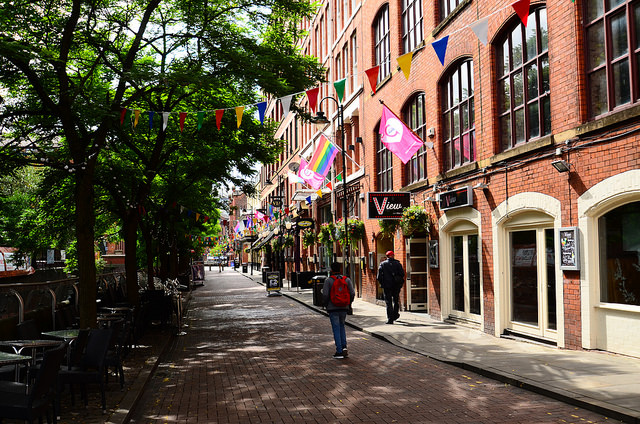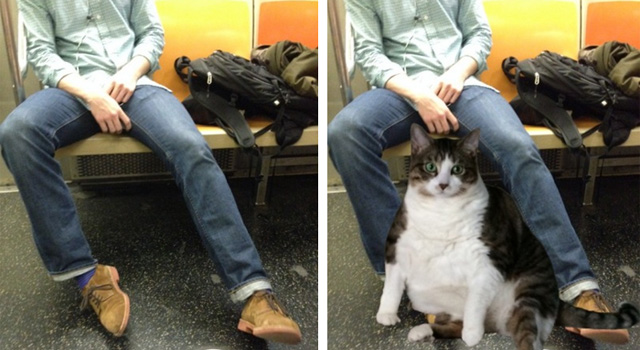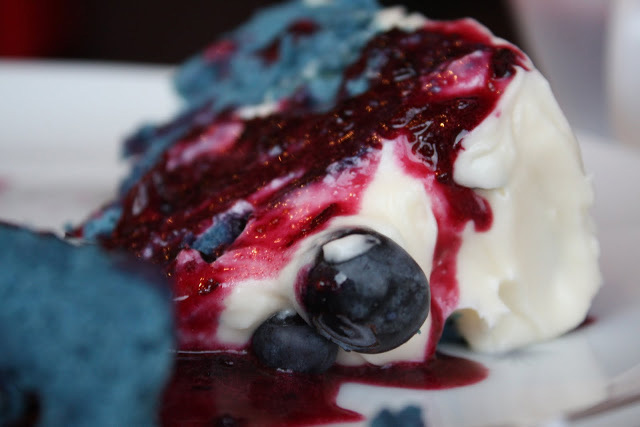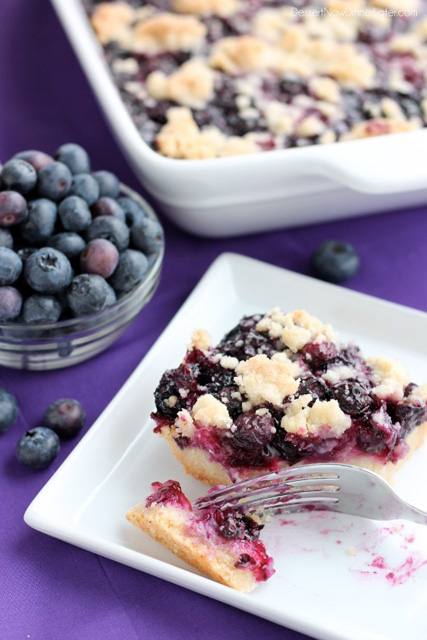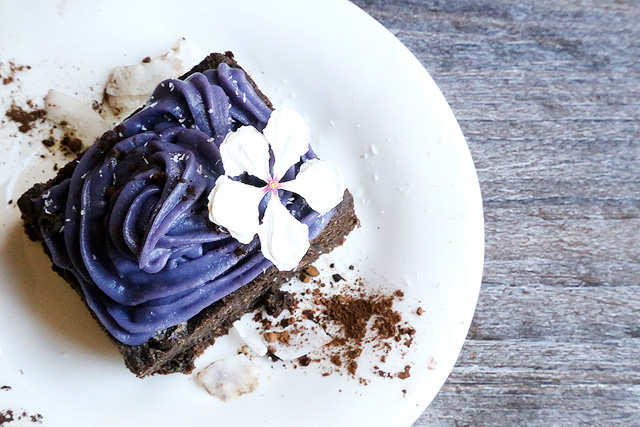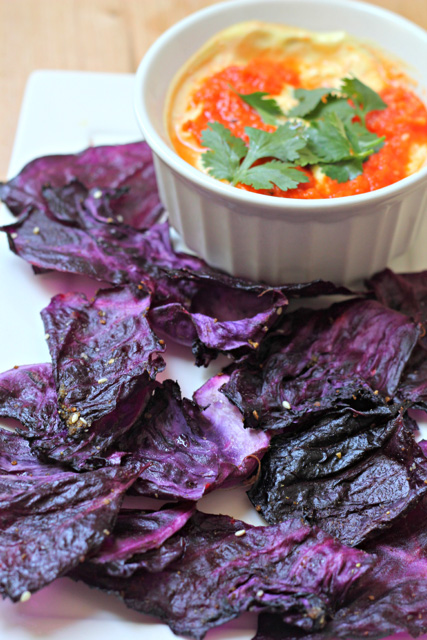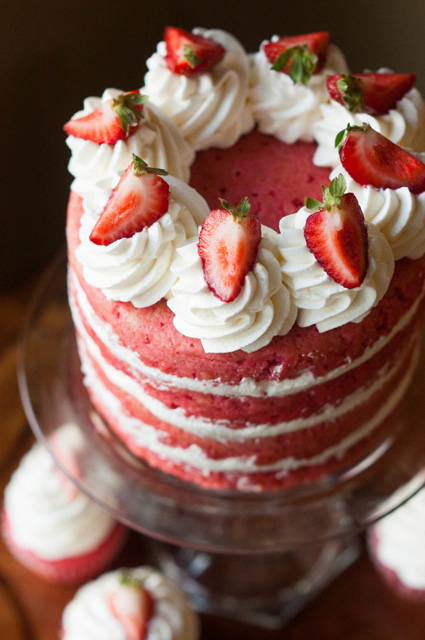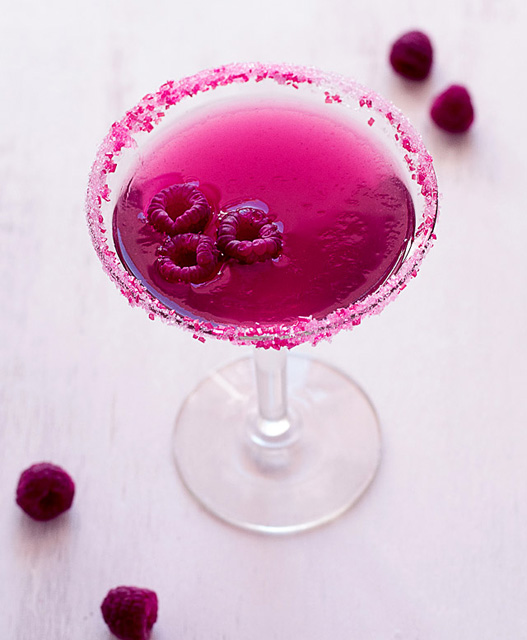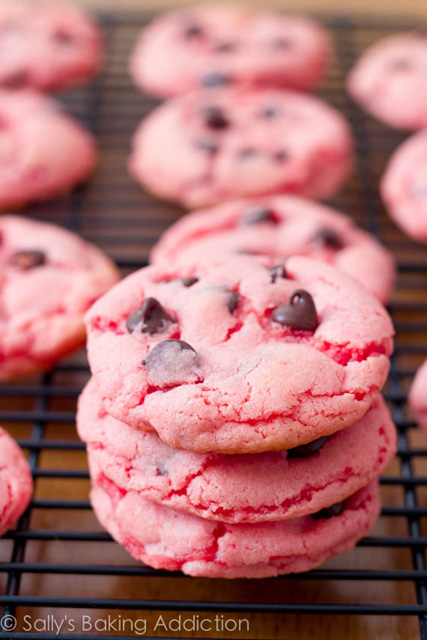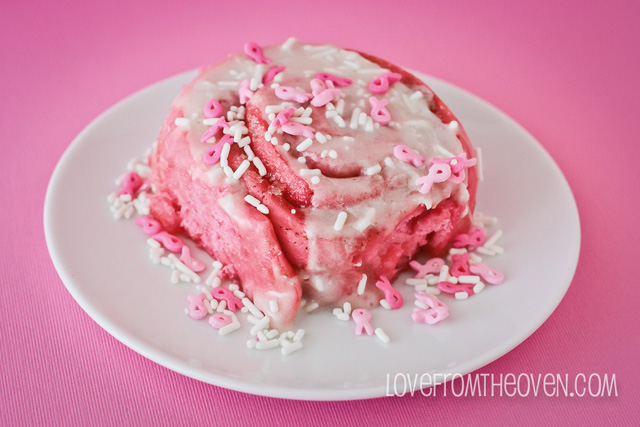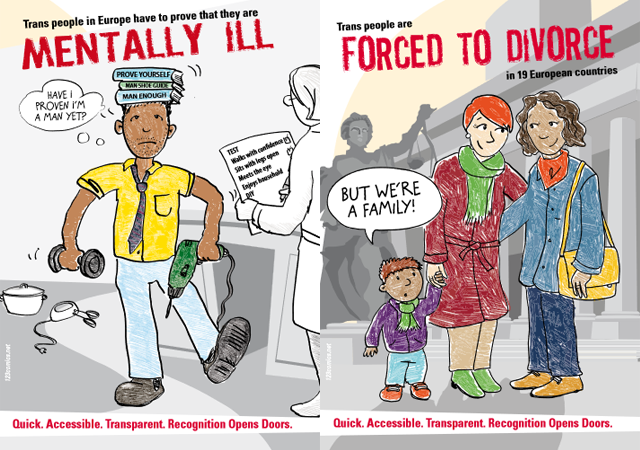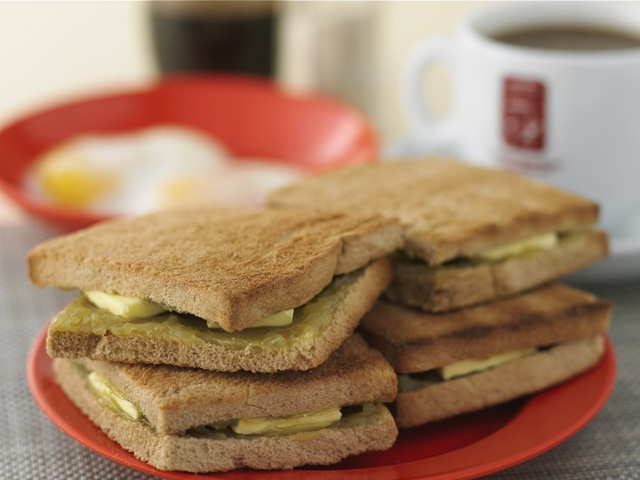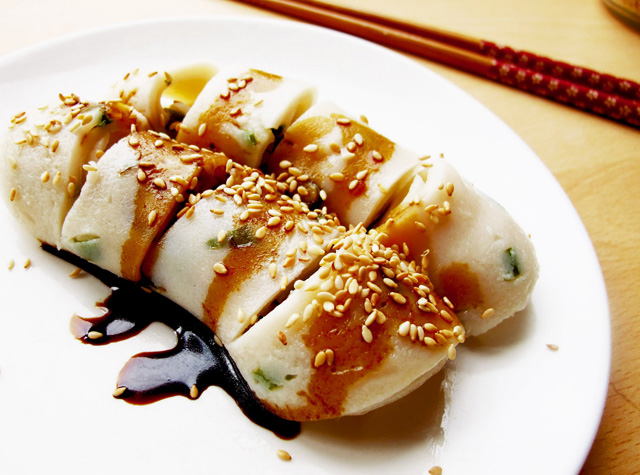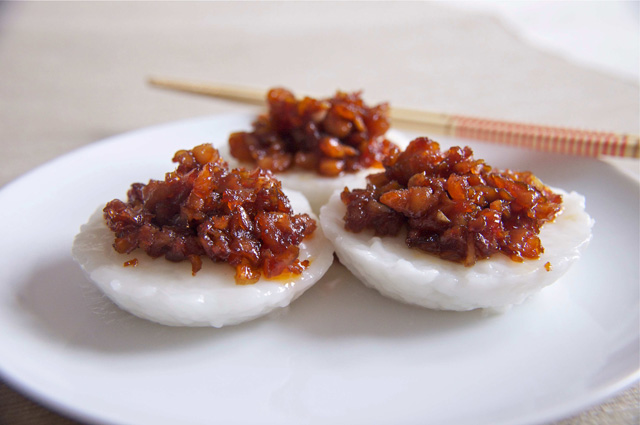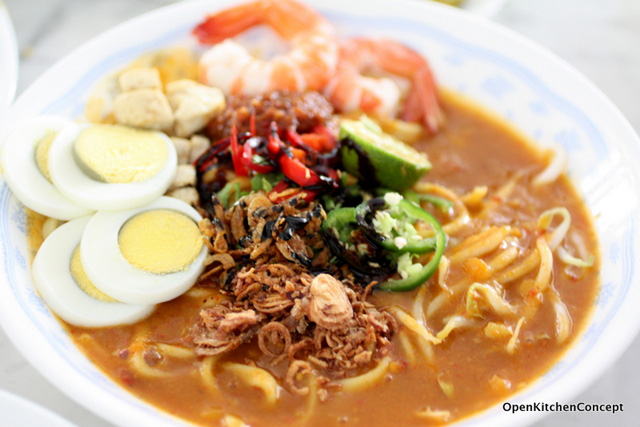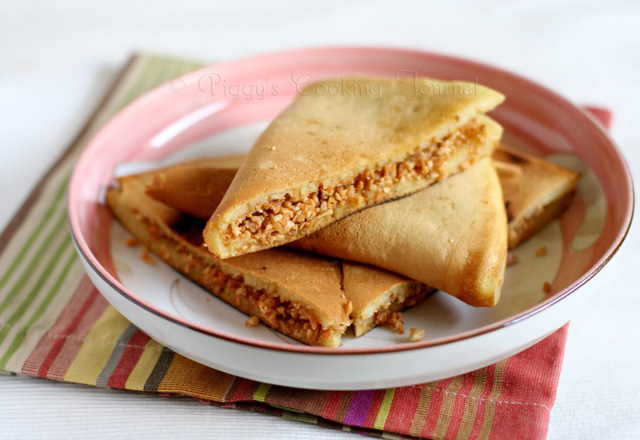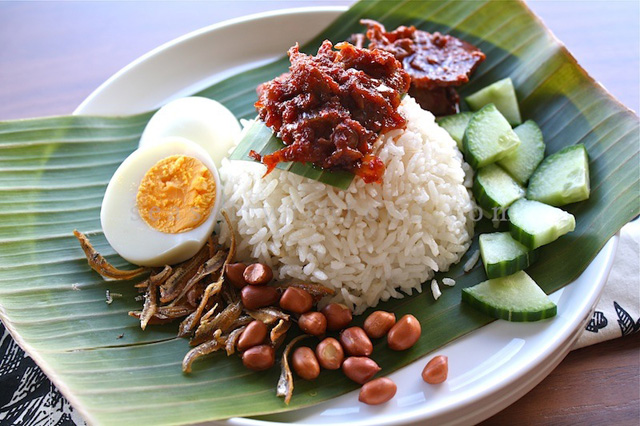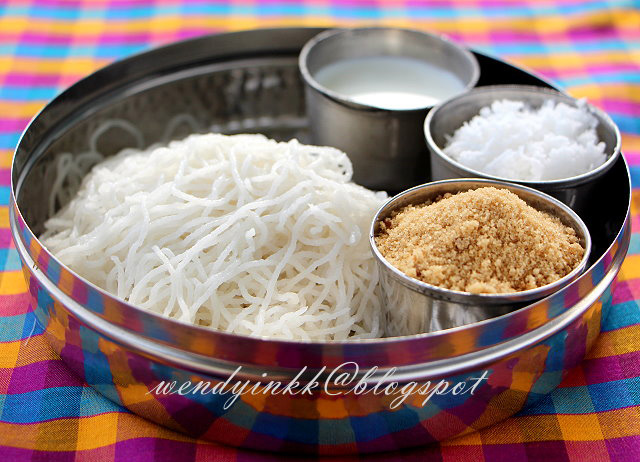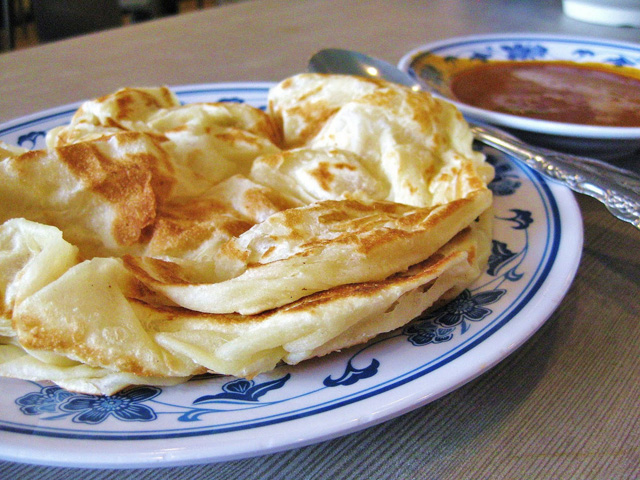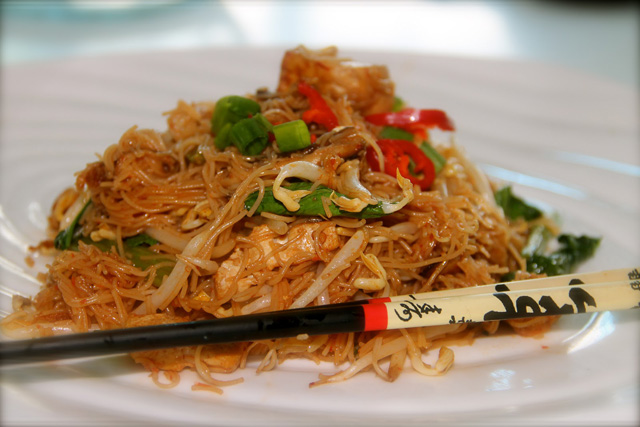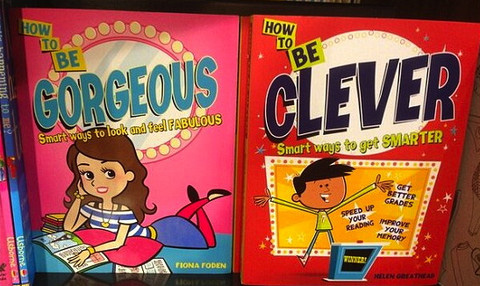Singapore 6/9: Come Hang Out at the Library
Venue: Pelangi Pride Centre
One Commonwealth, 1 Commonwealth Lane, #02-02
149544
Singapore
Event Date: June 9, 2018
Start Time: 2:00 pm
End Time: 6:00 pm
Host: Fikri Alkhatib
Description: Have you ever thought “man, I wish I could meet other queers but also leave open the option of retreating to the corner with a book”? I gotchu, my dude. I’ll even make that book queer for you.
Choose your own meet-up adventure this Saturday @ Pelangi Pride Centre, where you’ll be free to socialize or not-socialize with other queer folks in Singapore’s only LGBTQ community library. You can do all your regular library stuff — read & borrow* books, scroll through your phone, study for the O-levels — but because we queers do it better, feel free to also bring games and food** and your best awkward conversation.
No RSVP or $$ required! Come by whenever and with whomever. I’ll be there the whole time so it’ll be at least a meet-up of two. I’m nothing if not the host of the most happening events in town (“town”).
- Book loans are free but we do require a $10 deposit, so remember to bring cash if you want to do this.
** I trust you’ll use your discretion in deciding what to consume in an enclosed, carpeted space. But I also welcome any offers of durian after 6pm.
*** Can’t make it this Saturday? PPC is open every Saturday, 2-6pm (though it’ll be closed on 16 June for Raya). It’s definitely worth a visit if you haven’t been.
Accessibility Info: PPC is within walking distance of Commonwealth MRT, and the route is mostly sheltered. Access to the second floor is via lift and the entrance is step-free.
RSVP: https://www.pelangipridecentre.org
No RSVP required, but if you’d like to get in touch e-mail me at [first name][last name] at gmail dot com and I’ll pass you my phone number. The “RSVP” link is for more info on PPC.
How to Stop Biting Your F*cking Nails
In my mind, there’s a clear image of when I started biting my nails: I’m young, maybe 9 or 10, seated on top of a staircase while a gathering of some sort goes on without me in the living room below. I notice my nails are long enough to get me into trouble at school but my mother guards access to the clippers. Too nervous to ask for help, I nibble a little. Then I bite harder and I get into it, and I don’t stop. It all goes downhill from there.
Now all of this is bullshit. I’ve never lived in a house with stairs in them, and my mother would not appreciate the characterisation of her as a careless caregiver. (She was the exact opposite.) I may have picked up the habit somewhere around that age, but at 23 I can longer explain it away as the product of a child’s weak will and bizarre rationality. Still, this persistent image of myself as an anxious, isolated child probably speaks volumes about how deeply rooted nail biting is as a habit in my life.
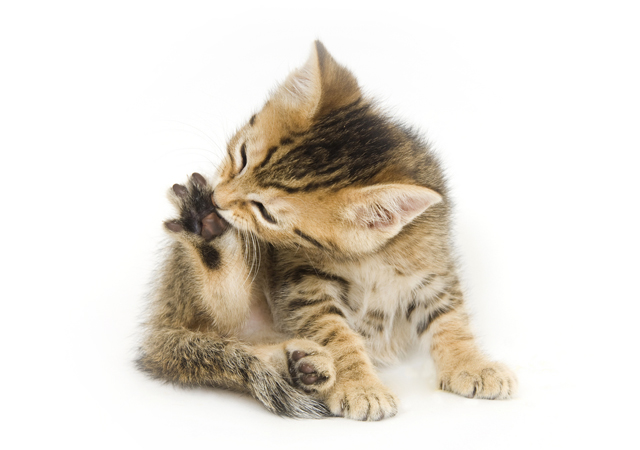
G-d bless stock photography for allowing me to illustrate this in a way that doesn’t betray how grotesque nail biting really is.
via Shutterstock
Which is all just to say that I get that it can be really, really hard to stop biting your nails. I don’t want to be ripping off and consuming bits of my flesh in the middle of an exam or a meeting, and neither, I suspect, do you. I’m well aware that it’s gross and may lead to well-documented horrors (you know where that link leads, click at your own risk). But even — maybe especially — as a grown-ass adult, nail biting can be an impossibly difficult habit to kick.
My last “relapse” happened when I was buried a couple of feet under the pressures of grad school. I resolved to stop (again) when the pain was making it difficult for me to do things. Here are some tips that I’ve found make the process a little easier.
1. Have A Plan
You’re gonna do this thing! I believe in you. Now how are you gonna do it? Are you working towards something, like getting a manicure done before a wedding, or just generally looking to improve yourself as a human person? What will you need to help you along? When do you want to start? If you’ve been waiting for a sign that it’s time to stop, this post is it.
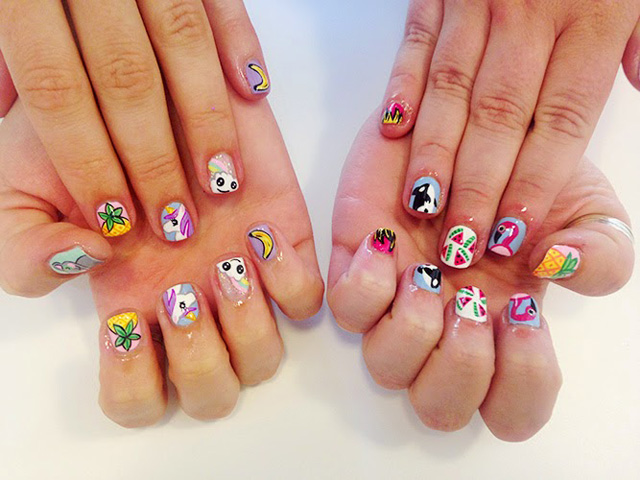
Think of your nails as a potential canvas. Now STOP EATING THE CANVAS.
via iwanttobeher.com
What’s worked best for me is stopping gradually — first leaving the nails on my right (dominant) hand alone, then cutting back one by one till I’m just down to one maligned finger, then stopping entirely — and not putting a time limit on it, because I know from experience that I rarely make straightforward, linear progress on this. Think about what might work best for you, but quite importantly, be prepared for your plans to fail. Chances are trying to stop nail biting is going to make you more stressed and anxious for a bit, making you want to bite your nails even more, so don’t give yourself a hard time if it takes multiple tries for you to figure out an approach that works.
2. Identify Triggers
Most people bite their nails when they’re anxious or bored. Take the time to really pay attention to what you do and you might be able to narrow it down to more specific triggers. For example, I often find myself biting my nails when I’m writing or typing (i.e. procrastination) or when I’m waiting for webpages or games to load because I’m a spoilt-ass millennial. I’m also way more likely to bite my nails if they’re already rough or broken, exacerbating the problem.
3. Change Your Behaviour
Knowing when and why you bite your nails isn’t necessarily gonna be enough to stop you from doing it. I’ve definitely found myself fully conscious of my fingers between my teeth and still found myself either unwilling or unable to stop. Sometimes you need a physical reminder to snap you out of it, like a rubber band around your wrist you can snap whenever you catch yourself biting your nails. Alternatively (or additionally), you can:
3a. Make Nail Biting More Difficult Or Unpleasant
Putting stuff on my nails that makes it harder to actually physically bite them, whether I’m conscious of doing it or not, is by far the most effective quitting method I’ve found especially when you’re just getting started. Things I’ve tried with varying levels of success include:
Regular scotch tape: Don’t do it.

Unfortunately I did it, circa 2008.
Paper surgical tape: Far more durable than scotch tape (though it’s still not gonna last more than a day or so) and a cheap solution. It’s gonna be really obvious you have tape on your fingernails, which is good for reminding you to Not Do The Thing but bad if you’ll feel self-conscious about it.
Cotton gloves: I found these particularly useful at night when I’ve slathered on moisturiser and didn’t want to find myself absentmindedly chewing on my nails before I went to sleep. You can still do most things in them, including operate touchscreens. (Also, your regular gloves, the ones you wear out when it’s cold? They’re probably the filthiest thing in your wardrobe. Think of that the next time you put your fingers near your mouth.)
Nail polish: Look at how great Contributing Editor KaeLyn‘s doing!
https://instagram.com/p/6ycoObM7ph
I haven’t had the same success — I pick at even the slightest unevenness in a manicure, and you can bet my still-healing nails were plenty uneven — but colour polish can be a great visual reminder to stop yourself from biting, while a strong transparent top coat can make it tougher for you to do so.
Nail biting treatment solution: This is a clear, bitter liquid that you apply onto your nails. The bitterness lingers a little even after you try to bite them and is thus a pretty effective deterrent, but I’ll admit I had to change brands a couple of times because I got used to the taste/just stopped caring about it.
Acrylic fake nails: Probably the most expensive and time-consuming solution, but it works for me without fail every time. I put on fake nails even when I’ve (mostly) stopped biting my nails if I know a particularly stressful period is coming up, like essay season. But again I gotta confess that once I chewed through even the acrylic when I was working on my thesis.
3b. Develop Alternative Habits
Think of something else you could do with your hands/mouth instead of biting your nails. Now scrap that thought, and think of something you could actually do in polite company.
Some of the alternative habits I’ve cultivated have been productive or at least harmless, like playing with my necklace, while others considerably less so, like compulsively checking my phone or that one time I started finishing a pack a day… of orange Mentos. Take better care of your nails! Whenever I find myself wanting to bite my nails in public, I rub Burt’s Bees lemon butter cuticle cream on them instead, and at home I have gotten cuticle trimming down to a therapeutic art. (Trimming your cuticles is bad for you, but I can say with a fair amount of certainty that eating them is probably worse.)
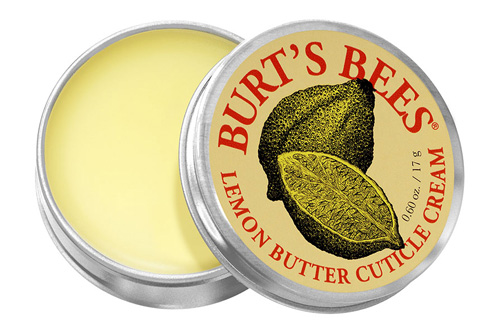
This stuff smells good enough to eat… but we’re not doing that anymore, no.
Going back to triggers, it helps not only to find alternatives to nail biting but to tackle the problem at its root: look for ways to reduce your stress, anxiety, or boredom. I’ve recently taken up cross-stitching, because few things occupy my hands and restless brain better than sewing “MACHO” in a pink flowery font. You do you, whether it’s yoga or Netflix marathons.
4. Hold Yourself Accountable
Print out a small calendar, pin it somewhere you’ll see it often, and mark each day you manage to go without biting your nails. I enjoy being able to physically chart my progress but of course there are plenty of apps that’ll do the same; I like Good Habits for its simple, straightforward interface. If you’re a bit more hardcore, you can try something like Beeminder or 21 Habit that’ll charge you if you go off track. What’s currently working for me is Habitica (formerly HabitRPG), recommended by Autostraddle’s Tech/Geekery Editor Ali, in which I’ve listed “stop biting nails” as a habit so every time I do it my pixelly avatar takes a hit. I really don’t want the little guy to die.
Get people around you on board, too! Ask your friends to point it out or smack your hands when you’re about to put them to your mouth; ask your girlfriend to yell “those fingers aren’t going anywhere near me!” every time you do the same. Visit a professional manicurist, if you would like to be reprimanded by a stranger about how you’re treating your body.
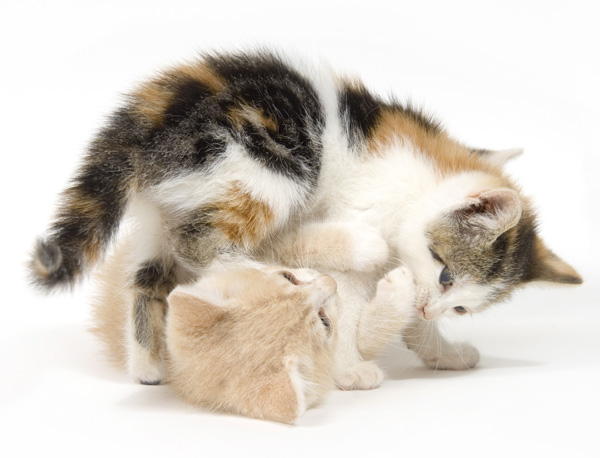
THIS IS FOR YOUR OWN GOOD
via Shutterstock
Full disclosure: I hate when people do this, because I am That Person who will do more of what she is told not to. So if you’re like me, make clear to those around you that it hurts more than helps if they police your nail biting.
5. Seek Professional Help (If Necessary)
If you’ve tried everything and it doesn’t work, or if you’re just too overwhelmed to even try, consider seeking professional help. Nail biting can be a symptom of something more serious, and it’s okay if you don’t have it in you to deal with it yourself! I know it feels like a trivial thing to go to a therapist or psychiatrist for but you guys, there is a world in which your nails do not bleed onto paper and you don’t want to cry from how much it hurts to do anything with your hands (which is a lot of things), and it is a world you could most definitely come to live in in time. You deserve all the care and help you need to get there.
Any other tips? Share them in the comments!
The Best Mirrorless Cameras Ever
Welcome to The Best Ever series, where Autostraddle team members recommend their favorite things. Today, Aja, Fikri and Audrey are talking about mirrorless cameras.
Doesn’t your hair look great today? Maybe you should take a picture. (Okay definitely take a picture. Maybe share it!) Here at Autostraddle dot com we’d love to see more fancy cameras dedicated to documenting even fancier queer lives and faces, so let’s talk about compact system cameras (CSCs).
CSCs — or mirrorless interchangeable lens cameras (MILCs), or digital single lens mirrorless cameras (DSLCs) (yeah no one really thought this through) — are a growing part of the camera market, usually sold as a middle ground between point-and-shoots and DSLRs. The main difference between CSCs and DSLRs is that mirrorless cameras do away with well, mirrors. In DSLRs, mirrors and prisms inside the camera body flip up/down to alternate light between the viewfinder (which you look into) and image sensor (which captures the image). Without these finicky moving parts, CSCs tend to be smaller, lighter and more durable, especially since manufacturers sometimes also strip away other features that we expect on DSLRs, such as viewfinders, built-in flash, hotshoes (for attachments), hand grips, and dedicated button controls.
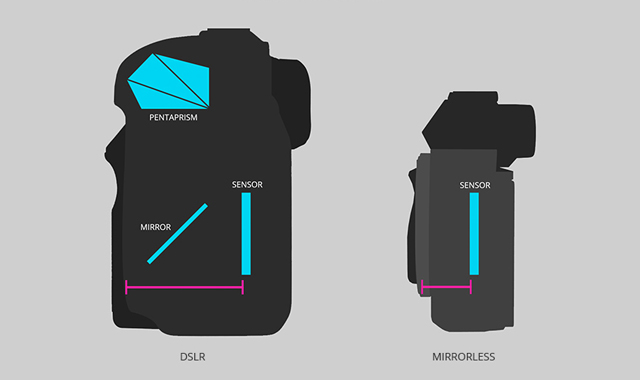
via B&H Photo Video (click through for a more comprehensive comparison among camera types)
On the other end of the spectrum, CSCs are a step up from point-and-shoot or smartphone cameras because they usually have larger image sensors (meaning better quality, less grainy photos) and come with the option of interchangeable lenses for vastly different end results.
Possibly one of the most alluring — and confusing! — things about CSCs is the wide and continuously expanding range of cameras that fall within this category: from the compact, lightweight Panasonic LUMIX GM1, which fits into your pocket as easily as a point-and-shoot, to the full-frame Sony Alpha A7 Mark II, which rivals some of the most high-end DSLRs in the market today. To help you along, we’ve rounded up Autostraddle team members to tell you about their favourite cameras and lenses and why they love them.
Aja, Beauty Editor
Panasonic Lumix DMC-G1
For eight years I’ve photographed my outfits (and increasingly, my life) for the style blog I started in 2008. Fit for a Femme was launched using a Sony Cybershot that was quickly replaced with a then brand-new Panasonic Lumix DMC-G1. Hesitant to take on the bulk of even an entry-level DSLR, I took the plunge in the hopes that I could bring more beautiful, quality images to the site with the G1.
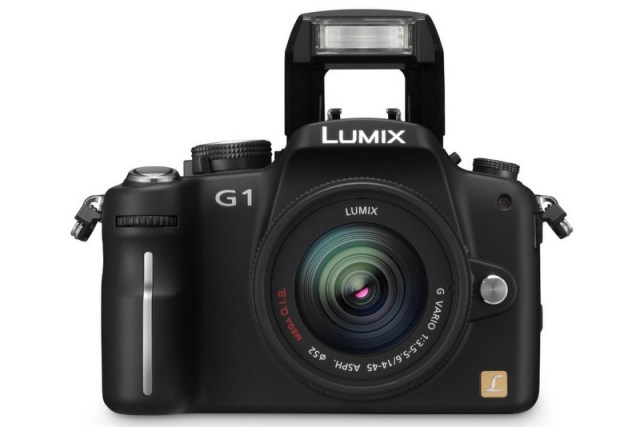
My G1 and I got on beautifully for an impressive five years. The change was like night and day! My photography steadily improved, and so did my style. Acquiring a new lens every other year or so kept me happy and growing as an amateur; I went from the kit lens to a fairly silly (for my purposes) Panasonic Lumix G X Vario PZ 45-175mm f/4.0-5.6 zoom, and settled on a do-it-all Panasonic Lumix G 20mm f/1.7 prime. Tiny, bright, quick and ultra-sharp, the 20mm (and its ability to generate a pleasing enough bokeh) allowed me to hang on to the G1 a while longer, even though I’d outgrown it.

Panasonic DMC-G1 with 14-45 mm f/3.5-5.6 ASPH Mega OIS Lens
In late 2013, I started to become restless. My home base had changed from California to Boston, both my standards and the photography landscape had shifted dramatically and I knew I’d hit a wall with the G1. Having so much more control over the photos I took was liberating and challenging; every time you pick up a new body or a new lens, there’s a learning curve or exploratory period while you get familiar with stuff; muscle memory in getting used to the physical controls and EVF of the camera’s body, how your own body moves to shoot with primes especially, and going through the motions of experimenting with light sources and shooting conditions.
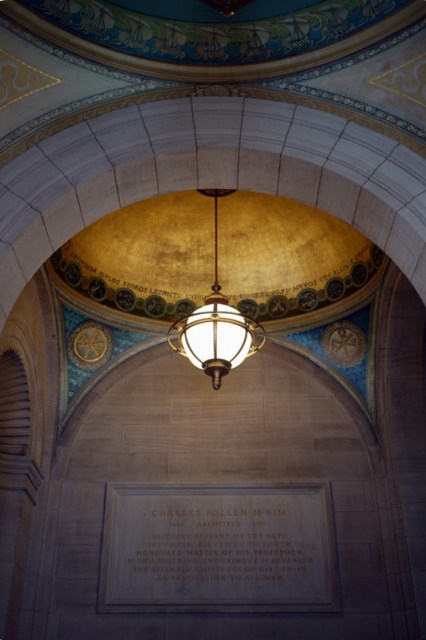
Panasonic Lumix DMC-G1 with Panasonic Lumix G 20mm f/1.7 Lens
Going from a point-and-shoot to the G1 was a great big eye-opening step up, but only that. I couldn’t push the G1 any harder, and the time had come to take the next step up to a semi-professional DSLR.
Sony a7
My priorities were still shooting lifestyle, close-up, and travel photography, and size-wise, I wanted something inconspicuous enough for special occasions or day trips around New England. A gentle learning curve was important, too. FFAF hasn’t got a professional photographer behind it, so the new camera needed to be something that both my wife and I could handle — neither of us are pros — and she’s often the one pressing the shutter button.
I researched the Canon EOS 70D and Nikon D7100, pestered my exceptionally talented photographer friends for advice and dutifully spun my wheels at sites like Snapsort (for specs) and CNET (for reviews). In person, though, I found them to be all clunky and alien, even ones well outside my price range (which I tried just in case leveling up might help — it didn’t). So I fell back on more advanced mirrorless ILCs thinking they’d be a bit more familiar, giving the G1’s very grown-up older sibling, the handsome Panasonic Lumix GX7, a shot. Awesome, but not “the one.” Same with Sony’s respectable NEX range (specifically the NEX-6 and NEX-7).
It was not going well, superfriends.

In the middle of all this research and test-driving, there was a huge fuss over Sony’s a7 and a7R cameras but the price tag on the bodies alone shoved them off my list (and never mind tacking on the added cost of a really great lens). On a bitterly cold but blindingly sunny February day at Hunt’s in Cambridge, my wife blithely suggested I try one out, “You might as well while we’re here.” Y’all, that is the camera equivalent of taking me to a big old farm, leading me to the best horses in the barn and saying, “You might as well hop on and take him out for a trot.” Be prepared to drive off with a horse, okay?
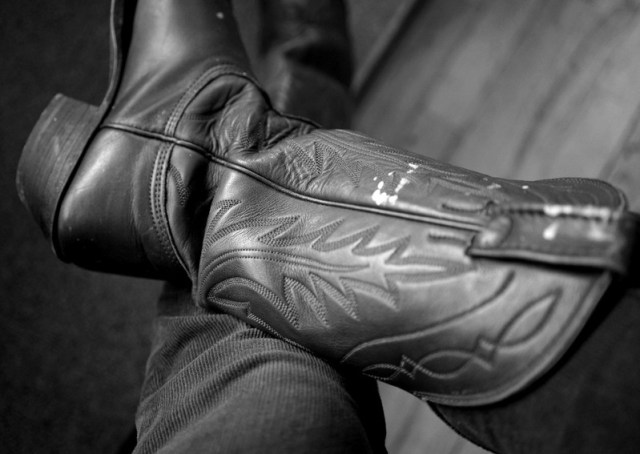
Sony a7R with FE 35mm F2.8 ZA Carl Zeiss Sonnar T* Lens
What do you think happened? I was an absolute goner the second I laid hands on the Sony a7R. Paired with the FE 35mm F2.8 ZA Carl Zeiss Sonnar T* lens, I got actual butterflies. I melted, I swooned, I went on and on about how it felt like an organic extension of myself.
Here’s the thing, though: It was the most sophisticated camera I’d ever held, but I still felt capable and competent using it right away. That was a big deal! There were minor drawbacks — shorter battery life, a less limber flip-out screen, overall heft — but its specs blew the G1 out of the water, set it proudly alongside the DSLRs I was considering, and might as well have clucked a “bless your hearts” at everything else on my list. I ended up saving hundreds by choosing the Sony a7, which is a bit lighter than the a7R, with superior autofocus, and when choosing a prime (I’d learned enough to know not to bother with a kit lens), I opted for the stunning FE 55mm F1.8 ZA Carl Zeiss Sonnar T* lens.
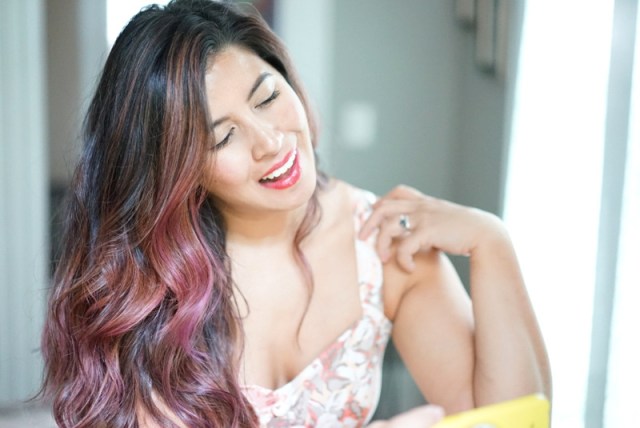
Sony a7 with FE 55mm F1.8 ZA Carl Zeiss Sonnar T* Lens
Why that lens, instead of the 35mm I tested? Excellent question! Try double the focal length, snappy autofocus, greater depth of field control, and bokeh so buttery it’d make a Berkshires jersey cow cry. The Phoblographer described shooting with this lens best:
Step 1: Mount.
Step 2: Aim.
Step 3: Focus.
Step 4: Photograph.
Step 5 is “Ogle” because this lens produces truly beautiful results.
Sony utterly changed the MILC game by releasing two (two!) full-frame cameras under $2K to compete with hotshot DSLRs at similar price points, especially when competing Leica models start at $6K. Two years later, there are now five full-frame cameras from Sony that allow use of pretty much every make of 35mm lens using adapters, and one of them — the pricey a7RII Fikri mentioned — has killer autofocus that plays nice with any Canon lens built after 1995. That is potentially groundbreaking.
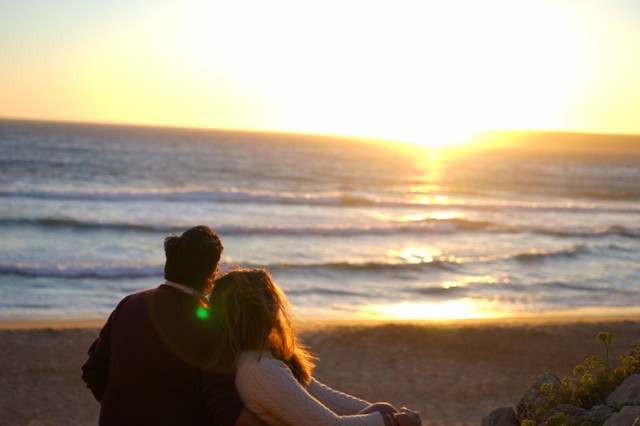
Sony a7 with FE 55mm F1.8 ZA Carl Zeiss Sonnar T* Lens
Eighteen months later, and I’m still head over heels excited about the images I’m creating. Plus, something unexpected has happened — instead of trying to push my camera to do more, it actually pushes me to do more; to be better, to learn everything I can, to handle its power and sophistication with real proficiency. I’m constantly aware that I need to make more time to explore it and do it justice. There’s a whole world of adapters and lenses, vintage and new, to discover! It’s a lot of camera, the kind that takes awhile to master, and it makes me want to work harder.
If you’ve graduated from point-and-shoots, have outgrown your MILC or want to switch teams (more and more DSLR users are jumping ship, it’s a thing), something from Sony’s a7 range might be a brilliant choice for you, too!
Note on lenses: I bought a very well-reviewed, more compact Sigma 30mm f/2.8 lens for a recent trip abroad. They’re known for making fantastic, affordable lenses, and I wanted to love it. We took it out on our first day in Lisbon, but that was it. I couldn’t wait to throw the 55mm back on.
Fikri, Writer
Olympus OM-D E-M10
Last summer, my DSLR was stolen during my one and only trip to a Nando’s while I was tending to an exasperatingly fussy 8-year-old. I considered giving up photography altogether — my enthusiasm for the hobby had long been fading, anyway — but then after just two days with only my mother’s point-and-shoot to document my last few days in London I just couldn’t. I couldn’t! So after researching my options obsessively I settled on the Olympus OM-D E-M10 because it cost less than what I would have spent on a mid-range DSLR (the Nikon D7100, to be exact), and… I liked how it felt in my hand. Yup. I spent ages reading and comparing reviews only to be suckered by good looks.

Lugging around a DSLR with bulky lenses gets old fast, especially when travelling, and I really like that the E-M10 fits all the features I’m used to on a small, solidly built body. I especially like the two customisable command dials, which make it significantly easier to simultaneously adjust aperture and shutter speed, as well as secondary settings like ISO and white balance. The only button that’s kind of in a weird place is the power switch at the bottom right of the back panel, which sometimes gives me pause when I want to switch the camera on quickly to catch something.
I’ve also become surprisingly partial to its built-in wifi, which allows me to transfer photos directly to my iPhone and also use said phone as a remote shutter (with live preview!). I’m notoriously slow when it comes to processing and uploading photos — mostly I just hoard them in Aperture, and I will continue to do so even as the app heads to its slow, inevitable death — so this feature allows me to more quickly appease Instagram-conditioned family and friends who need to see results right there and then.
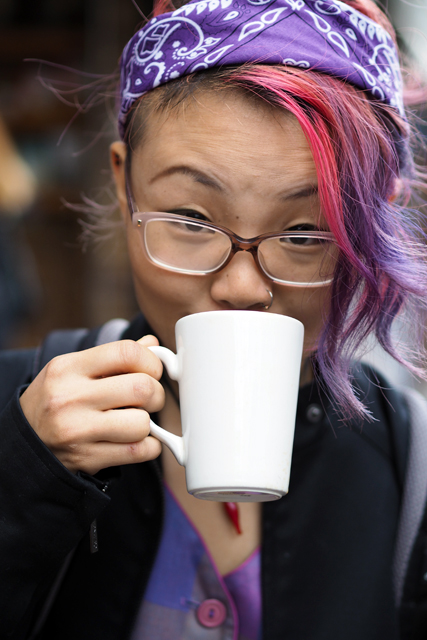
Olympus OM-D E-M10 with Olympus 45mm f/1.8 lens
The final sell for me was that compared to other brands’ more restrictive systems, Olympus bodies are compatible with both Olympus and Panasonic lenses as well as a few others under the Micro Four Thirds system. (Though do note that Olympus builds image stabilisation into its camera bodies while Panasonic builds it into its lenses; this means a non-image stabilised Olympus lens might fare more poorly when paired with a non-IS Panasonic body.)
My camera kit came with an Olympus M. Zuiko 14–42mm f/3.5–5.6 EZ lens, which is a nifty, super slim lens that makes the E-M10 even more portable. Unfortunately, I can’t comment much on using it because I retired it quickly in favour of faster prime lenses, which work better in low light conditions and give shallower depth-of-field. I initially bought the Olympus M. Zuiko 45mm f/1.8 lens because it was cheaper in-store but later got the Olympus M. Zuiko 25mm f/1.8 lens. The performance of both these lenses is comparable, so in the end it’s down to which focal length you’re more comfortable with: the 45mm (35mm equivalent focal length: 90mm, with a 2.0 crop factor) is great for subject isolation (portraits) and outdoor photography with faraway subjects (concerts, parades), while the 25mm is a standard “normal” lens that most closely mimics what humans naturally see. I chose the latter.
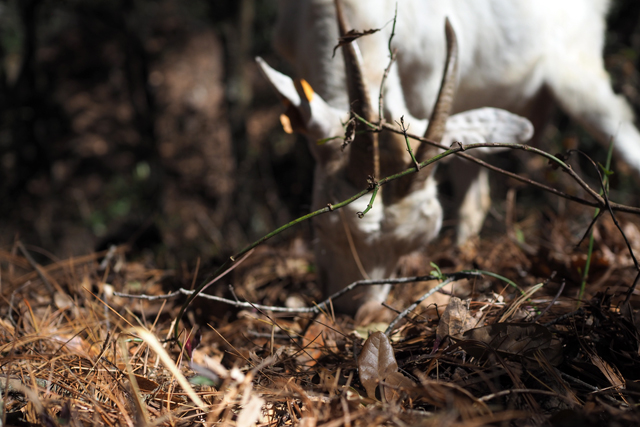
Olympus OM-D E-M10 with Olympus 25mm f/1.8 lens
The camera’s only drawback is that its autofocus is noticeably slower than that of my old DSLR, which is important to me because I take a lot of photos of squirmy, hyperactive small humans and animals. This is mainly because the E-M10 uses contrast instead of phase detection. I’m considering upgrading to the Olympus OM-D E-M1, however, and overall the gap between the focusing speeds of CSCs and DSLRs is generally closing anyway.
Audrey, Contributing Editor
Panasonic Lumix DMC-G2

This is the slightly updated version of Panasonic’s G1, which Aja reviewed above. The next model in the line is not so different. (The latest one is the Panasonic Lumix DMC-G7.) We even mostly use the same lens, the Panasonic Lumix 20mm f/1.7 prime lens. It’s not a great camera, but it’s a good one. I don’t love it, but I really like it. For more than two years, it has done everything I needed it to, and done it wonderfully. I got the G1 right before I moved to Nicaragua on a trade-in for my Olympus PEN E-P1. I’m not a photographer, and I don’t really aspire to be one. I take pictures for my work as a non-profit communications manager, and I take a lot of pictures during my travels in Central America. The camera is compact, has a great grip and doesn’t scratch easy, which have made it ideal for hauling around on chicken buses and hanging off of rickety wooden barriers with. After two years of rough-and-tumble use, it still looks and operates like it did when I bought it.
My favorite thing about the f/1.7 lens is its easy and beautiful manual focus option. The 14-42 mm kit lens that comes with the camera does a nice job too, but if you want to get really up close and personal with a subject or add rich texture to photos without too much fuss, a prime lens will be your baby.

Panasonic Lumix DMC-G2 with Panasonic Lumix 20 mm f/1.7 lens
The camera has pretty intuitive manual settings, but I leave it on auto as often as not. I mostly take photos in outdoor settings with great natural light, but this camera and lens combo also thrives in low and weird light situations.

I’ve never used a camera that made me feel confident taking pictures at dusk, but this one captures layers of light and shadow like a champ.
Panasonic Lumix DMC-G2 with Panasonic Lumix 20 mm f/1.7 lens
If you need or want higher quality images than a point and shoot can offer but don’t feel confident as a photographer or want a camera that makes it feel easy to learn, I highly recommend Panasonic’s Lumix series. As Aja said, a passionate photographer will outgrow this camera quickly. But for day to day and even low-level professional use, it’s a great option.
Here are a few more cameras you might want to consider:
- Casual: Samsung NX3000 / Olympus PEN E-PL7
- Prosumer: Fujifilm X-E2 / Sony a6000
- Enthusiast: Fujifilm X-T1 / Panasonic Lumix DMC-GH4
Do you have other recommendations? Share them in the comments!
We’re All About It: Step Up Your Hot Beverage Game With A Variable Temperature Kettle
Welcome to We’re All About It, where we talk about investment-worthy things that are going to make your adult lives 100% more amazing.
No matter our differences, what unites us all is our intractable dependency upon caffeine, no matter its form. It’s what defines most of our mornings, many of our afternoons, and sometimes our evenings (or early AM hours). Give yourself the gift of perfectly steeped and/or brewed caffeinated beverages today, and thank yourself for it forevermore.
FOR TEA: Cuisinart CPK-17 PerfecTemp 1.7-Litre Kettle
by Fikri
When I moved in with former Hot Intern/Editor Laura Wooley — otherwise known as Queen of All Things Craft and Cooking — last year, I was amazed at how well stocked her kitchen was for a grad student: full spice rack, pizza stone, and some pumpkin-inside-scooping gadget. (I was openly skeptical of the last one so she went out of her way to demonstrate its usefulness. I’ll concede it facilitated a delicious quinoa-stuffed butternut squash situation.)
Y’know what she didn’t have though? An electric kettle.
I soon learnt that this was a common phenomenon among USAmericans, which was as curious to me as ads for lawyers on the subway and the lack of on/off switches on wall sockets. The student halls I lived in in London had a morbid fear of fires — the city’s only burnt down a couple of times, after all — so we had regular fire drills, pain-in-the-ass fire doors along every corridor, and an enforced ban on smoking and most electrical appliances, but not kettles. Never kettles. When you move in you’re given an ethernet cable and a cheap plastic kettle, because surely that’s all a student could ever need.
Anyway, here I was, newly arrived in New York City with 20-odd varieties of tea (amassed over three years’ worth of winters), and the thought of boiling water on the stove and taking manual temperature measurements each time I wanted a cup of tea (which is often) didn’t quite appeal to me. So I got the wifi password, set up my bank account, and used my unexpected kettle-less existence as an excuse to order the variable temperature kettle of my dreams.

HAY SEXY LET ME HAVE YOU DELIVERED TO MY HOME
There are a lot of variable temperature kettles on the market, but I settled on the Cuisinart CPK-17 PerfecTemp 1.7-liter Kettle for two main reasons: first, it’s stainless steel, which is hardier than plastic and easier to clean than glass, and second, it works. It actually reaches the temperatures it says it does by slowing down the boil when it approaches the target temperature. (Other kettles might go to a straightforward boil then allow the water to cool, which can be similarly accurate but slower.)
The CPK-17 is marked with six temperatures: 160º (Delicate), 175º (Green), 185º (White), 190º (Oolong), 200º (French Press), and Boil (Black). There are other kettles that allow you full manual control over the temperature, but this wasn’t important to me as a tea-drinker because these options encompass the full range of temperatures that I require. More importantly, I’m Fahrenheit-illiterate, and tea requires more precise measurements than the rough Celsius-to-Fahrenheit conversion I do in my head for the weather.
Could I really justify shelling out for something that essentially just boils water though? G-d, yes. This kettle is the first fancy-ass kitchen appliance I’ve dared to treat myself to and it was worth every cent, you guys. I’ve started drinking a lot more white and green tea, which is good for both my sleep cycle and taste buds, as well as more tea, period, which was probably the main reason I didn’t just curl up in a corner and cry through all of my first (and thankfully, only) NYC winter. Leaving some lemony gunpowder to brew while I got ready to leave the house became part of my daily schedule, making morning classes on sociological theory that much more tolerable.
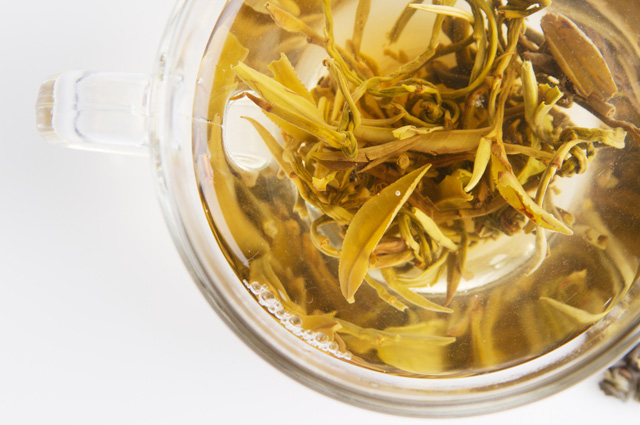
I don’t even know what life is like without perfectly steeped white tea anymore.
via Shutterstock
If you’re looking for other tea-related paraphernalia to complement this kettle, I like to brew loose leaf in bottom-dispensing teapots, which allow me to watch the leaves unfurl and are less messy than in-mug tea infusers. (Well mainly I like mine because my girlfriend bought it for me, but y’know.) And while I know there are cooler-looking dedicated tea tumblers, I’ll forever swear by insulated Klean Kanteens for their versatility and durability.
Price: $89.99
Good for: People who drink (non-black) tea regularly
Buy: At Amazon
FOR COFFEE: BonaVita 1-Litre Electric Gooseneck Kettle
by Natalie
I love me some good home coffee equipment. There are a handful of factors that stack up to reasonably consistent manual drip coffees at home: good beans, a good grinder, a gram scale, a thermometer, a reasonable filter method… okay, it’s a big handful, I have big hands. To up my manual coffee game I was looking for a kettle with a gooseneck spout to get closer to optimal deliciousness extraction, but was loath to spend much money on a pouring vessel when it would just add another step to the finicky coffee process.
So I thought I would spend even more money on a great electric kettle that could prevent laziness from getting the better of me by combining some of the abovementioned factors. I’ve had my eye on the BonaVita Variable Temperature Gooseneck Kettle since Clive Coffee had it up for preorder. At first I thought that it was not meant to be in my life because I could only find them in US stores and was convinced the voltage differences wouldn’t work out, making me lose money and a great kettle to lousy voltage converters. Fortunately, around the same time that I was visiting Fikri in London, I figured out that BonaVita of course sells kettles for the UK market which would work perfectly with Singapore’s power points! Alas, it was out of stock everywhere I looked in London, but I found one last unit in the warehouse storage of Dublin’s Coffeeangel. Because Fikri loves me (even though she is allergic to coffee), we bought cheap plane tickets to get me to the sexiest kettle ever.
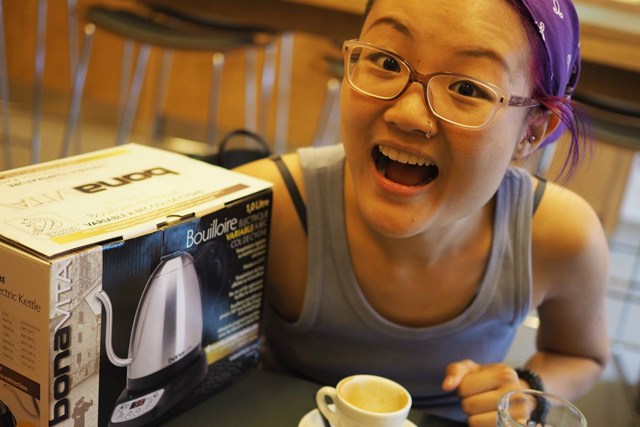
Oh, this thing? We only had to FLY TO IRELAND to get it.
This kettle heats water quite precisely up to your specified temperature, and holds it there until you’re ready to use it. The water reaches temperature quickly (four minutes or less*, enough time to grind two cups worth of coffee with a hand mill). The spout then enables you to pour like a badass; especially for pourover novices like me, this kettle is super forgiving. This is because it agitates the grounds with a thin stream for a more even extraction, so you can concentrate on where you pour more than how fast/slow you’re pouring**. The thinner stream also makes the pour more visually legible — the grounds give up coffee oils as you go, and you can compensate for an uneven pour if you notice less oils. It’s especially helpful on the bloom step where you need just enough water to saturate the grounds for a more even brew.
* Electric kettles work slower in the US because of the lower voltage, so you might get slower times.
** One of the key ways to get an even extraction in manually brewed coffee is to agitate the grounds thoroughly, and in pourovers this is most conveniently done with the force of the water hitting the coffee. You could always stir it in the filter, but that affects brewing temp.
I haven’t personally done a controlled pour/taste test, but my grounds beds in V-shaped drippers used to be concave and now they are a bit domed, which I take to mean that the extraction is gentler and more even throughout the bed of grounds. The slower pour rate also means that when I’m too lazy to time the brew, I approximate optimal brew time better than when I’m dumping lots of water into the filter at once. I can’t speak for how the spout or handle compare with other gooseneck kettles, but I can say that I haven’t found a more theoretically ideal kettle for pourovers.
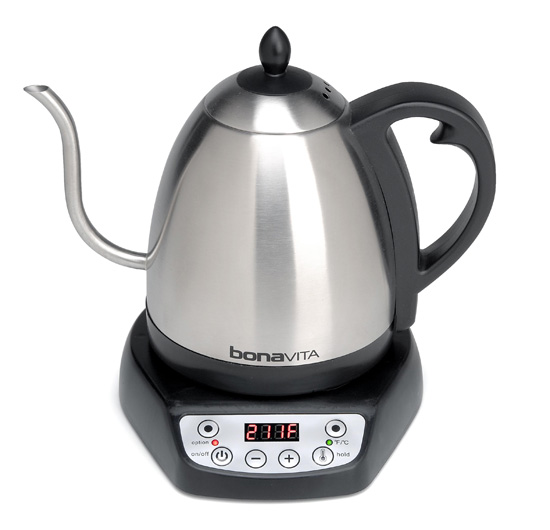
And have you seen it? It’s so beautiful, and so easy to fall in love with. The brushed stainless steel, 360º rotating base, swooping gooseneck spout… The digital temperature control is straightforward, easy-to-read, and remembers the last specified temperature along with six preset/user-set temperatures (for you tea snobs). If this kettle were a human being, it would be a high-powered, ass-kicking executive who is also a prima ballerina. I wouldn’t normally justify spending that much on a kettle that can do most things a regular kettle/thermometer set up can do, but it really did help me get from sub-par to good with little effort. Pair it with a Kalita Wave dripper, which seems to make everything magically sweeter.
Price: $79.70
Good for: People who want to master pourover drip coffee at home (and tea)
Buy: At Amazon
Read A F*cking Book: Tanwi Nandini Islam’s “Bright Lines” Adds Color To LGBTQ Fiction
I’ve lived almost all my life now Muslim and a significant part of it queer, and y’know how many (non-academic) books on queer Muslims I’ve read? None. Zero. So I was really excited to get my hands on Tanwi Nandini Islam‘s Bright Lines, a debut novel about a Bangladeshi-American family in Brooklyn. In a multigenerational, transcontinental tale, Islam weaves together issues of gender and sexuality across cultures, migration, in/dependence, family secrets, conflict and tragedy, and well, botany. (Don’t knock it till you’ve tried it — I was ready to skim through any scenes that involved lingering around roses, but this particular theme turned out to be surprisingly central to the narrative.)
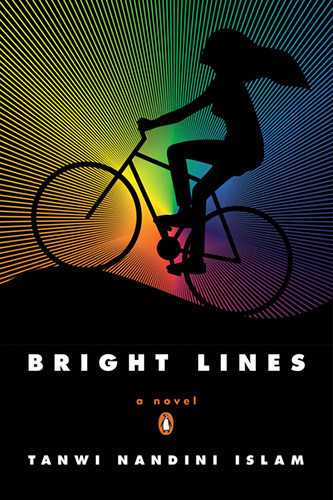
I found an unexpected favourite in the character of Anwar Saleem, a pot-smoking, well-meaning father-of-two who struggles to relate to his children after “their first bleeding had changed everything.” I say “unexpected” exactly because he’s the kind of guy who would imagine menstruation to be the cause of all his newfound inadequacies as a parent, but “favourite” because his sincere, reflective bumbling through middle age came to grow on me.
Anwar wondered how Charu knew this feeling of love. It was further proof of their distance. Had the movies taught her?
His story — together with that of his wife, Hashi — is revealed simultaneously through recollections of the Bangladesh Liberation War and the everyday goings-on of early-2000s Clinton Hill. Their struggles with marriage, family, community, history and religion are honest and endearing, and you might just find yourself rooting for them the way I did.
In contrast, the younger characters fell a little flat with me. Charu’s looks are constantly emphasised at the expense of more compelling character development for too much of the book (also making her the rather uncomfortable target of desire of both her sibling/cousin and uncle), while El’s self-serving brooding wore me out quickly. I took to their love interests better but neither got enough attention to really take form as fully fleshed out characters, and I found the romances themselves unconvincing.
The two siblings really come into their own when they visit Bangladesh. I initially resisted this, because using a third world country as the backdrop to a first world citizen’s emotional growth is far too common a trope in storytelling. But Bangladesh is an integral part of both the characters’ and author’s history — they weren’t Eat Pray Love-ing it, in other words — so it flows a lot better when you keep in mind that this is Bangladesh specifically as seen from the perspective of middle-class second-generation USAmerican migrants.
Ella felt a tug on her arm. A young girl, no older than eight or nine, stared up at her. She held out her little hand and said, “Kola dao.” Give me a banana.
—Here, child, said Rana.
He pulled out three ten-taka bills. —Buy a bunch of bananas. He turned to Ella. “And that’s how it is here. Brilliant characters everywhere you go. But the price you pay is guilt and too much traffic.”
Also, while the book centres the coming-of-age of a transmasculine character, the inclusion of other queer folks sometimes came across as tokenistic: the trans woman they run into at a party, the hijra they encounter at a slum. There are a lot of characters — many of whom I was interested in getting to know better, regardless of how I felt about Charu and El — in these 300-odd pages, and at the end of it I found myself asking “wait, what happened to _____?” once too often to feel satisfied by the resolution.
Rana tapped the steering wheel, trying to think. “You know, I’ve heard of one word—swadhin. An Indian photographer I met—he told me the word meant a woman turned into a man. Over there, they’ve got a lot of interesting words we haven’t found yet. I remember it stayed with me. Maybe because the photographer wanted to take me home after the exhibit. It’s a good word. Swadhin.”
“Why? What’s it mean?”
“‘Ultimate liberation.’ We use it when we talk about winning the war.”
“I’ve heard Anwar say it.”
“But in this case, it means a female finding salvation by becoming a man. Which I’m not sure is possible.”
“What’s not possible?”
“Finding salvation.”
Bright Lines, to be honest, did not live up to my expectations. I wanted to like it a lot more than I actually did. There was perhaps too much going on in too short a book, especially given that important events frequently bordered on the fantastical, including a fire, an orchestrated escape, and death by trampling — just to give a taste. Still, it’s a good read and the writing shows incredible promise, and I look forward to reading more both from Islam and other writers exploring the intersections of queerness, race, religion and nationality.
Bright Lines (Penguin Books) by Tanwi Nandini Islam will be released on August 11, 2015. Preorder your copy on Amazon.
FRIDAY OPEN THREAD: Eid Mubarak! (Also, Goodbye)
Feature image via whyain / Tumblr
Welcome to the Friday Open Thread, the weekly affair in which we report our progress towards realising the Queer Agenda and also love on each other’s cats. Today I’m counting on you to keep me entertained as I endure a marathon of comments on my hair, weight, and the fact that now that I’m done studying I should be applying myself to religion and finding a good husband.
Confession: I have never actually the phrase “Eid Mubarak” out loud, and it’s unlikely I will anytime soon. Today marks the end of Ramadhan, the month of fasting, a day likely known to most of you as Eid al-Fitr (Arabic: عيد الفطر) but to me as Hari Raya Puasa/Aidilfitri (Malay). I have strong feelings about the growing homogenisation (often Arabisation) of global Islamic discourse and practice, but those are perhaps saved for another time and place.
So happy Eid anyway!
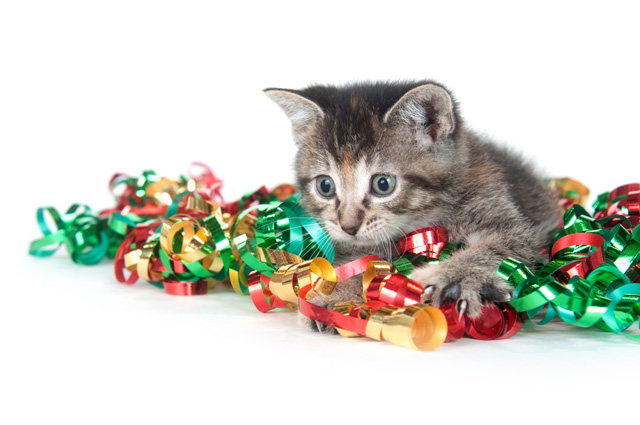
How has the internet not put a kitten into a baju Melayu and songkok set yet? I’m disappointed.
via Shutterstock
Hari Raya has always been the family holiday of the year for me, akin to Christmas for many of you theists and non-theists alike. I lived abroad for four years and never missed one here in Singapore (though admittedly this was rarely by choice). Most of this takes the form of visiting tens of relatives’ homes over the course of the month of Syawal: cramming as many people as possible into tiny, overdecorated living rooms, cramming as much kuih into your face as possible before you feel sick and/or get called out for finishing the honey cornflakes, trying to remember who’s related to whom and how (always complicated by cousin marriages), watching Malay dramas with Strong Religious Messages and an inexplicable number of dramatised rape scenes on Suria, and asking and granting forgiveness to those whom you’ve wronged and been wronged by over the past year. During Ramadhan you sort out your own shit, during Syawal you sort out your shit with other people.
But I didn’t come here to talk about that family, not least because many of them would not be pleased with me doing so on a queer feminist website. (This is a tried and tested theory.) In the year or so since I last hosted an open thread, I’ve moved into and out of NYC, in the process recruiting more members to my transnational Militant Homosexual Army. In polite company, I refer to them as my “queer family” or “queer community.”

Just some queermos in my former living room watching some quality Netflix. (Professional photography and screencaps by Laura W and Gabby respectively.)
It’s been almost two months now since I’ve left, and I miss them all acutely. It’s been even longer since I’ve been regularly writing and participating in things round here (grad school and visa regulations got in the way, I’m sorry) and I miss all of you too! Next month or so I’ll be starting work with the Overlords, which means the end of my love affair with the queer internets and Autostraddle dot com. I am not done processing my feelings about all this — mostly I just want to lounge about with my cat and PS3 while I still can, being neither in school or at work right now — but on this day that is set aside for us to celebrate what and whom we have in our lives, I want you all to know that you’ve been a huge part of mine and I am thankful for the two years I’ve had getting to know, learning from, and growing with this community.
And of course I wanna hear from y’all too: if you’re celebrating Eid/Raya, how’s it going? If you aren’t, what’s going on anyway? How do you deal with leaving people and places you love behind? What are the favourite things you’ve read about major life changes, especially if they’re not ones you’d have chosen if you’d had other options? How do I keep you all with me forever? Talk to me, folks, I’ll be here for the better part of the weekend.
How To Post a Photo In The Comments:
1. Find a photo! This is the easy part. Find a photo on the web, right click (on a Mac, control+click), hit “Copy Image URL,” and then…
2. Code it in to your comment! Use the following code:
<img src=”http://imageurlgoeshere.jpg”>
If you need to upload the photo you love from your computer, try using imgur.
*How To Post a Video In The Comments, Too:
1. Find a video on YouTube or Vimeo or WHATEVER and click “embed.” Copy that code, but first make sure it’s for 640px wide or less. If your player is too large, it will not display properly.
2. Copy the code and paste it directly into your comment.
3. Go forth and jam.
“The Duke Of Burgundy” Is The Lesbian BDSM Film You’ve Been Waiting For
The Duke of Burgundy is a lesbian BDSM film that you probably don’t know about, but should. Directed by British filmmaker Peter Strickland, it stars Sidse Babett Knudsen (Birgitte Nyborg, Borgen) and Chiara D’Anna. Here, my friend slash fellow SBK lover Rushaa (@thesecondrussia) and I discuss the film in two parts: first, on why you absolutely should watch this movie, and second, unpacking what went on in it. This film and discussion contains sexual content that some people may find distressing.

The Review
Fikri: Let’s start with how amazing it is that this film exists. When I was looking for people to go watch it with me I described it as a “British lesbian S&M film,” because of course, but hi it is a LESBIAN S&M FILM and it is a real thing! And one with a May-December couple at that.
Rushaa: After you told me about it, I googled it and my friend peered over my shoulder and said, “It looks like a lesbian Secretary so I’m going to watch it.”
Fikri: Yeah it’s also really weird that the two of us, of all people, were late to hear about it. I think its mainstream/non-festival release was probably overshadowed by this other big-money film I hear is about “BDSM,” which I shall refer to from now on as The Movie That Shall Not Be Named.
Rushaa: I think it’s great to get a film exploring queer women’s sexuality that isn’t lesbians having babies. Or babies and then tragic accidents, as a particular show I used to watch had.
Fikri: Grey’s?
Rushaa: Last Tango in Halifax.
Fikri: Of course there’s more than one. I might have just discredited myself as a reviewer by outing myself as a Grey’s viewer but that’s related to why I’m doing this at all, right, the reviews that exist now just weren’t doing it for me. In particular, virtually every review I’ve read has pointed out that The Duke of Burgundy has an all-women cast but in a “there are no men but it’s still good!!” way. One of them actually describes this as “an alternate universe in which … reproduction is irrelevant” — I’m sorry, how often is reproduction relevant to your fictional universes?
Rushaa: The all-women cast is a good point. I didn’t even notice.
Fikri: Me too, but if there’s a strong reason to watch the film THIS IS IT.
Rushaa: I mean, all-women was my Friday night.
Fikri: All-women is my aspirational every day.
Rushaa: Amen to that.
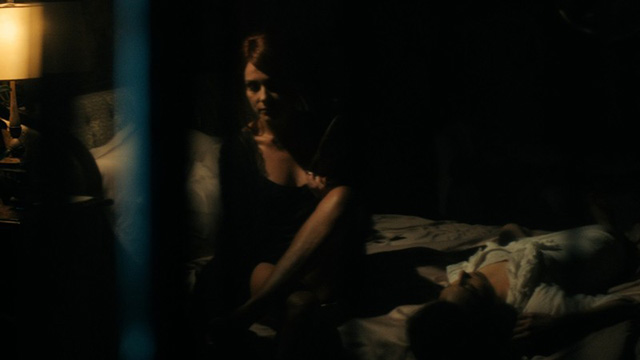
Fikri: But back to the portrayal of queer women’s sexuality. What I really appreciated about the film was that it was most definitely not made for the male gaze, which was my no. 1 fear upon hearing it was yet another sexy lesbian film directed by a man.
Rushaa: Agreed. When I got to the cinema they had allocated seating and they sat me right in the middle of two lone men. It was a guy, seat, me, seat, guy. They totally thought it was a different movie. The first guy ran away after I sat down and the second guy was really feeling it until the climax of the first scene and then moved his hand across his mouth away from his crotch and was silent the rest of the time.
Fikri: HAHAHAHAHA
Rushaa: It was certainly better than the time I went to see Blue is the Warmest Colour. I didn’t have to stare men into shame.
Fikri: The movie did it for you!
Rushaa: Which is another reason to love it.
Fikri: The trailer is fairly heavy on the sex and lingerie but I found it to be an incredibly sexy film even with a lot fewer actual sex scenes than you might expect. I don’t always know how to use the word “erotic,” but this captured it perfectly. I might never look at soap bubbles the same way again.
Rushaa: Washing up will never be the same. I may have to retire our machine. My flatmates won’t know what happened.
Fikri: The film involved a fair number of kinky things an ordinary audience probably wouldn’t be into — it really isn’t afraid of pushing boundaries here and right from the start too — but I particularly appreciated that it doesn’t rely on expensive props to flesh out what consensual power play in a relationship might look like, which The Movie That Shall Not Be Named does. Nor does it rely heavily on the infliction of pain, which isn’t a good or bad thing but rather something that I found interesting and might perhaps make it easier for some folks to watch. (Though of course you’d need to be prepared to be uncomfortable to watch this at all.)
Rushaa: The film works its way into your head, and the power play is certainly central but also incidental at the same time. From the trailer I expected a lot more gimmicky stuff but it was sweet and also sad at parts. Everyone in it was just a human doing their thing, and sometimes mucking up. I think the lack of fancy gear not only put the focus on the characters themselves more but also makes it a bit more relatable to the ways in which many people themselves might experiment in their relationships.
Fikri: Yeah, it dealt with love and relationships in such a nuanced and sensitive way that I’d recommend it just because, not just as “a BDSM film.” Also, because SBK.
Rushaa: Lesbian S&M with Sidse Babett Knudsen! Be still my beating heart.
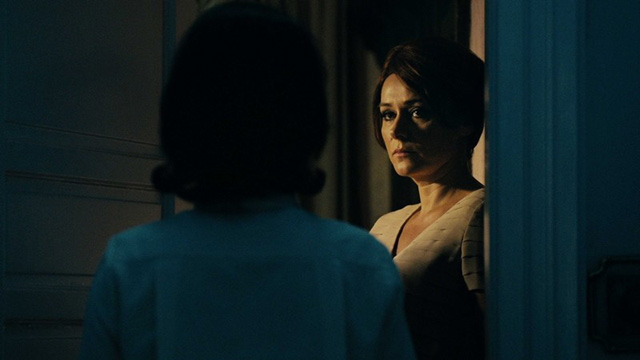
Fikri: Can we talk about how SBK as a lesbian domme is basically all of my dreams, ever?
Rushaa: I both want to be her, and serve her.
Fikri: That was definitely something I felt watching it too, which was confusing sometimes as someone who only strongly identifies with one side of that dynamic in my own life but I think that really speaks to how good the movie dealt with shifting, complex power play… and in particular how good SBK is at expressing both dominance and vulnerability.
Rushaa: It just reaffirmed everything I felt during Borgen.
Fikri: Right! I know it’s unfair to keep defining an actor by a role they did once, especially because in so many ways Cynthia is not Birgitte, but this whole film was like a lengthy extension of how I felt during that scene when Birgitte swipes everything off her desk and cries. I’d loved her before, but that fully captured my heart. And SBK, just… why is she so good at that?!
Rushaa: IDK, BUT SHE IS AMAZING. And my future wife.
Fikri: Mine too and I believe we have even proposed this.
Rushaa: Could we make her big in queer circles? Invite her to A-Camp?
Fikri: YES I would really like her to be a gay icon, unfort she’s straight as far as I can tell. But it’s at least mildly forgiven because she played a lesbian domme. How many actresses would do that?
Rushaa: I don’t know, I don’t think the film industry has really tried to test the amount of lesbian dommes they can make movies about. At least not in films that can be shown in mainstream cinemas.
Fikri: True.
Rushaa: I was afraid that Cynthia’s character might be quite tropey but Sidse beautifully exceeded my expectations and crafted something heartbreakingly wonderful. I guess we should add that Chiara D’Anna and the rest of the cast were also amazing? It’s just that we have a longstanding love of SBK and she is in killer outfits (and lingerie) for most of this film so obviously we gravitate towards talking about her.
Fikri: Oh yeah, this film has a lot of lingering looks. Everyone was very good at lingering looks. A+ for lingering looks, and also everyone’s boots.
Rushaa: It was wonderfully intense.

Fikri: Other things that were intense: bugs. I’m not sure why reviews and blurbs keep describing Cynthia as a “butterfly professor” because doesn’t she study crickets? I’m also not entirely certain what Cynthia and Evelyn’s professional relationship is, if they have one, but it’s charming that that’s what they have in common. (Tangent: people who are deeply bug-phobic probably shouldn’t watch this, they really are a fairly big part of the film. I mean you know a film’s gonna be good when it starts with credits for “dress and lingerie,” but then it also lists every insect that was featured in the final rolling credits.)
Rushaa: I will admit that I wasn’t 100% certain where they were going with the moth motif.
Fikri: Neither was I. I think independent of what the bugs were supposed to ~mean~ though, even if they were supposed to mean anything, what stood out was the all-women audiences at the bug conferences. (Yeah that’s definitely the technical term for it.) One Guardian review says that the film “reflects one overlooked truth: contrary to stereotype, many great butterfly obsessives have been women.” And by “stereotype” I assume he’s talking about how most of the Bug Keepers in Pokémon were boys.
Rushaa: If I remember my Pokémon all those boys were extremely attached to their bugs as well.
Fikri: Their “bugs.”
Rushaa: *cough cough*
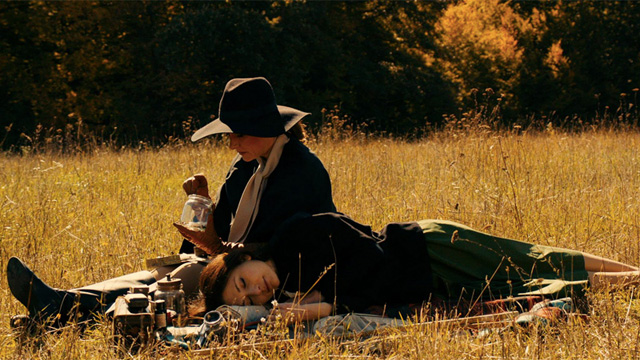
Fikri: ANYWAY. Wanna sum up why you’d recommend The Duke of Burgundy?
Rushaa: Okay. In short I would recommend this film because 1) Sidse Babett Knudsen, 2) there aren’t enough queer lady films anyway, I don’t really know any focusing on power play, and this one is heartbreakingly good. If I am willing to walk around busy Leicester Square during Chinese New Year celebrations in the rain to process my feelings then it is a film everyone has to see.
Fikri: Ha! And I ice-skated to downtown Manhattan during the ice-snow-slush situation we had going on to watch it at midnight. No regrets. (I should mention at this point that when we both learnt of this film’s existence, we booked literally the first viewing of it we could find — rest of our plans be damned.) And why I want others to watch it now: I hate reducing The Duke of Burgundy to these terms, but to me it’s first and foremost a love story, and an exquisitely told one. I came to it expecting an exploration of kinky desire and I got that, but also way more. It was far, far more emotionally intense than I expected (or was prepared for!) but because of that it’s all I’ve been able to think about since watching it.
And yes, SBK is ON POINT.
Next: We process our feelings after watching the film! It is super spoilery, so don’t click through if you haven’t. Again, this discussion contains sexual content that some people may find distressing.
Gay, Interrupted: On Navigating Gaybourhoods As A Queer Brown Woman
“Helloooo,” he lowers his eyelids flirtatiously and giggles, drunkenly clinging onto his partner. Having a markedly low tolerance for street harassment, I am immediately put on edge. I relax a little into the realisation that my friend and I — a trans man and an androgynous lesbian, both small-ish Asians — could easily be mistaken for two gay men ourselves.
Then another voice calls out, “Ni hao!”
I pause. Did he really just say that? How did he, why did he— do I really look Chinese? (Coming from a background of being erased in Chinese-majority environments, that particular remark stung just that little bit more. If we’re going to be dishing out drive-by racism here, my preferred slur is “terrorist.”) Does that even matter? Am I being oversensitive, or overthinking this?
Are we not supposed to be here?
They laugh.
“Fuck you!” I respond, a bit too belatedly.
We’re walking back to our hostel through Manchester’s Gay Village, having just talked about exactly this over dinner: white cis gay men dominating queer spaces. White cis gay men making us feel unsafe and unwelcome; white cis gay men stumbling uncomfortably close to us while yelling “ni hao!” under street signs that warn against the consequences of homophobic hate speech.
A friend shares that the first time she visited a bar in the Village, a drag queen was telling a joke about Chinese folks. Her unanticipated entrance invited an awkward pause, her physical presence selfishly disrupting the previously easy laughter of the audience. That is exactly what navigating gay districts as a queer brown woman often makes you feel like: an interruption.
The first thing you’ll notice about the Village is that it’s really pretty. Being accustomed to the damp grime, broken glass and rowdy crowds of London’s Soho, I’d add unexpectedly pretty. Flowers line the streets that in turn straddle a calm, picturesque canal, the kind that seems like it must have been made to be strolled along and never anything as crude as channelling flows of water. Plastered next to pastel-coloured posters promoting an upcoming trans festival are large, bold signs warning that hate crimes are taken seriously by the Manchester Metropolitan Police. Looking down on all of them are rainbow-coloured street signs declaring, “Smile! You’re on CCTV.”
The place where we had dinner, the Richmond Tea Rooms, is the pinnacle of this. Owned by two men, its over-the-top decor queers the British fetishisation of tea and temperance that tearooms and their associated rituals symbolise. We sat in Alice in Wonderland-themed seats overwhelmed by plush cushions with Heather, who lived nearby and whom we had just met in London a couple of days earlier at an Autostraddle meet-up. She told us that the Village’s main drawback is that it still doesn’t feel safe at night so the flowers and police warnings were part of a recent attempt to “clean up” the area.
There’s an argument for policing trans-, bi- and homophobic violence, of course: according to Stonewall’s 2013 Gay British Crime Survey, 1 in 6 LGB people in the UK had been the victim of a homophobic hate crime or incident in the past 3 years. Stonewall in England & Wales does not (yet) represent the trans community, but trans people, especially trans women and sex workers, are disproportionately subject to harassment, violence and murder on the streets. The nation’s only memorial commemorating the victims of transphobic hate crimes was set up in the Village in 2013… and vandalised just days after.
What’s less clear is whether there’s as strong a case for the police to be doing it. Urban gay neighbourhoods, whether in Manchester, London or elsewhere, almost always arose from the fear of queerphobic violence, sociopolitical disenfranchisement, and the criminalisation of sex and sex work — all of this frequently at the hands of the police. All of this still frequently happens at the hands of the police, so it’s worth asking: are the pride flags decorating blue uniforms today a sign of the times or simply of short-term memory?
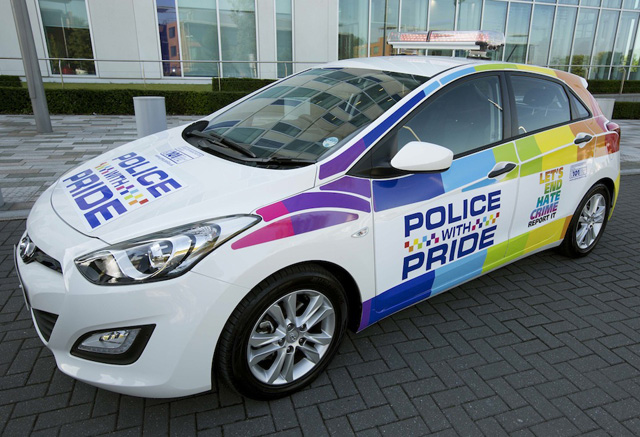
If we slap a rainbow on it can we call it even on decades of violence now?
via motors.co.uk
Criminal justice system reform is slowly working its way into the LGBTQ activist consciousness, but not without its hiccups. At a Dyke March in 2013, a well-known queer feminist added anti-police chants to the event’s usual rally cries as we marched through the heart of central London. Responding to those who grumbled about her going off-message (including a police officer who nudged a march participant near me and asked quietly, “What did we do?”), she later added on Twitter that if we couldn’t see how all police were scum, we weren’t thinking intersectionally enough. Fair. Maybe.
Here’s the thing though: if she had been thinking “intersectionally” enough, she would have known that had the policewomen been sufficiently provoked, it is not her, a white woman, who would have been hauled off to jail and kept there. It is not her, a British citizen, who would have been asked to leave the country. It is not her name and her face which would have made headlines the next day. Corralled between police officers with the authority to arrest us and white anarchists with little personally at stake if they did, my enthusiasm about participating in a public queer event for the first time gave way to unease and insecurity. It’s important to recognise that we do not want to invite the mechanisms of state violence and surveillance into our spaces and onto the most vulnerable members of our communities, but surely the solution can’t lie in offering up their bodies to make a political point.
Earlier that day Jeremy and I had been reading through TripAdvisor reviews, taking perverse pleasure (as we queers do) in the hurt feelings of straight people who cried oppression when their hens do in the Village were ruined by, you know, actual gay folks. “If people think homophobia is bad, go and see first hand the hetrophobia (sic) on display at G-A-Y!!” declares one. Another grumbles about “staff watching normal straights all the time” (emphasis mine), while my personal favourite makes a gloriously revealing typo in stating, “as a straight person I feel prejudiced on occasions.”
“If a typically ‘straight’ venue treated people like this they’d be sued for discrimination! However I don’t let it bother me (because it really doesn’t) and continue my night elsewhere.” (I imagine the unwritten part of the review goes, “Specifically, in front of my computer, writing a lengthy online diatribe about things that totally didn’t bother me at all.”)
“Sort it out, we all want to be in a prejudice free world.”
Yeah. Don’t we all. These reviews got across the point loud and clear that straight folks really, really do not enjoy being left out of G-A-Y, perhaps similar to how queer people do not like being excluded from healthy family environments, the right to self-determination and expression, employment and education opportunities, media and political representation, and life itself.
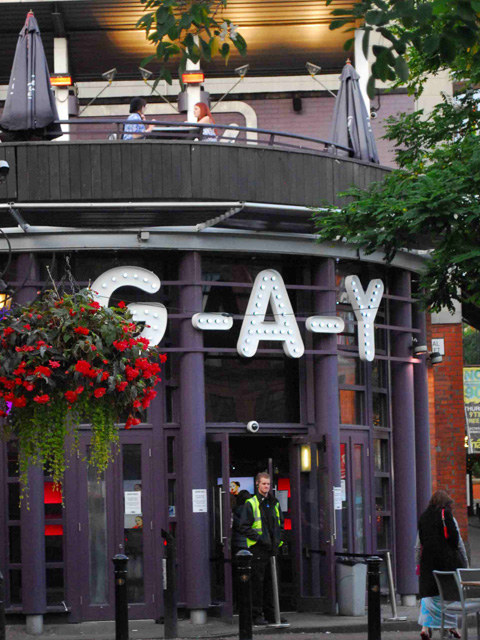
You’d think the name would have tipped them off, but nope.
via John Coxon Photography
Unfortunately I struggle to empathise with the stresses of having to find a night scene friendly to heterosexuals even after going through pages and pages of similarly worded reviews, but one comment that really gave me pause was one that was meant to be a positive endorsement of the Village:
“It is a popular destination for Hen parties and they’re welcome in most bars […] and you will spot a drag queen or two whilst wandering from bar to bar!”
You will spot a drag queen or two. Maybe if you’re lucky!
Signalling another massive shift from the days of sex in the bushes (well, the days of more sex in the bushes), gay districts are now tourist attractions promoted by city councils on glossy brochures and rainbow-themed (of course!) webpages. Part of this is because of the massive urban rejuvenation efforts that have transformed gaybourhoods worldwide in the past few decades, whether from funder-backed urban redevelopment projects or the steady gentrification of white, middle-class gays, making them safe, alluring destinations for the curious wanderer looking for an “alternative” night out. Yet part of this — the part that is not anything new, and definitely not anywhere near progressive — is because queer people have always been seen as tourist attractions. It’s just that now we’re more easily and acceptably consumed in moderate, measured doses within designated areas.
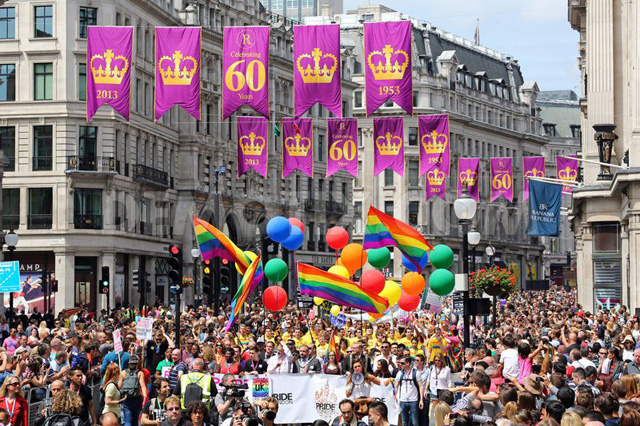
Liberation™, brought to you by Barclays. (You might even spot a drag queen or two!)
via Dos Manzanas
In going from private closet to public spectacle, shady neighbourhood to international attraction, have we really reclaimed pride from shame or played into dynamics of commodification and assimilationism to our detriment? There’s no easy way to talk about The Man here when the mainstreaming of gay culture has, for many, made it possible to survive and even thrive. Gay’s the Word might never be the radical socialist space it once could have been, but neither does it invite the suspicion and sabotage it once did. Pride marches are now sponsored by big corporations with dodgy politics and even worse labour practices, but they also inspire vulnerable queer youth to imagine futures that aren’t crushing dead-ends. Playing straight, playing for straights — at-risk queers have long learnt how to make heterosexuality and capitalism work for them to survive. But let’s also not kid ourselves in thinking that the respectability politics that underlie the progress of the LGBTQ “community” has uniformly made it better for all, when sex workers and saunas are swept away to make space for parties and wedding proposals. Gay districts are safer, more open and more profitable than ever before, but for whom?
As I’m trying to get a grasp on what gay districts stand for and how we should preserve this, it’s funny enough to think of straight tourists being side-eyed by butch bouncers but decidedly less amusing when I think back to how at a London Autostraddle meet-up in 2012 our tiny assemblage of queer women was rejected entry into a bar in Soho. The bouncers weren’t convinced we were gay, even though we probably collectively had more piercings than hair on the left sides of our heads. Do we have to perform gay to be allowed to be gay in public? How do we do this, when “looking gay” is inherently coloured by class, race and gender? Queer women and men alike have adopted variations on the “working class” attires of flannel shirts and combat boots as queer uniforms, for instance, but it’s hard to say if a queer Sun-reading Mancunian man would pass G-A-Y’s bouncers’ tests as easily as a young skinny boy in a deep V-neck t-shirt. Muslim women participating in gay pride marches get called “suicide bombers,” while white women in rainbow niqabs are applauded for their courage in bringing to light the struggles of poor, third world brown queers. And that one time our ragtag group of mostly ladyqueers got turned down in Soho is just one of many incidents of queer women’s sexualities being disbelieved, trivialised and invisibilised. Endless media and activist discussions of homophobia and sexism — on “fag hags,” on bachelorette parties in gay bars, on gay men feeling entitled to touching women’s bodies — take as their opposing players gay men and straight women, ignoring the queer and trans women whose bodies make up the battleground.
The gendered dynamics of gay spaces extend far beyond the policing of “looking gay” at bar entrances, of course, whether we’re talking about the gender divide between the Castro and Oakland because of economic disparities between gay men and women, or feminist and lesbian spaces (particularly bookstores) and the organisations behind them being chronically underfunded and frequently the butts of jokes in gay media, including in everyone’s latest favourite tearjerker, Pride. (Don’t get me wrong, it is an excellent film that I strongly recommend. Yet it unfortunately also follows in a long-established tradition of trivialising queer women’s needs for their own spaces.) The year that I arrived in London, First Out Café, the city’s first daytime gay venue, closed. The year that I left, Candy Bar, the biggest (and only wheelchair-accessible) lesbian bar, followed suit. This isn’t unique to London, as many other spaces that cater primarily cater to queer women and other folks struggle to survive while gay men’s clubs and bars thrive. As Carmen writes from DC, “It’s not possible for us to know, just yet, how our community will change now that we don’t have a central place to house it.”
I know intimately the promise and allure of gay districts, even as someone whose fullest extent of engagement with “the scene” is often just standing awkwardly in a corner sipping a mocktail while friends unsuccessfully implore me to dance. As an 18-year-old in London, newly arrived from a home very far away, my first night in the basement of Ku Bar — on the one night they have designated for women — was eye-opening. I was intimidated by the alcohol, loud music and physical intimacy, but I’d never been in a room with that many queer people before and it was affirming in a way I didn’t even know I needed it to be. Particularly memorable for me was a moment when a middle-aged Chinese lady whose business wear resembled that of the homophobic principal of my junior college casually walked past, wineglass in hand.
Neither are gay districts necessarily now devoid of hope for me. In my last week in London I finally caught Soho’s annual Village Fête, which gave space to community groups, queer performers, and the odd and brilliantly endearing waiters’ race, in which waiters well, race, along Old Compton Street balancing a wine bottle and glass on a tray. Instead of the Metropolitan Police, the Fête was cared for by the Lesbian & Gay Foundation’s Angels in pink fluorescent vests, who were borrowed from Manchester’s Gay Village and whose first job was to listen to whatever people needed to say and to provide support where necessary, whether it was directions, a safe ride home, or yes, a police call.
Still, that first time I left that gay bar in Soho, I was mainly afraid of running into people I knew from back home. (Like Manchester, the gay district in London is right next to the city’s Chinatown, which doesn’t do much to assuage the fears of closeted queer Asians like I was then.) I didn’t know then to be wary, instead, of those I’d just shared the small, dark basement with. I hadn’t expected then that the vast majority of racism and sexism I’d experience in my three years in London — whether it was yelled at me on the streets or calmly, condescendingly expressed in meetings about the rightful “priorities” of the LGBTQ movement — would be from other queer people.
Gay districts are constructed as havens, as sanctuaries, as places where expression and identity can freely tumble forward in messy, drunken messes. But this glosses over the realities of those of us who are policed for not being gay enough or for being too queer, for dressing wrong, for looking wrong, for being wrong; this doesn’t confront the complexities of police and policing at the intersections of queerphobia, racism, sexism and classism. This picture simply moves on past the interruptions that unruly bodies present, the disruptions to social norms that gave rise to gaybourhoods in the first place. This picture prioritises comfort over challenge, compromising the promise of safety and welcome that these neighbourhoods are supposed to stand for for those of us who aren’t white cis gay men. Who are the “gays” for whom gay districts are built (around)? Who gets to decide?
Are we not supposed to be here?
10 Game-Changing Things We Learned At Facing Race 2014
Over Nov 13–15, two of us, Yvonne and Fikri, attended Facing Race, the US’s largest racial justice conference. Yvonne told you about all the things she was excited to hear about while Fikri didn’t really know what to expect, and was mostly just hoping to be somewhere warmer than NYC. (It was not.) Either way, we crammed as much learning as we possibly could into those few days, met people from the internet (including each other) in real life, and paid too much money for pastries and parking. It was altogether intense, inspiring, challenging and comforting, and now we’re here to talk about it with you!
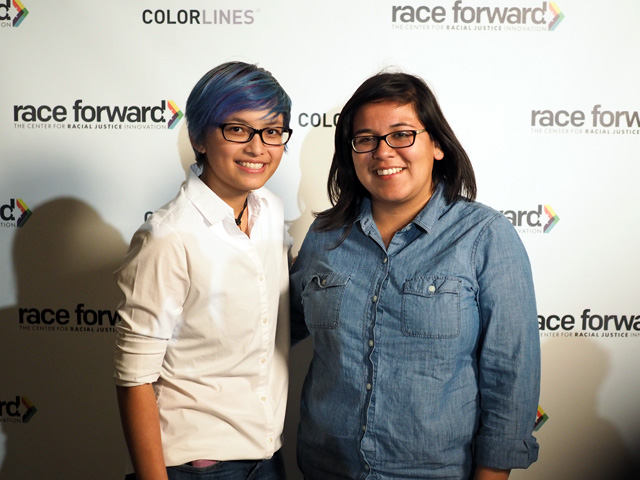
“We should probably get pictorial evidence that we were here.”
We’d like to first recognise Race Forward’s efforts in making the conference an LGBTQ-friendly space, including providing gender-neutral bathrooms, guidance on language and behaviour expectations, and most importantly, a significant amount of queer programming. Highlights included a night of emceeing by Monica Roberts of TransGriot, presentations by plenary speakers Key Jackson, Bishop Tonyia Rawls and FM Supreme, and great haircuts all around. Putting intersectional ideals into practice is something that feminist/women’s spaces in particular struggle with, and while we obviously can’t speak to the accessibility and inclusivity of the conference as a whole, we personally appreciated the opportunity to be in a space where we were validated and supported in our multiple and intersectional identities.
We also recognise the contradictions inherent in attending an event that was described as a “premiere multiracial, multigenerational gathering for racial justice advocates” — or as Hari Kondabolu put it, the POC Oscars. Spaces like these are important and energising for those who can make it there but can also reinforce class stratifications within and outside of them, which became most apparent during fundraising calls throughout the conference. (If you do have a couple of dollars to spare, definitely consider donating to Race Forward! If you don’t, no one should shame you for it.) To the organisers’ credit, the decision to host the conference in the South was an important one… though maybe someone should have checked out the tacky Orientalist art that the Hilton Anatole is decked out in first.

Well, they tried.
Keeping these things in mind, here’s what we learnt that weekend.
Fikri, Contributing Editor
As someone who’s not from the US and who won’t be here for very long, I focused on picking up skills and analytical frameworks that are generalisable across different contexts, movements and racisms. To that end, I attended Reclaiming Government: A Dialogue about the Intersection of Race, Ethnicity and the Public Sector’s Role in Advancing Equity, Using Systems Thinking to Address Structural Racism, Institutionalizing Racial Equity and Advancing Positive Racial Impacts, and a tiny bit of Queer and Trans People of Color Art Saves Lives: Testimonies on Pasts, Presents, and Future.
1. Don’t take up space.
In my experience self-critical whiteness, or self-critical masculinity, is no less occupying of space. The time taken up by self-critique is still time taken up.
— Sara Ahmed
I walked into the QTPOC event just as the discussion was opened up to the floor, and the first person to offer their opinion was a straight, white man who opined at length about collecting the artworks of black trans women. He didn’t answer any of the questions posed by the panelists nor was he sensitive to the discomfort of the people in the room whose lives he was commodifying and fetishising in a space that was meant to celebrate and affirm their existence. People got pissed, and rightly so.
You’d think this would be obvious for white people attending a conference on racial justice but g-d, no, it really wasn’t. I tried to be extra accommodating in 1. not assuming people were white based on their name/appearance and 2. assuming good faith, but there were still far too many statements that started with “as a white person…” and you guys, there is no good way that sentence can end because it shouldn’t have been started. I even heard someone unironically suggesting “leaning in” as a solution to racial bias.
There is perhaps a place for unlearning and unpacking individual privilege, but this was not it. Not only should this have been a space that centred POCs, it was also a rare opportunity for some to conceptualise and talk about racial inequities as complex, overarching structural phenomenon, which can be easily lost in the day-to-day work of community organising, media (mis)reporting and so on. Take your feelings elsewhere.
2. Tension is a productive force.
This was an offhand remark made by Rosana Cruz, Race Forward’s Leadership Action Network Director, at the start of the plenary session Roots and Wings: Southern Histories, Legacies and Innovations for the Future but it stuck with me. Tension holds up huge bridges! You don’t need to be coming from a place of common identities or beliefs to inspire solidarity and action, which Bishop Tonyia Rawls’ exemplified through an account of her work finding common ground with church leaders as a black lesbian pastor in the South.
Tracking the #FacingRace14 hashtag exposed me to critiques and perspectives that I often missed in the electrified atmosphere of the conference or a speaker’s particularly clever turn of phrase. I (re)learnt that ideas can be — or often are, rather — powerful and problematic, and that this tension is valuable even if it’s difficult or impossible to resolve. The interruption of the white male art collector caused palpable hostility but this was diffused by someone in the audience who called him out on it and Luna Merbruja on the panel who spoke directly to what he did wrong, and turned later into a positive discussion on economic support and the importance of archiving. I also spent a lot of time throughout the conference thinking about “calling in” and the politics (or humanity?) of politeness on social media — not really reaching any conclusions, just letting myself think through it all. Things are always gonna fuck up and people are always gonna disagree, and there’s value in conflict and tension that doesn’t always need to lead to resolution.
3. Things are not, in fact, bigger in Texas.
https://twitter.com/metafiktion/status/533073577189572608
Perhaps Yvonne was bringing me to all the wrong places in the little downtime that we had (I’m talking a vegan grocery/diner and an Indian buffet restaurant) or I was deceived by the tiny, tiny little croissants the Hilton served in the morning for breakfast (which I ate copious amounts of despite being lactose intolerant), but I did not get actual evidence of supersized living in the South. I didn’t even notice as many gun-related signs/notices as I did in Chicago, though it’s possible that I’m just about adjusting to the US enough that these things are beginning to escape my attention.
This was an important thing this year’s Facing Race organisers did, though: having the conference in Dallas and making local-themed panels/plenaries a key part of the programme demystified the South for a lot of us, including (actually, especially) those from the US, and opened up so many new opportunities for learning and collaboration.
4. Intergenerational, intrafamilial work is important, necessary… and terrifying.
This was a hard thing for me to grapple with and will be for a long time, I think. Facing Race emphasised the importance of “multigenerational” work a lot, and that’s easy enough to think you get when you’re listening to the experiences of people who’ve been in the field 20 years longer than you have or the formidable combination of Bernice Johnson, Toshi and Tashawn Nicole Reagon. (Full disclosure that I wasn’t actually at their keynote address because I was ill, but I thought it was a powerful choice of speakers.)
But now all this discussion about community organising and solidarity and protest and building new futures? Take it home to your family. Sit down with your parents and ask them about their lives, ask them about what they hope for, ask them how you can stand in solidarity with them.
Yeah.
That’s scary, isn’t it?
I’m not on the best terms with my family because of my queerness and I know I’m far from alone in this. For many of us (with notable exceptions) our queer identities and lives, much more activism, are points of departure from the families we were born into, often involving imagining or working towards futures that consign them to the margin out of pain, trauma, isolation, plain old narcissism or any number of perfectly valid reasons. But confronting personal and political racial histories and consciousness requires us to go in the exact opposite direction: to find narratives that tie us to our families, not set us apart. How do we negotiate this? How do I negotiate this? I can’t even begin to imagine what this might look like in my own life, but I know that it’s something that I’m going to need to think much more deeply about.
5. Support others!
I met so many inspirational people that I’m reminded that I need to be doing way more work in supporting other people’s work, because this shit is hard and so often we’re alone when we don’t need to be. I’d like to start by bringing your attention to the work of the Better Together programme, a “multi-faceted initiative that combines research, media, and leadership development to advance racial justice and LGBT liberation,” and the three artists on the QTPOC panel: Cherry Galette, Nia King and Luna Merbruja. Last month Mey spotlighted King’s book, Queer and Trans Artists of Color: Stories of Some of Our Lives, which I’m now happily an owner of. I want to be more conscious in building up communities that matter to me by directly engaging with and promoting other people’s work, because no one else is gonna do it for us.
Yvonne, Senior Editor
I haven’t gone to many conferences, but I would say Facing Race is one of the best ones I’ve attended. After it was all done, I felt energized and motivated to do more in my communities and at the same time I felt proud to be from the South. I met so many amazing people doing phenomenal work in their area. Oh and I met some badass Latina feminists I follow on the internet in real life so that was exciting!

In addition to the plenaries and keynote address, I attended these breakout sessions: “Those Kinds of Kids”: LGBTQ Youth of Color in the Child Welfare and Juvenile Justice Systems, Queering Racial Justice Organizing in the South, Change Culture, Change the World: An Introduction to Pop Culture Strategy for Social Movement and Olivia Pope Notwithstanding: Strategies to Transform a TV Landscape Causing Everyday Harm to Black People. Overall, I learned so much, even things that pertain to my media-making work but here are a few things that really stuck out for me.
6. Small victories matter
My life revolves around the internet and because of it I’m use to instant gratification for the things I do. I write a Facebook status, people like it; I post a photo on Instagram, people heart it; I write a tweet, people retweet it. I publish something on Autostraddle, people comment on it. I’m used to rapid results and receiving an instant benefit from what I do.
Organizing in the South is far from seeing an immediate result or change, which can be incredibly frustrating for someone like me, whose job isn’t in organizing but participates in social justice causes in my city. I’ve discussed this with my partner who is a union organizer and has experienced how incredibly hard it is to create change. In the “Roots and Wings: Southern Histories, Legacies and Innovations For the Future” plenary Cristina Tzintzún, Executive Director of Workers Defense Project, a Texas-based workers’ rights organization, reminded me that “little victories are tremendous gains,” especially in the South. She talked about how the members in Workers Defense Project, who are mostly undocumented construction workers, have gone up against billion-dollar corporations that support the Texas Republican party and have made changes not only in Austin but in the state. From demanding safer working conditions to getting mandatory rest breaks for construction workers, members have made strides when it seemed impossible.
“We’re building power for the long haul… I think doing work in the South is some of the most difficult and challenging work for progressives like we are, but I also think it’s incredibly fun. I think when you’re at rock bottom you can only go up and I think that’s what the communities here are doing,” Tzintzún said.
Granted, we shouldn’t just aim for small victories because they will never be enough and not a victory for all but we have to make small strides in order to pave the way for bigger victories. When you’re talking about dismantling the white patriarchy, it can seem impossible but when you give value to the small wins, say talking to your brother about sexism in gamer culture and getting through to him, we shouldn’t just shrug that off or dismiss it. It’s important work that needs to happen that ultimately contributes to the bigger picture.
7. Solidarity is the key to organizing in the South
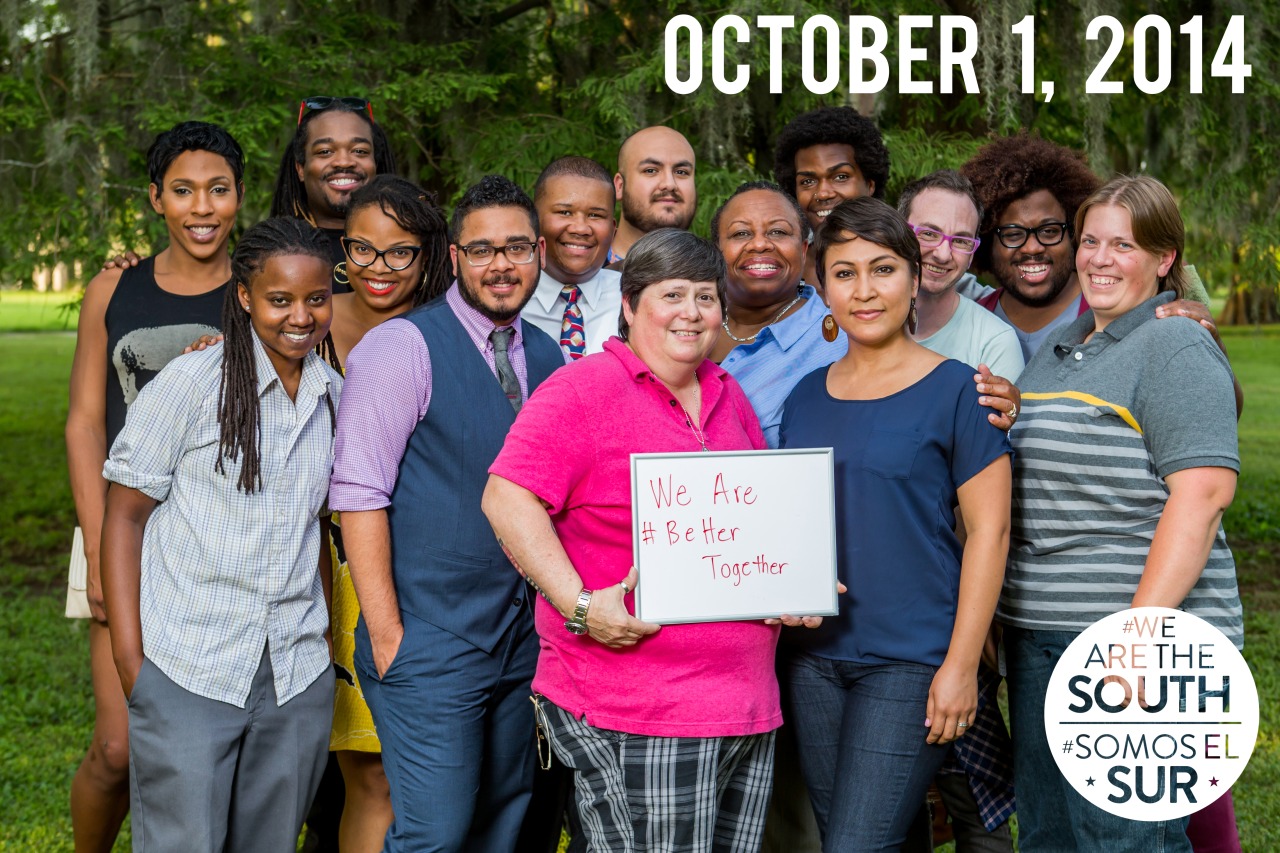
Better Together cohort
One thing I took away from the Queering Racial Justice Organizing in the South session was how crucial it is to work across identities and communities if we want to build power in the South. In the session, we heard from the Better Together cohort which is made up of eight social change organizations and their #WeAreTheSouth Campaign. The cohort bridges the work of various organizations that is focused on immigrants, youth, reproductive justice, education and LGBTQ issues and brings them together. Nayely Perez-Huerta, Southeast Immigrant Rights Network organizer, said in order to transform the South, we must work with other organizations because the same forces trying to bring down immigrants are the same forces trying to bring down black communities, LGBTQ communities, etc. so we should stick together. Executive Director of The Freedom Center for Social Justice, Bishop Tonyia Rawls also spoke how crucial it is to work with faith communities in the South to get things done.
8. Social media is a tool, not the be-all and end-all of your activism
This should be an obvious one, but for me it was a great reminder especially since I work on the internet. It’s easy to call out people and share articles on racism on social media or be involved in a Twitter conversation but that shouldn’t be the end of our activism. FM Supreme and Ramiro Luna talked about this in “This is How We Do It: Youth Led Racial Justice” and specifically how young people are using social media to organize around racial justice. FM Supreme talked about how social media was a way for people to gather after everything that happened in Ferguson. It also provided a platform for the “people’s narrative” of what really was going on in Ferguson compared to the “mainstream narrative” portrayed in the news. Luna talked about how important it is to share your views and be vocal about movements on social media but how it’s even more pertinent for people to show up on the streets and build relationships with people to make real change. It’s great to talk the talk, but more important to walk the walk.
9. We all have to fight anti-blackness
In Race Foward’s President Rinku Sen’s last remarks in “The Next 50,” she said, “To date we have been seeing ourselves as separate constituencies that act occasionally in alliance with each other. In the next story of us, we have to see ourselves as one constituency. A constituency that wants racial justice.” She continued to talk about how in the US, we live in a black-white paradigm that shapes our reality and affects us all and how we all have to fit ourselves into this paradigm in order to survive. She said since this black-white paradigm is central to racial hierarchy, we all have to fight against anti-blackness.
“Anti-blackness sets the national discourse on race, so fighting it has to be on the agenda of every single person or group that claims to be about racial justice,” Sen said.
She also went on to say that fighting anti-blackness can’t be the only thing we rally behind. We should focus on fighting for indigenous communities and immigrants as well. She emphasized multi-racial unity, that we should be one movement and not a collection of movements.
With everything that’s happened in Ferguson to the countless black men targeted by police and incarcerated to the many black trans women that are murdered every year to the way black folks are portrayed in the media, I couldn’t agree more that we all need to fight against anti-blackness.
10. I’m needed at home and you are too
After the closing remarks and riding high on the electricity of Facing Race, I went to an impromptu and informal Latino Caucasus that I only found out about on Twitter. Even though I was hungry and tired, I thought I’d go because I wanted to fellowship with Latinos. I sat down in the circle and immediately felt like I was at home. It’s hard to describe but even in the sea of POC (which I was very grateful for) I didn’t see many Latinos at Facing Race, so suddenly seeing about 20 shiny, beautiful various shades of brown faces sitting together, I felt a sense of relief. We introduced ourselves and what we do and then we talked about how there wasn’t a lot of Latinos involved with Facing Race and how we wanted to see more sessions that reflected the various struggles of Latinos.
I wasn’t there very long but just sitting there stirred something in me. I guess it was the culmination of everything I learned at Facing Race and listening to what these Latinos had to say that I realized I need to stop running away from my hometown in the Rio Grande Valley. I’ve said this before but I grew up in South Texas near the Texas-Mexico border, a place where the population is more than 90 percent Latinos. I left the Valley for college but mostly because I felt I couldn’t be my whole self at home because of my queerness. I’ve grown so much since I lived in the Valley and I keep saying I’ll never live there again because I don’t feel good about myself when I’m there. That it’s too hard to change people’s minds about queers. That it’s too hard to make people understand that sexism is real, that racism is real, even in places like the Valley. I was privileged enough to move away and go to college in Austin, learn about different oppressions in the US and be politicized. Now that I have all this knowledge, it’s people like me that need to go back to where I came from and share this knowledge with my family and with my community and in order to make it a better place for them. I’m the one that needs to have difficult and uncomfortable conversations with my family and communities in order to create change, not someone who has parachuted from somewhere random like Michigan or California.
I always thought I would move away to a big northeastern city like NYC or Boston to live and work there, but shit, they don’t need me. The South needs me, Texas needs me, the Rio Grande Valley needs me. I work for Autostraddle now and my whole career has been in journalism and media and I still want to do that but now I want to figure out what I can do to impact the Valley. I want to be part of the movements that are taking place there now: advancing immigration reform, demanding living wages, finding solutions for reproductive health in light of anti-choice laws, etc. I want to be there to advance queer liberation because it’s not talked about enough. I moved to Austin and Dallas, which have their own problems but are liberal oases compared to small towns in Texas, but it’s time for me to go home and do some work because the people there matter to me. Maybe you’re in the same position and maybe you told yourself that you’re never going back to your hometowns, which is valid, but at the same time, you’re the one that knows your hometown best, you know the people and their backgrounds and you can be the person to help move your community forward.
You Need Help: Attraction to Women and Feeling Like A “Bad Muslim”
feature image via shutterstock
Welcome to You Need Help! Where you’ve got a problem and yo, we solve it. Or we at least try.
Q:
I am 24 years old and live in a west European country and I am Muslim. I am still in school, and is the perfect “excuse” not to get married or try to be set up and all. But I am scared shitless for the future. What about when I finish school in a few years? What will I do then? My friends are all either married or pregnant, and I feel the odd one out. I think I am attracted to both men and women. But for the last few years I only notice women, so I am really sad. It isn’t just the attraction towards women thing, also the fact that I feel like a bad Muslim. I can’t just get to know a guy, and 6 months later bam! We are getting married. I don’t know how everyone around me is doing that. Choosing a major took more time than that.
I also feel like a bad Muslim, because I feel like a hypocrite. I choose to wear a headscarf, but only because I know my family will be very disappointed if I don’t. But still they would never force me. I feel like a hypocrite, because I want to experience everything. I don’t want to be with just one person, and forever wondering what it would be like to be with someone else. (I don’t understand why I feel so overwhelmed, when it comes to sex; to have your first kiss and losing your virginity all in one night seems like a lot, but when I talk to other girls about it, they say it’s normal, and I am just being weird, which I understand.) I feel guilty because I feel restricted, but I was always taught that our religion liberates woman, and I agree with that in general. But when it comes to me as an individual I feel restricted. I think about what it would be like to be with a girl, and I am scared that I will just end up alone. I also feel like a bad Muslim woman, because I don’t really care for having a baby like all my friends to. I don’t dream about being pregnant and all that. Maybe when I am in my thirties, but that’s too old they say. I feel like a hypocrite because I masturbate. I feel like a freak, so different than my Muslim friends, but also different than my non-Muslim friends. And hardest part is that I feel like I don’t belong anywhere.
I am just floating around, and in a few years I will have to make a decision. Because the thought of being alone for the rest of my life, not having experienced anything, not being with someone, is unbearable. But I can’t just marry a dude and have his babies either. I am really confused, and maybe you are too, after reading this story, written by someone whose first and second language are Dutch and Somali, so I guess English is my third, so I hope you can understand this. If you read all this, I think you deserve a medal. I just don’t know what to do. How to deal with my attraction towards women, maybe I will just ignore it.
A:
Fikri, Autostraddle Writer
Friend,
There are so many things I felt after reading your story but confused was not one of them. Thank you for writing in to us. You’re probably coming from a place where you’re feeling alone, but know that first, you’re not! So, so far from it. And second, I also want you to know that you sharing your story is going to make so many other people — me included — feel less alone, and that’s an important thing you’ve done.
There are so many things you’ve brought up — marriage, parenthood, friends, sex and so on — that there’s no way that I (or any other person) could take it all on, so I’ve asked a few other folks to weigh in. We’re all at different stages in our lives, with different relationships with our religion and communities and families and selves and everything, and I hope that you find a little bit of what you need here. Now it bears repeating that none of us felt we could take this all on our own when you and so many of us (queers, Muslims, weirdos, all of the above) are expected to do so every day. You’re in both an ordinary and an extraordinary position and if any one of us here deserves a medal, it’s you.
Like you, I’m thinking a lot about what life looks like beyond school (I graduate in seven months) and what form/s family and relationships take beyond the bubble of adolescence and early adulthood. I know intimately the pressures to make Big Life Decisions. Unlike you, however, I was the kind of person who was making Big Life Decisions from before I could so much as drive or vote. (I chose my major at 14.) I come from a culture where you’re expected to sort your shit out asap and then stick to the plan, especially with regard to work/education, but even then I was ahead of the game.
None of those decisions turned out the way I thought they would.
Here’s how I thought my life would be: I’d go to a local uni, coast by on the same academic interests and social circles I’ve had for years, take on a humdrum office job of no particular interest. I’d skirt questions of marriage at work and family gatherings alike, maybe saying something non-committal like wanting to focus on my career. My parents and I would have a tacit understanding that my Special Friend/s would be around but not talked about, and maybe someday we’d have enough money to share a room and a bed that would again be noted but never discussed. In other words: I thought I’d get by by never talking about anything, ever.
Here’s how my life has turned out: I went so far away for school and I learnt that there are places in the world where we don’t talk about our partners in vague, gender-neutral terms. (Not just overseas but at home, too.) I changed my mind about what I wanted out of my education and work and relationships; I learnt that it’s okay to want — maybe even expect — more than to just get by. I started dating a woman who challenges the way I think about sex and relationships and politics every day and who’s supported me through coming out to friends, schoolmates, future colleagues, family and the whole damn internet (not all of which was deliberate). In other words: I’ve gotten by by talking about everything, always.
The good news is that nothing might turn out the way you’re afraid it will. The bad news is that nothing might turn out the way you hope it will. I don’t have an It Gets Better™ narrative to offer you because I’m still figuring it out myself — those Big Life Decisions, and the million smaller ones that we make along the way — and honestly, the odds are stacked against people like us, because of sexism, racism, homophobia, Islamophobia and all the things that make the call to “just be yourself” fairly poor advice.
You don’t (always) have to play on those terms though. Let people surprise you. I could never predict how others would respond to my coming out: when I ran for LGBT Officer at my undergrad uni, the Islamic Society — a group I’d never even dared to think of even allying myself with, because of my queerness and blue hair and Southeast Asianness and everything — rallied behind me and provided support my non-Muslim friends didn’t always know how to give. On the other hand, when a personal essay of mine was plagiarised and circulated among Malay Muslim websites earlier this year, I found myself in the middle of a targeted harassment campaign orchestrated by the very people I’d considered my “community,” and that hurt. My social and political circles have imploded and reconfigured themselves so many times over in the past couple of years alone, and each time I’ve (re)learnt that there will always be people who won’t set aside their religion or beliefs or whatever for you, but also that there will always be those who will. Let yourself surprise you. In pushing myself (or being pushed) outside of comfort zones I’ve learnt not to give too much weight to things I tell myself about well, myself, because it’s not always true that “I’m not the kind of person who’d [write about my personal life on the internet, date non-monogamously, take on an advice piece to a fellow queer Muslim, etc.].” Don’t underestimate how much strength you have to make decisions you never thought you’d be able to, too.
There’s still plenty I’m still working through, though, and your story reminded me of that: I still find it hard to talk about sex and masturbation, even as I’m dating the most sex-positive, caring (and shameless, she’d add) person ever. I still don’t really know what to do in “Western” queer spaces centred on alcohol and hook ups other than to excuse myself after the first half an hour of standing awkwardly in a corner. And the no. 1 question I’ve gotten since I started talking about my queerness publicly is how I reconcile faith and sexuality, to which I always respond by telling people that someday I’ll write a proper piece about it. I thought this piece would be it but I was wrong, because the truth is that I don’t. I just get by. I am queer and I am a Muslim, and most of the time learning to navigate both those things simultaneously in my real actual life is hard enough without thinking about how to justify it to other people, too. There are as many ways to be Muslim as there are Muslims (just as there are as many ways to be queer as there are queers!) — it’s not as simple, or irreconcilable, as good versus bad.
Remember that everyone around you, Muslim and non-Muslim alike, is grappling with a lot of the same things that you are right now: about what they want “family” to look like and mean to them, about sex and sexuality and learning to live in their bodies, about how to hold onto faith when it can feel like there’s not much going for it. If you step back a little, away from the pressures of friends’ pregnancy announcements and impending graduations, you might realise that you don’t actually have to make Big Life Decisions right now. And you don’t always have to know what’s the best thing to do before doing something, anything.
I don’t think, however, that you’re really stuck on what to “do.” I think you know what you want, and I think that you know that your options aren’t only to marry a man or stay alone forever. I think you’re scared of what you want and what it’ll take to get there — and these are all completely understandable, valid fears. I hope, however, that you don’t confuse being afraid of your future with being afraid of yourself, because you’re a brave, amazing person with so much ahead of you. I wish you all the best.
Creatrix Tiara
Dear Letter Writer:
I was in a somewhat similar position to you, and I empathise. My family are Bangladeshi Muslims based in Malaysia, and while my parents have given up on trying to be strict with us religion-wise, they still hold some expectations/wishes for us to be married off with family etc etc. I am the last girl in my massive family tree to be unmarried; the only cousins I have younger than me are teenage boys.
I was dating a man for about 6 years — he was my first anything, but there were many years between my first kiss with him and when we “lost our virginity” (however you define that; more like we “gave it to each other”). We knew I was attracted to women from the get-go, but it wasn’t until much later (and a lot of shenanigans) that I shifted to only being sexually attracted to women. We ended up parting ways as lovers (though we are still best friends).
This caused a LOT of trouble — mostly because my parents really REALLY liked him, and so did a lot of people who knew us. Even when I came out to my parents and they figured that I wasn’t sexually attracted to men, they still wondered why I couldn’t just marry him anyway. And honestly? I still wonder that sometimes. We were thissuperclose to getting engaged, even if it was for more practical reasons, and I spent a lot of time and mental energy beating myself up for letting my sexuality get in the way of what was otherwise a really fulfilling, loving, and positive relationship. It didn’t help that my future relationships with women turned out to be somewhat tumultuous, and I’ve been wondering whether I threw a good thing away just because of my sex drive.
I totally hear you about finding the idea of marrying a guy for the sake of marrying him and then having babies etc etc to be unbearable, but at the same time I wonder if both of us are grappling with filial piety: how our family’s wishes are ultimately considered to be more important than our own, how it would be selfish and painful to not make them happy. This can be a huge mental block for people who don’t grok filial piety and who don’t understand why “just cut your parents out of your life and do what you want to do!” is so easy to follow. We ultimately do care about our family’s happiness, and this is probably stronger if we are shown how our family members sacrificed their personal happiness too, or had a different idea about what makes them happy. My parents didn’t get married because of their sexual attraction necessarily, but that doesn’t mean their marriage is any less valid to them.
My parents didn’t try to throw the religion angle at me when I came out (as I said, they kinda gave up on that once we turned out to be heathen weirdos) but they were concerned about everyone else in our family and community finding out because they were potentially more conservative and it could come back to bite me (especially since in Malaysia it’s still technically illegal to be anything but straight & cis). I did end up coming out to my extended family, and those who responded were generally positive about it; I think most people just didn’t understand what I meant by “gay.” Maybe your family is the same? You might have allies in places you don’t expect. It’s up to you how much you trust other people to come out to them or even just talk about sexuality, but there may be people in your family that grok your predicament.
As for being a bad Muslim: honestly, I think there are very few people that can count as a “good Muslim.” I grew up having to take Islamic Studies classes for 11 years and behind the hijab were so many bullies and hypocrites and awful people — as well as many good, loving people. The hijab wasn’t any reliable indicator of personal morals or religious piety. There are a lot of young-ish Muslim writers, thinkers, artists, etc on places like Twitter and Tumblr that actually talk about the good Muslim/bad Muslim false dichotomy and how they negotiate it personally, and some of them are queer. Look up the people behind hashtags like #NotYourStockMuslim or #NotYourTerrorist or #MuslimApologies to see if any of them can help.
I am starting to get the “when are you getting married” questions, since I’m 29 and the last girl standing. I don’t have the heart to tell them “well, right now I’m single and am in no hurry to look, but if I do get married it’s likely to not be with a guy and I don’t know how you feel about that.” I was going to say that 24 is still pretty young, but I understand how sometimes you can get bombarded with these questions practically from the moment you hit puberty. As for when you need to make a decision: I say you don’t have to decide what happens then now. Circumstances can change quickly in a few years; you would have graduated, probably have met new people, and would have a different understanding of yourself and the world. There’s no need to worry about making a decision now, even with all the pestering questions. You’ll cross that bridge when you get to it.
In the meantime… well, I hate to throw my dad’s response to “I am in a relationship!” to you, but try to focus on your studies. Or on living your own life. You can delay the marriage/sexuality question till later — there is more to you than your relationships. See what happens on the other side; it may be weirder and more interesting than you expect.
Good luck, I don’t envy your pain, but I hear you and send you love. <3
Maryam, Autostraddle Contributor
Salaam wa laikum. And thank you for writing,
You can’t judge yourself based on your friends. As Muslims, we aim to please Allah SWT, not just those around us. That’s what’s freeing about religion.
And part of that is knowing Allah has a unique plan for everyone. It doesn’t make you less Muslim to be different. Among the Companions (P) are people of broad and diverse backgrounds. Even your friends are experiencing marriage and pregnancy differently from each other. So, maybe it took you longer for you to find your major. But it also meant finding a major better suited to you. One that you could pursue farther than if you’d just chosen a major to have one.
It’s the same with marriage. Maybe you’ll need more than 6 months to decide if you want to marry someone. Maybe it will be in your 30s. That’s not too old. My mother was 34 when she had me, and she and my father were engaged for 2 years. My cousin Sarah was 29 when she got married. My Aunt Omima never did.
But Aunt Omima wasn’t lonely. Or, she wasn’t lonely because she was unmarried. She still had a large company of family and friends, and, even though you feel different from them, you still seem to have a group of friends. The key to stopping loneliness is being comfortable in your skin. No amount of company can change that. People can be in marriages can still be very lonely.
As for being attracted to women: there’s nothing about your desires that are different from other women, it’s just that they’re about women instead of men. When I was younger people didn’t think anything about me being attracted to women, because they assumed I was a man. It’s the same thing.
Also, you’re not a hypocrite because you wear a headscarf for your family. Doing something (like wearing hijab) to ease your parents’ hearts is considered a good motivation in Islam. If nothing else, your intention is halal, and actions are judged by intentions.
Oh, and statistically, one third of your friends have masturbated in the last month, even if they won’t admit it. You’re not alone.
Sincerely,
Maryam
Wazina Zondon, Sexuality Educator & Co-Creator of Coming Out Muslim: Radical Acts of Love
Dear,
Thank you! Thank you for reaching out and thank you for sharing your reality because what you may not know is that you are speaking words and truths that you share with so many people: Muslim and non-Muslim; people who are questioning their sexual orientation; people who are wondering what is next for them…
I have been thinking long and hard about your words and what comes to me are are the words of my dear friend, sister in spirituality and creative partner, Terna:
Allah makes Muslims.
Allah makes queers.
For me, being both has never been a source of internal conflict. I’ve never felt Islam ask me to be something other what I am. If Allah is closer than my own jugular vein, is the creator (ya Khalaq! ya Bari! ya Mussawir!) of my heart, the source of its blood and beat, how could I despise myself?
I have heard Terna say these words so many times, both in her soothing my personal fears and questioning my path and purpose and I have heard her share them with queer Muslims and queer people who thought they were the only one or that they had to leave their faith because there was no room for them.
The truth is: there is room for all of us in Islam.
Yes, there are messages of homophobia, sexism, expectations of us based on our gender, our family desires for us, and the messages from every place else that we are surrounded by, day in and day out and we absorb them without even knowing, they fill our cells with self-doubt and fear.
I can only speak from my experience but as the daughter of immigrants to the United States/NYC, growing up in an Afghan household, I struggled with (and still do) figuring out the balance of family desires for me, my desires to be the perfect daughter without losing out on my beloved culture and identity, all the while making sense of all the messages from both family, my friends, media and ‘American’ culture:
- to be heterosexual or ‘straight’ (aka heteronormativity)
- the anti-immigrant sentiment (aka xenophobia)
- the hatred and ignorance towards people of color and anyone who wasn’t white (aka racism)
- to look, act and be the ‘perfect’ type of woman who bears children and all that (aka sexism)
- to major in an area of study that would make me A LOT of money in the future in order to buy lots of stuff (aka the pressure of capitalism)
With this weighing on us, no wonder it feels like the impossible to be us… no wonder,we are uncertain and unsure about what life after college is like because we have so few (or maybe zero?!) role models and people we can turn to see what is possible or who we can become.
What allows me to keep going each day…
… to literally coax myself out of bed;
… to believe that someone can love me for who I am;
… to allow myself to dream even when it feels like there’s no reason to do so;
… to feel my attractions to the people I find attractive;
… is because I remember that I was created by Allah with purpose and an intention that shows itself in small hints and sometimes immeasurable ways, but there is reason.
I also questioned for a long time (and still do!) why I don’t desire children, marriage or if my sexual desires and attractions were normal… and they are. Masturbating, attractions, getting aroused, questioning what you have been taught and uncertainty is normal. People, especially women, rarely discuss it openly because of stigmas or fears of being judged but it does NOT mean it does not cross their mind!
You are uniquely you, but I have to be honest, you are not the first, nor the last to wonder if you belong. There are many of us, SO MANY! who are beginning to come together and shed loneliness in one another’s company. The beauty (and also burden) of living in a tech-filled world is that we can connect with others virtually until we are ready (and safe enough!) to do so physically. Tumblr, Facebook and social sites are filled with folks like us and I encourage you to take a peek and read/observe peoples’ posts (even if you don’t feel like posting). I will forewarn you about people who like to make negative, harmful, mean and ignorant comments on these sites. Never read the comments! :)
Sites like: IAmNotHaraam.Tumblr.com or follow hashtags like #qfaith, #queermuslims or #lgbtqmuslims on Twitter and other social media.
I leave you with the words of Terna again with hopes that whoever reads them will be reminded, wherever they are:
Here’s the truth: I want to tell you that the arms of Islam are wide enough to hold you — in your love, your anger, your boundless hope, your desire, your striving, your failing, your victory, your living, your dying. I want to tell you that every masjid can hold you, have you fling open the doors, uncovered, brazen, perhaps even LOUD, without the stone foundations shaking. I want to tell you that the adhan sings for you, for and to the ruby in your palpating chest. I want to tell you that you are Allah’s khalif(a), as we all are. Yes, you!
Send your questions to youneedhelp [at] autostraddle [dot] com or submit a question via the ASK link on autostraddle.tumblr.com. Please keep your questions to around, at most, 100 words. Due to the high volume of questions and feelings, not every question or feeling will be answered or published on Autostraddle. We hope you know that we love you regardless.
40 Recipes For All Your Mermaid Rainbow Aesthetic Needs
Hello and welcome to this thing we’re doing where we help you figure out what you’re gonna put in your mouth this week. Some of these are recipes we’ve tried, some of these are recipes we’re looking forward to trying, all of them are fucking delicious. Tell us what you want to put in your piehole or suggest your own recipes, and we’ll talk about which things we made, which things we loved, and which things have changed us irreversibly as people. Last week, we tucked you in with comfort food and made it better.
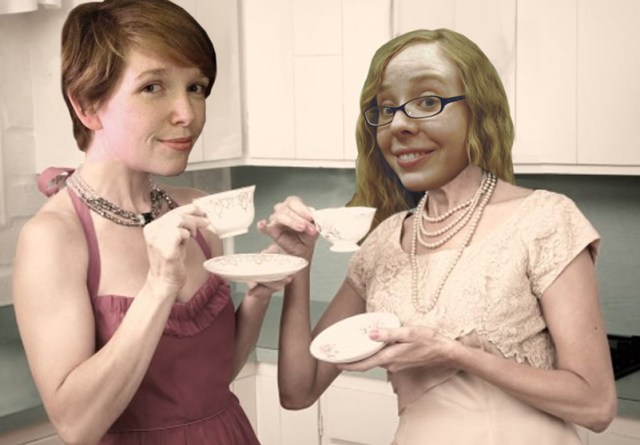
Sometimes I like my food the way that I enjoy my sexuality: unnatural. While I’m generally cautious about what I put in my mouth (yup), I’ve always had a thing for brightly coloured food, whether it’s artificially coloured candy floss from pasar malams (night markets) or the naturally occuring bizarreness of red cabbage (which gives you blue dye!). Now you might recall that a few weeks ago I taught you how to dye your hair all the unnatural colours you could possibly want, and what I didn’t say then is that if you dye your hair teal/purple/pink like I do, one of the most frequent comments you’ll get is that your hair looks edible. It’s not. Don’t try it. But for days when ordinary food colours just aren’t doing it for you, everything on this list is!
1. Vegan Andes Mints
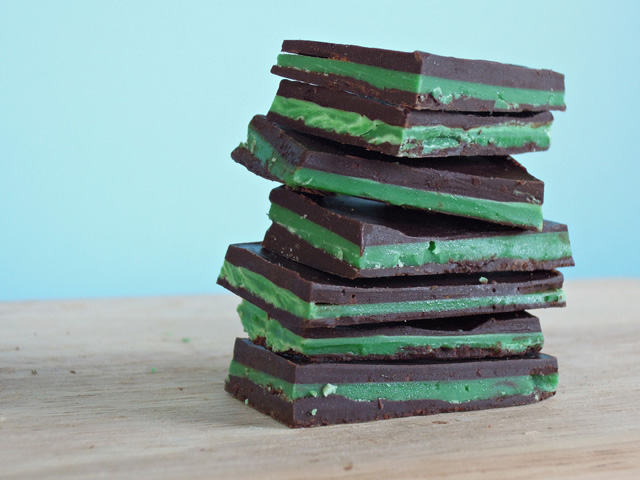
via Fork and Beans
2. Blue Raspberry Pineapple Slush

via Bakin’ Bit
3. Cotton Candy Popcorn
4. Cotton Candy Meringues
5. Gluten, Egg and Dairy-Free Rainbow Donuts

via Fork and Beans
6. Blue Velvet Cake with Cream Cheese Frosting
7. Blueberry Crumb Bars
8. Blackberry Ombre Popsicles
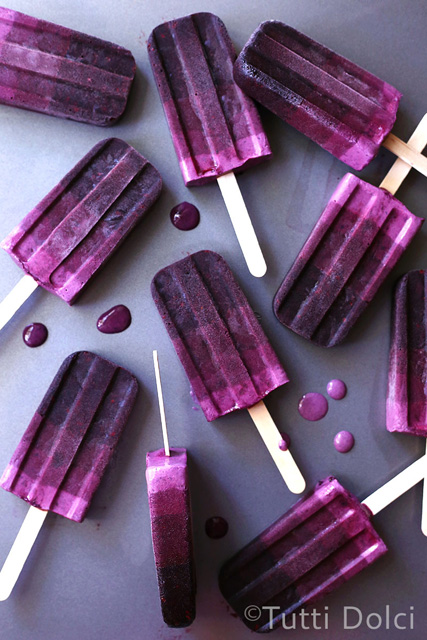
via Tutti Dolci
9. Mashed Purple Sweet Potatoes
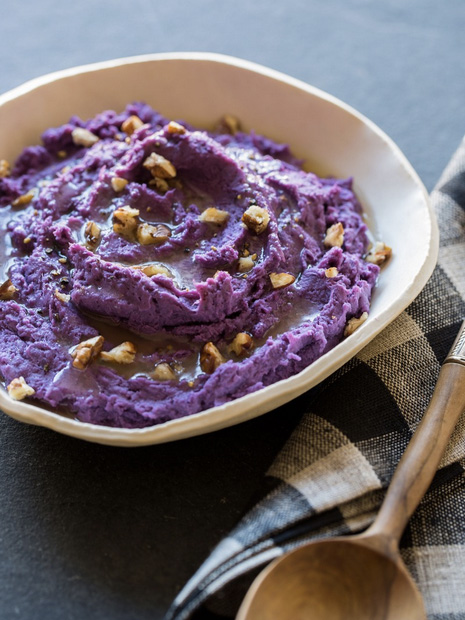
via Spoon Fork Bacon
10. Vegan Purple Yam/Sweet Potato Chocolate Cake & Frosting
11. Red Cabbage Chips with Tomato Yogurt Dipping Sauce
12. Ube Macapuno Cake
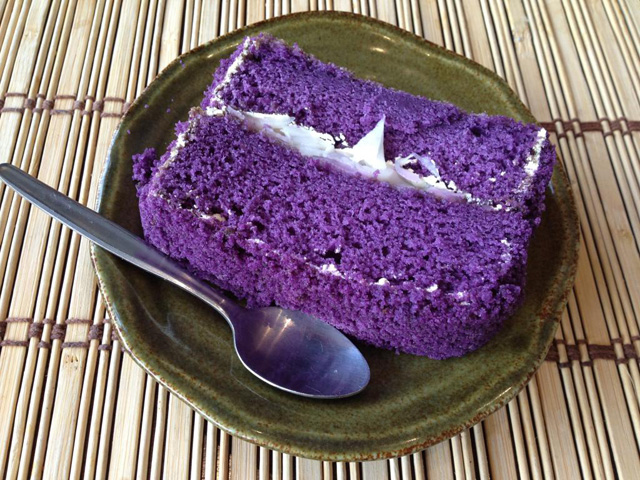
via The Bake-a-nista
13. Purple Sweet Potato and Cauliflower Soup
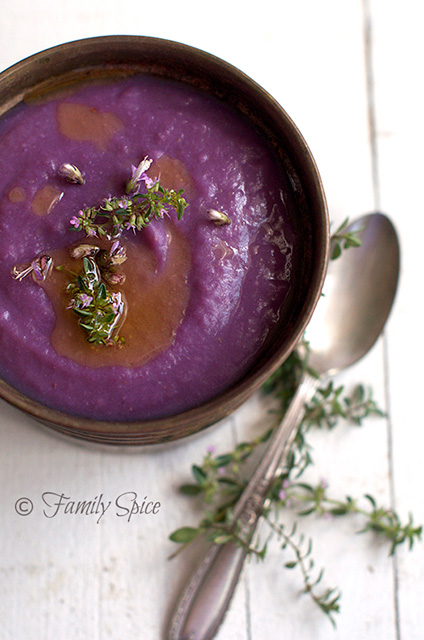
via Family Spice
14. Blueberry Cupcakes with Blueberry Cream Cheese Frosting
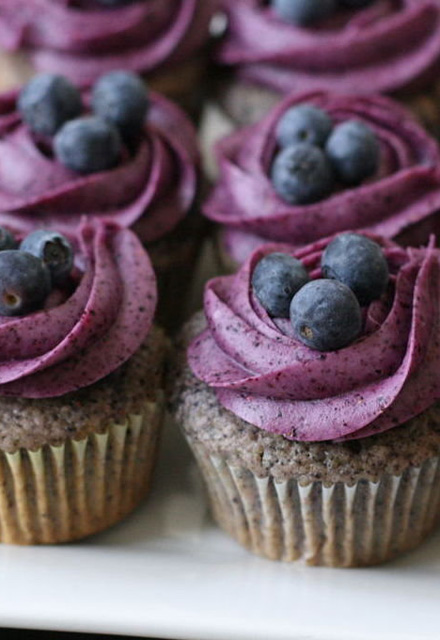
via STL Cooks
15. Beet Braised Lentils
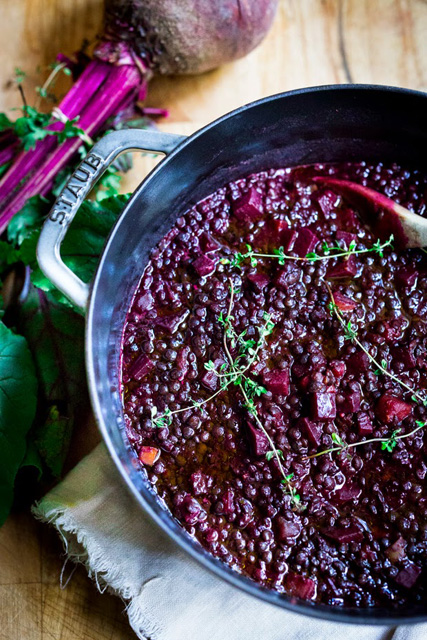
via Feasting at Home
16. Beet-Strawberry Smoothie
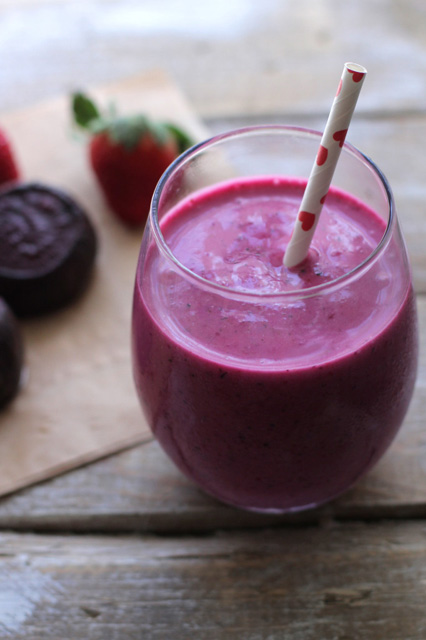
via Live Simply
17. Zingy Purple Potato Salad
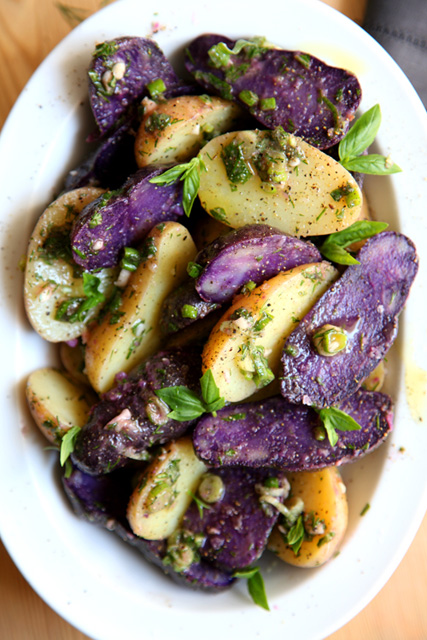
via Donal Skehan
18. Lavender Cupcakes with Honey Frosting
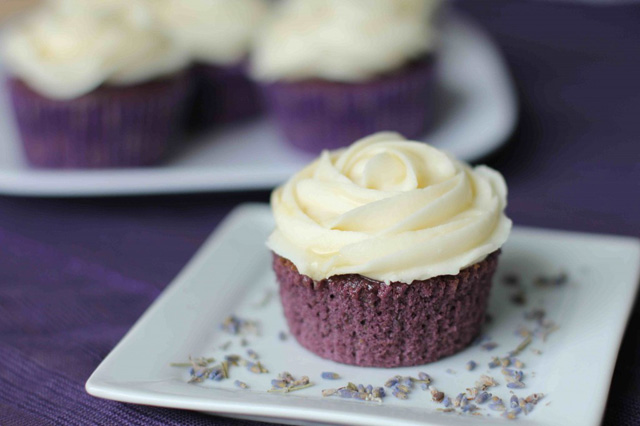
via Jessie Next Door
19. Purple Power Salad
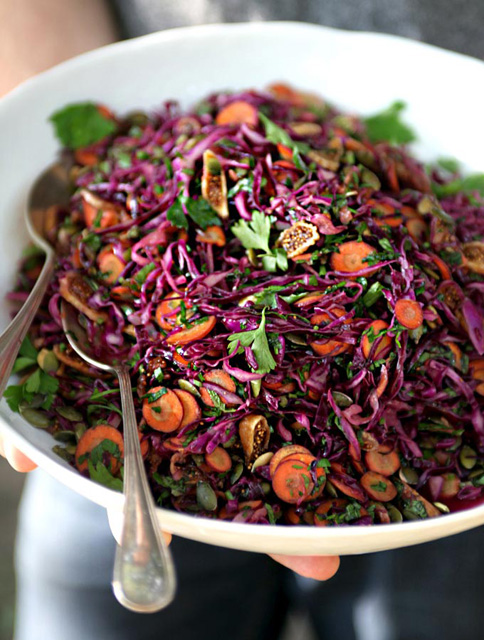
via My New Roots
20. Beetroot Risotto
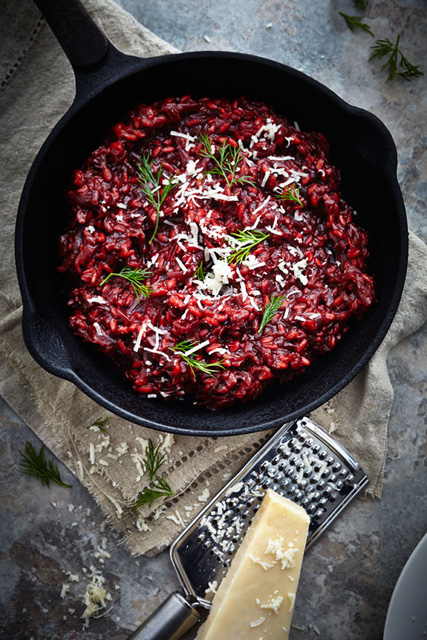
via Mowielicious
21. Beet and Goat Cheese Pizza
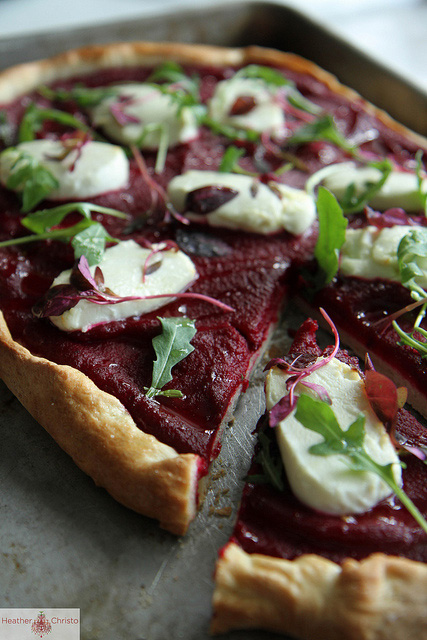
via Heather Christo
22. Sweet and Sour Red Cabbage
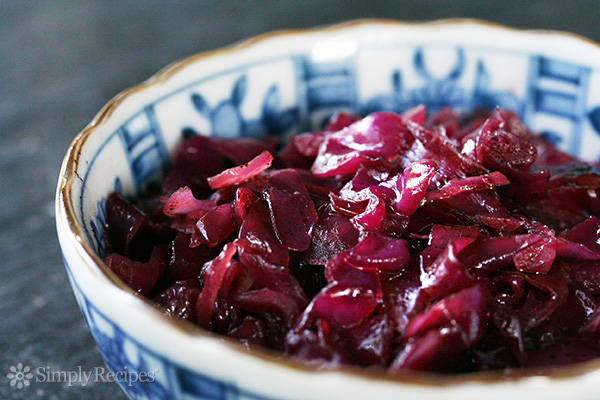
via Simply Recipes
23. 5-Minute Blueberry Coconut Frozen Yogurt
24. Blueberry Cardamom Cupcakes

via Sweetly Raw
25. Caramelized Onion and Beet Soup
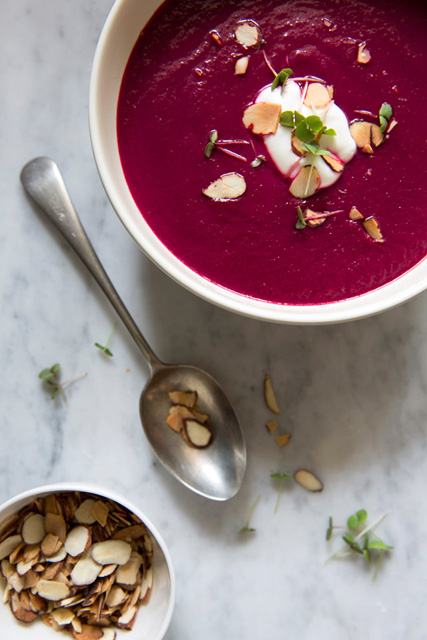
via Goboroot
26. Roasted Beet Pesto
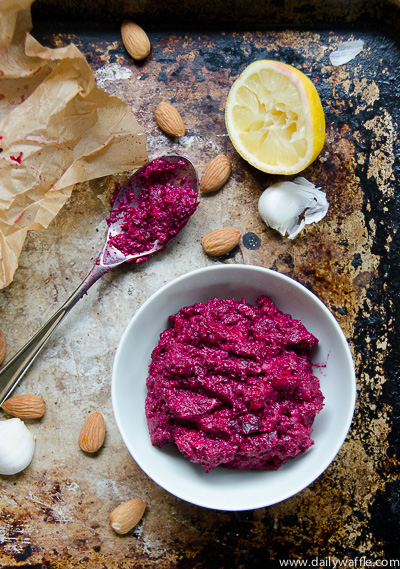
via Daily Waffle
27. Smoky Beetroot Hummus
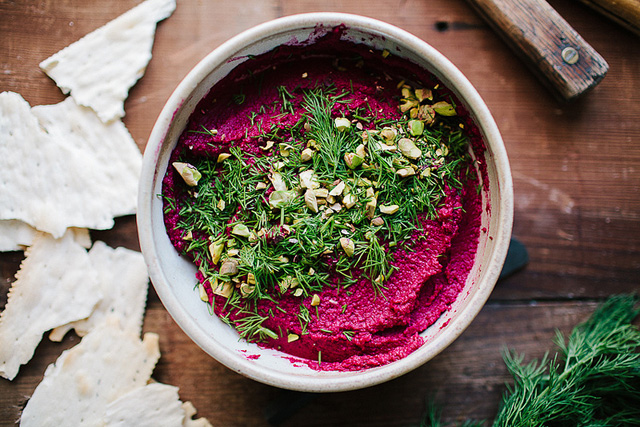
via The Year in Food
28. Strawberries and Cream Cake
29. Raspberry Coconut Macarons

via Cooking Classy
30. Healthy Red Velvet Fudge Protein Bars
31. Very Pink Raspberry Cosmopolitan
32. Strawberry Layer Cake with Whipped Strawberry Frosting
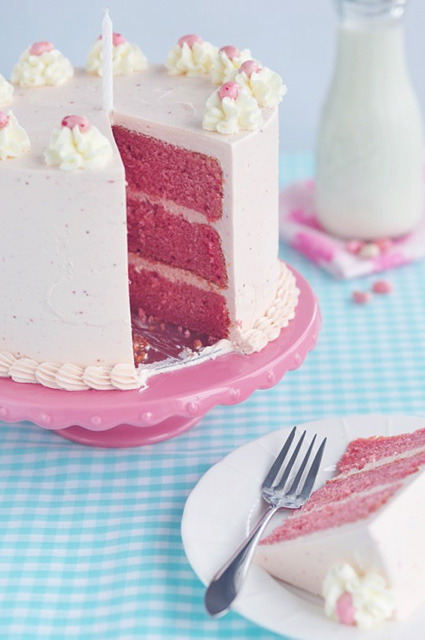
via Sweetapolita
33. Strawberry Chocolate Chip Cookies
34. Pink Ribbon Cinnamon Rolls
35. Strawberry Pudding
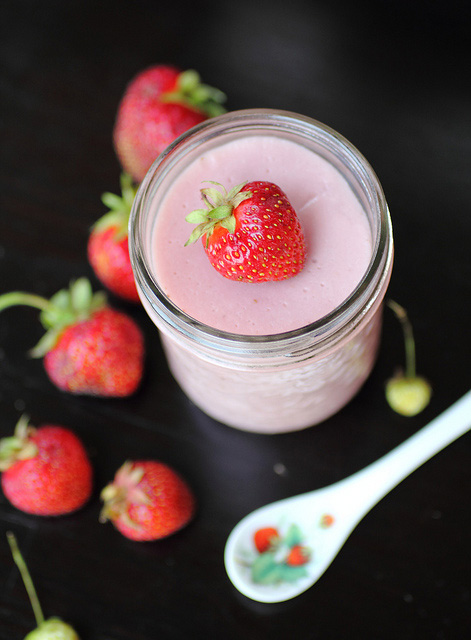
via Adventuress
36. Cotton Candy Creme Melts

via Mama Miss
37. Olaf the Snowman Snacks

via She Knows
38. Bluebird Cookies
39. Elsa’s Icy Blue Dessert Trifle

via Mom Endeavors
40. Red, White and Blue Candy Apples
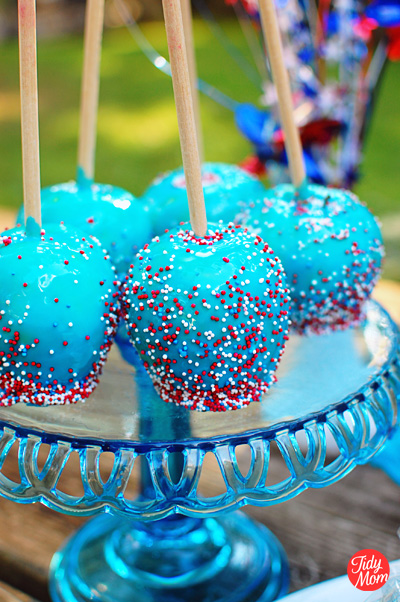
via Tidy Mom
This list was compiled with the help of my partner Natalie, who really wants “merbutch” to be a thing.
VIDEO: Malaysian Queer Band “Shh…Diam!” Is Anything But Quiet
Be prepared for the best thing to grace your computer screens today: Shh…Diam!‘s latest music video, “Julie Don’t Listen to Them,” contains all the queers in blazers, “happy hard core” and awkward glances you’ll need for the week.
The band started accidentally in 2009, when vocalist and lead guitarist Farah lied about having a band to get a gig. Since then they’ve been joined by Yon (guitar, vocals), Jellene (drums) and Yoyo (bass) to get the wonderfully quirky mix of jazz, metal and punk that makes up the staple of Malaysia’s queer music scene you see before today. Diam! means “quiet!” in Malay, though Farah says you probably shouldn’t put too much stock into it.
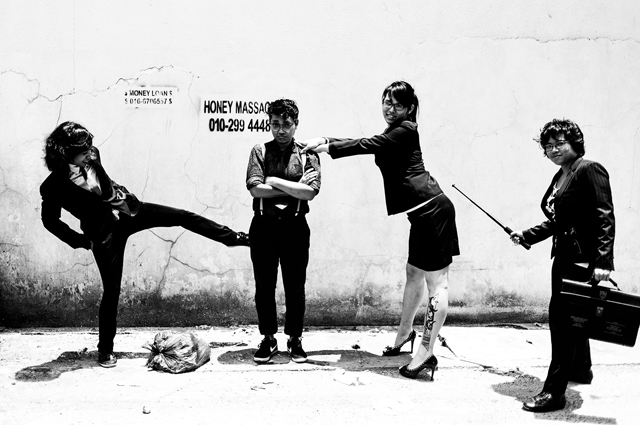
via Facebook
Catch Shh…Diam! on Facebook, Twitter or ReverbNation.
VIDEO EXCLUSIVE: Meet Maki Yamazaki, Your New Favourite Nerdy Queer Non-Monogamousaurus
Happy Thursday! Did you wake up today thinking g-d, I really wish I knew more about Britain’s trans folks? Of course you did. Were you specifically looking for a human with great hair and the ability to play more musical instruments than you have piercings in your right ear? Of course you were.
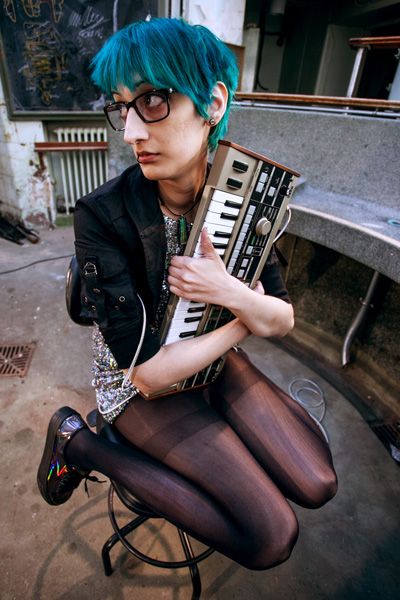
Photograph by Brian Hutchinson
Meet Maki Yamazaki, a games developer, musician and comic artist living in (her words) “the sunny metropolis of Glasgow, Scotland.” You might remember Glasgow from all those times sexy Detective Sergeant Sam Murray (Heather Peace) ran sexily past… things — okay maybe you don’t remember because you were staring at Sam, but. Y’know. You might not quite remember Maki, because she wasn’t there.
WELL SHE’S HERE NOW.
“Part raging workaholic, part non-monogamousaurus, Maki is also queer, trans, grey asexual, genderqueer and thoroughly nerdy.
She enjoys sci-fi, awesome narratives, feminism, peppermint tea and writing biographies in third-person. Playing some twenty five-odd instruments and still finding the time to get a few hours of sleep a night means that it’s possible that she’s actually an elaborate experiment in cloning.
If she ruled the world it would shortly thereafter be taken over by cats.”
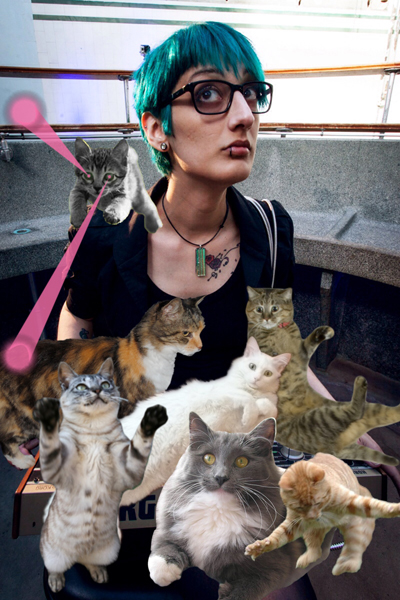
IT’S ALREADY STARTING
Photograph by Brian Hutchinson and CatPaint
Maki’s story is being launched today on this here website as part of Patchwork, a fresh short film series about British transgender lives, produced by All About Trans and Lucky Tooth Films in collaboration with Channel 4. Throughout autumn, 25 short films will be released weekly highlighting the many diverse and brilliant faces of Britain’s trans folks.
Filmmakers Fox Fisher and Lewis Hancox, the queer brains behind Lucky Tooth Films, began making films about trans people after they both met on My Transsexual Summer, which had a massive impact on raising trans awareness and starting a dialogue across the nation. With their passion for film and their personal experience on trans issues, they have gone from strength to strength, creating a powerful platform for life-story telling with people who would have never normally spoken to the media due to fear of misrepresentation. The people they’ve filmed with are models, soldiers, artists, musicians, activists, and psychics and they all just happen to be trans.
And now here’s Maki!
Check out Maki’s work on her website (no, there really doesn’t seem to be anything she doesn’t do), throw her some money on her Patreon funding page, and follow her @doctorcarmilla.
Denmark’s New Law Makes Legal Gender Recognition A Lot Easier
Gay Star News asks “Is Denmark’s new trans law the best of its kind in the world?” and the short answer is well, no. Not because the new law, which came into effect this week and allows people to change their legal gender without having to fulfill any surgical, psychiatric or medical requirements, isn’t a great step forward for trans rights and self-determination — but because Argentina beat them to the punch two years ago.
Nevertheless, the law is the first of its kind in Europe and could hopefully set a new precedent for the fair and humane treatment of trans people in the region. It turns the individual battle for legal gender recognition from a harrowing, invasive experience of “proving” your identity to skeptical doctors or judges to a straightforward administrative procedure that allows you to receive a new personal identification number and matching personal documents, like passports and driving licenses. While far from being a panacea for anti-trans discrimination, legal recognition goes a long way in facilitating trans citizens’ access to public services and employment.
“It will make life easier and more dignified for the individual, for example when you are asked for ID in shops,” said Minister for Economics and the Interior Margrethe Vestager when the law was passed in June. The Danish government added that the move was part of an international trend towards “easing the conditions for legal sex change(s),” possibly referring to a World Health Organisation (WHO) report released earlier this year which condemned the forced sterilisation of trans and intersex people.
Europe doesn’t have a great track record on trans rights: while Sweden was the first country in the world to allow legal gender changes in 1972, sterilisation was mandatory until the law was amended in 2013. Twenty European countries still enforce sterilisation as a legal prerequisite for gender recognition, including Finland and Norway (where only one hospital is authorised to issue psychiatric diagnoses and perform gender confirmation surgery), and many require that trans people divorce their partners or convert their marriages to civil partnerships due to laws governing same-sex relationships. Other countries like Ireland and Belarus lack provisions for trans people altogether. In December 2013, the Netherlands passed a law eliminating hormonal therapy or surgical requirements for legal gender changes, but trans people must still apply for a medical document.
Transgender Europe (TGEU), which runs a Europe-wide campaign advocating legal gender recognition, welcomes Denmark’s latest move. However, some aspects of the law still leave much to be desired.
First, the law requires that applicants wait out a six-month “reflection period,” ostensibly to stop people making “hasty decisions they would later regret.” TGEU argues that this makes it difficult for trans people to change their documents quickly when necessary while also “[perpetuating] misconceptions of trans people as being ‘confused’ about their gender.” Many, if not most, people are secure in their gender identity and should be trusted to know what they want reflected on their personal documents. Yet it’s also true that some people just aren’t sure, get it “wrong” or change their minds later on — but why not codify, instead of condemn, this fluidity in gender laws, allowing people to make changes as they see necessary? After all, there’s still a lot of weight given to genders assigned at birth and the state doesn’t paternalistically tell parents to hold off on that even though it surely counts as a “hasty decision” that some later regret.
Second, legal gender recognition procedures are available only to those over the age of 18, which excludes a particularly vulnerable group of young trans people from education and employment opportunities as well as impeding their self-determination. In contrast, Argentina’s laws have been applied to a girl as young as 6 as the Children, Youth and Family Secretary ruled that children under 14 are capable of giving consent.
Finally, the law still does not recognise non-binary genders or intersex identities, or allow the gender field to be left blank. Australia and New Zealand allow people to mark their passports with “X” instead of “M” or “F,” Pakistan recognises the khawaja sara as having a “third gender” on identity documents, while Germany and New Zealand allow the gender field on birth certificates to be left blank for later self-determination.
TGEU “encourages the Danish government to closely monitor the implementation of the law and to remove all provisions that delay quick access to legal gender recognition.”
Female Students Arrested in Malaysia, Suspected of Criminal “Same-Sex Relations”
Two female students, aged 20 and 21, were arrested early Sunday morning by enforcement officers of the Johor Islamic Religious Department (JAIJ) on suspicion of having had “same-sex relations” in a hotel room in Johor. The pair was among eight couples detained in Operasi Ambang Merdeka on the dawn of Malaysia’s Independence Day, 31 August.
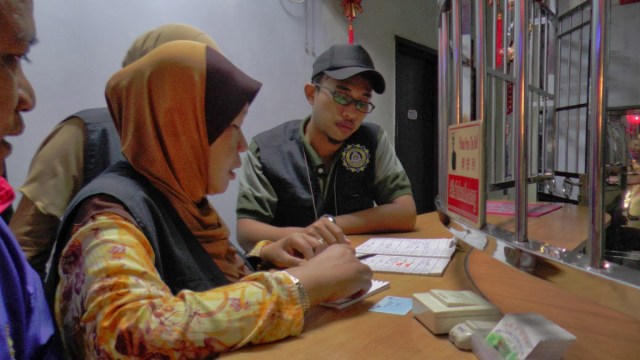
Members of Johor’s Islamic Religious Department
via Isu Terkini
Sinar Harian reported that when officers came to the door, one answered while the other was in the bathroom. While the authorities initially had no reason to be suspicious of khalwat (unlawful close proximity), they became suspicious when the pair remained silent as their room was searched. They then found a sex toy, which was seized together with a laptop.
One of the students said that the toy had only recently been bought online and unpackaged, and that they had not yet used it. They were then booked at the Johor Jaya Police Station before being taken to the JAIJ office.
According to JAIJ’s Assistant Director of the Enforcement Division Mohd Zamri Kambari, who led the morning’s raids, the pair has been arrested under Section 26 of Johor’s Syariah Criminal Offences Enactment 1997, which criminalises lesbian sex. They may be subject to a fine of up to RM5,000, jailed up to three years and subject to six strokes of the cane.
Sisters in Islam (SIS), a non-governmental organisation that works to protect Muslim women’s rights and challenge discriminatory syariah laws and practices in Malaysia, condemns irresponsible reporting by Sinar Harian, which broke the story, and wants proper legal representation for the two women. The Malay daily identified the students’ school and published a (partially censored) photo, further identifying them not only as a lesbian couple but also alleging that they had committed musahaqah, the sin (and crime) of female same-sex sexual relations.
SIS legal officer Rashidi Abd Rahim argues that prosecutors must prove that a criminal act had actually taken place. “The investigation has not even concluded and the paper is already judging them guilty.”
Stonewall Begins Work On Trans Inclusion, Asks for Your Feedback
On Saturday, Stonewall, the UK’s largest LGB charity, made its first steps towards redressing its long-standing exclusion of the trans community by hosting a conference attended by around 50 transgender activists and community members. Participants discussed what trans inclusion could or should look like as the start of a three-month consultation period around trans issues, which will culminate in a preliminary report in January 2015 and decisions on how to move forward from April 2015.
Fox Fisher (@SaluteHQ), co-director of My Genderation, produced a video summary of the day’s events featuring interviews with participants:
https://www.youtube.com/watch?v=Wd14bixutu8
Stonewall Chief Executive Ruth Hunt began the meeting by acknowledging the harm Stonewall in England and Wales has inflicted upon or has otherwise been complicit in causing to trans people, including honouring TERF journalist Julie Bindel, using a transphobic slur in their anti-homophobia film Fit and collaborating with Paddy Power, which recently ran a transmisogynistic ad. (The group’s northern counterpart, Stonewall Scotland, already includes trans people in its activism and research.) She added that she believes the consultation process should not be guided by cis people.
According to detailed accounts by Jane Fae (@JaneFae, Gay Star News) and many others as collected by UK Trans Info, participants discussed three possible ways in which Stonewall could work with trans people:
- Stonewall becomes a full LGBT organisation
- Stonewall helps set up a sibling (linked but autonomous) organisation led by trans activists, providing it with initial resources and training
- Stonewall remains an exclusively LGB charity but provides grants to existing trans organisations
Most rejected option 3, favouring instead the possibility of combining the best of options 1 and 2: allowing trans activists full access to the resources and lobbying power of the country’s most successful and visible LGB rights group to date while also ensuring autonomy and equal participation. The objective of the conference was not to come to any conclusive decisions; instead, participants outlined their visions and flagged areas of concern, including the need to recognise the heterogeneity of trans people and narratives as well as safeguards to ensure trans inclusion in Stonewall isn’t merely contingent on the beliefs of whoever happens to be in charge at any one point in time.
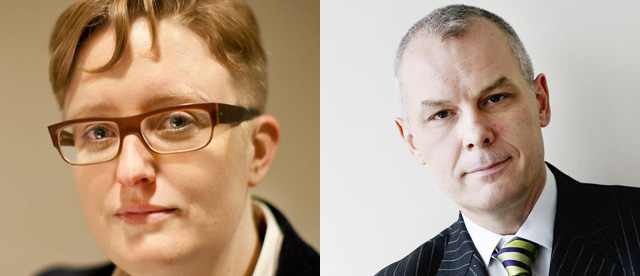
Unlike his successor Ruth Hunt (left), who took the reins earlier this year, previous Stonewall CEO Ben Summerskill (right) did not believe the interests of trans people fell under the remit of the charity.
via The Mirror / The Guardian
Prior to the meeting, Ruth Pearce (@NotRightRuth, Writings of a Trans Activist) highlighted some of the specific concerns trans people in the UK face, including access to healthcare resources (transition-related or otherwise), the impacts of austerity, and lack of important localised data. Trans activists, she notes, severely lack funding, resources and knowledge to do research and lobbying work at a level comparable to Stonewall.
Participants were generally optimistic about the outcomes of the conference.
CN Lester (@cnlester, a gentleman and a scholar) and Kat Gupta (@mixosaurus, mixosaurus) raised the issue of the lack of diversity of the participants in terms of race, class, age, ability and so on — a concern the latter brought up even before the conference happened given its closed door, invitation-only status — as well as the lack of intersex participants and information on accessibility provisions. Far from being exclusive to trans organising, however, these problems are endemic in LGBT activism in the UK. While Stonewall stressed that this meeting was the first of many and that it remains open to all feedback from trans people, the demographic make-up of its first conference belabours the point that intersectionality requires proactive effort, not simply lip service: it’s not enough to expect marginalised people to participate in open calls; organisations need to seek them out and consciously create welcoming spaces for them.
There are further concerns about Stonewall’s broader politics and actions, which include honouring the Home Office as a Top 100 LGBT-Friendly Employer despite them routinely deporting LGBTQI asylum seekers and hosting champagne gala fundraisers that are a far cry from the material realities of most queer people in the country. Yet this too is an issue that extends beyond trans activism and illustrates how there is no single vision for trans involvement in Stonewall: while some may have very good reasons to continue to distance themselves from the charity, others like Paris Lees make the case that “trans people need Stonewall, and they need us too.”
Stonewall now wants to hear from everyone who has a view on its future engagement with trans issues and people, whether positive or negative. They’ve committed to holding more group meetings, particularly with underrepresented groups within the trans community, and are willing to host one-on-one conversations with those who’d be most comfortable with this arrangement. E-mail trans@stonewall.org.uk, fill in the feedback form on their website or call 08000 50 20 20 to participate in the consultation process.
How To Dye Your Own Hair Every Color You’ve Ever Wanted At Once
Following in the footsteps of every uni student cliché before me, as soon as my parents dropped me off in the tiny box that would be my room for my first year out of the family home, I shaved off most of my hair and turned what was left of it purple. I say this casually, as if the process was pain-free and smooth sailing all the way — when in reality my first time had me bent over the sink in said tiny box while a friend poured jug after jug of too-cold water over my newly (and unevenly) blonde, frizzy hair. BUT three years on, I can now safely say that I know enough about dyeing my hair to at least remember not to stain the bathroom tiles.
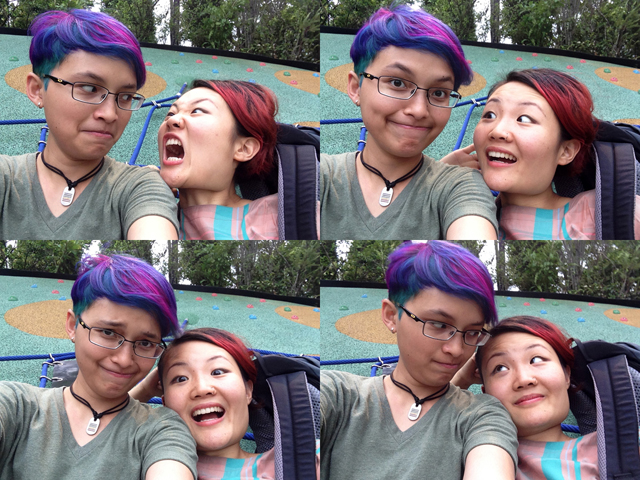
And I’ve found a partner in crime!
IMPORTANT DISCLAIMER: I’m not a professional hairdresser. Always follow the instructions provided by the manufacturer, and if in doubt, consult a qualified professional. However, there is very little to the process that requires specialist expertise, so don’t be scared off! My partner and I have gotten a fair amount of practice in and learnt how to do more complicated colour combinations, but I’ve done this even with friends who’d had no prior experience at all. Doing your hair yourself is fun, much cheaper than going to the salon, and probably only moderately hazardous to your health.
Step One: Bleaching
I’ve known more than one person who’s said things like, “I dye my hair so frequently I’ve forgotten what the original colour is” and I’m never quite sure how to respond. Is this a really roundabout humblebrag? Do these people never look in the mirror, wildly stabbing at their scalp every time they sense their roots have grown out? My hair is black, so bleaching isn’t optional. Some people have success getting tinted hair by just dyeing unbleached hair, but bleaching is the best way to get bright, long-lasting colours.
Before we begin, here’s a few things to take note of:
- This how-to assumes you’re bleaching your hair as a first step to dyeing it other colours. While it’s possible to lighten your hair to platinum blonde, etc. at home, it’s also pretty hard to do evenly, so if you’re doing this (especially for the first time!), maybe lower your expectations.
- If you’re using permanent hair dye (instead of temporary or semi-permanent ones like Manic Panic), the dye might already contain peroxide and/or ammonia to lighten your hair. I didn’t run into any issues this one time I bleached my hair before using Herbatint dye, but it might be different for you. Try to avoid ammonia in hair products.
- The effects of hair bleach are permanent. Bleach oxidises the melanin in your hair (turning it from your natural hair colour to colourless) so there is no way to go back to the original colour until new hair grows out. There’s no getting around it: bleach smells terrible and feels terrible and will make you wonder why you’re putting yourself through this. But the end results will make you feel awesome about yourself and even if it messes up, hair always grows back!
Preparation
Keep your hair as clean and healthy as possible. Avoid using hair products and heat styling tools, and try not to bleach your hair too soon after other chemical treatments like hair relaxing. Condition! And then condition some more — but not too soon before bleaching, because conditioner coats hair cuticles and makes it harder for the chemicals to work. Shampoo your hair about a day before bleaching, so it’s clean but your hair has some time to build up sebum to protect your scalp.
Decide on the strength of the bleach you want to use. Hair bleach usually comes in two parts: bleach powder and cream/clear developer. The volume of the developer affects the strength of the reaction that lightens your hair.
- 20 vol: for light-coloured hair
- 30 vol: for medium/dark-coloured hair
- 40 vol: for very dark hair
Most guides recommend that you don’t use 40 vol developer and that you don’t bleach black hair (especially if it’s been dyed black). I do all of these things regularly with reckless abandon and great results. If risking the health of your hair for vanity and convenience isn’t your thing, try using 20/30 vol developer and bleaching your hair multiple times instead.
Get bleach! Boxed kits are great for getting started: Manic Panic (US) and Directions (UK) are popular options. We’ve also experimented with perfumed bleaches like GATSBY Ex Hi Bleach but found the artificial smell even more offensive — might work for you though. These kits contain all the equipment you need, but you’ll need more than one box if your hair is long or thick. For a more economical option, you can buy bleach powder and developer in larger quantities and mix them as needed.
Do a strand test. This is especially important if you’re using a new product, have previously bleached/dyed your hair, used henna or have skin conditions/allergies. I’ll admit I usually skip this step because I’m not too fussed about what colour my hair ends up since I move on immediately to dyeing, and neither my partner nor I have reacted badly to bleach despite having eczema and psoriasis respectively. But your mileage may vary, of course, and bleaching is by far the most destructive step in this process so take all the precautions you need to feel confident you’re not about to melt your ALH off.
Process
Cover everything. Bleach will ruin your hands, clothes and rental deposit. Wear gloves and apply Vaseline to your ears and hairline; if you have cartilage piercings that you want to keep covered, use cling wrap. Use plastic sheaths or newspaper to line your working area and cover your back and shoulders. Don’t wear anything you’re going to miss if bleach falls on it; tops with a wide neckline are good so you can get it off without it brushing your hair. (Plus there’s always the option of not wearing anything.) Always, always use bleach in a well-ventilated place, unless you enjoy entertaining paranoid thoughts about your imminent death brought on by inhaling noxious fumes.
Mix the bleach powder and developer in non-metal containers. Mix the dry into wet (which I always do wrong). If no instructions are provided, the powder and developer should be added in roughly equal proportions till no lumps of powder remain and the mixture approximates the consistency of buttercream frosting. Getting the ratio exactly right isn’t super important; you just want it smooth enough to spread and not too dry.
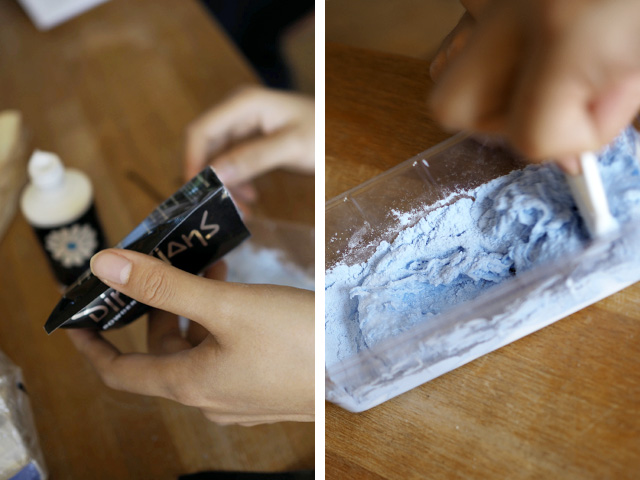
Section and clip/tie up your hair (again, no metal!). Bleach is quite thick and doesn’t work itself into hair easily. I find it easiest to tie the top part of my hair up with a rubber band and then pull out small amounts at a time, but a more common method, especially with thicker/longer hair, is to use clips to section the hair into quarters. It’s a lot easier to do this with a partner so you can make sure nothing gets missed, but if you’re on your own, set up two mirrors so you can see the back of your head.
Work from the bottom up with a plastic brush or your (gloved) fingers. This seems counterintuitive, but the tips of your hair will take the longest to process because they’re the farthest away from the heat of your head. To get a more even colour, apply bleach to your roots only 5-10min after you’re done with the rest of your hair. (This also reduces the risk of chemical burns from too-strong bleach getting into contact with your scalp.)
Do NOT bleach your eyebrows. This shit will blind you.
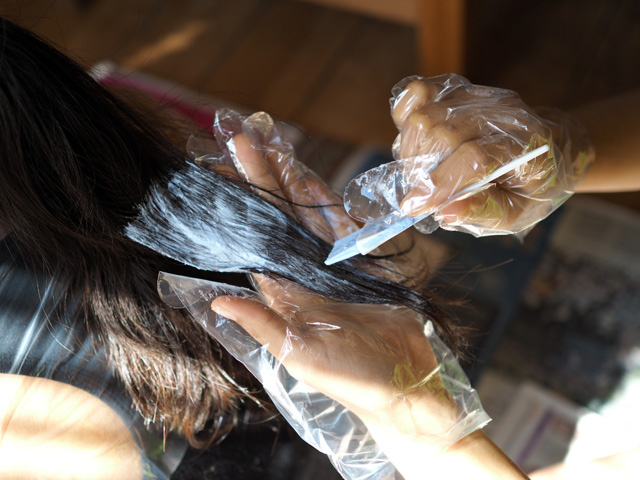
Keep a close eye on processing time. Bleach might act faster on your head than during the strand test because of your body heat. To prevent the bleach from drying out and to speed things up a little, wear a shower cap. You can also use a hairdryer, but I don’t recommend it because it can make your hair really brittle. Try not to leave the bleach in for more than 30min — an itchy scalp is normal, but stop immediately if it feels like it’s burning.
Rinse the bleach from your hair with cold water and shampoo. No matter how healthy your hair was, bleach will make it feel like straw, I’m sorry! Don’t worry though, it’s nothing deep conditioner won’t fix. If you’re going to bleach your hair again or dye it immediately after, save the conditioner for later.
Bleach again (if necessary). Ideally, you should let your hair rest for about a week — with plenty of conditioning — before bleaching it again. Realistically, if you’re anything like me, you’ll be unwilling to live more than two hours of your life blonde(ish) and want to get it all done in one go. I’ve never had problems bleaching with 40 vol developer twice in a day (and thrice with 30 vol), but as always, be very careful if you’ve not done this before.
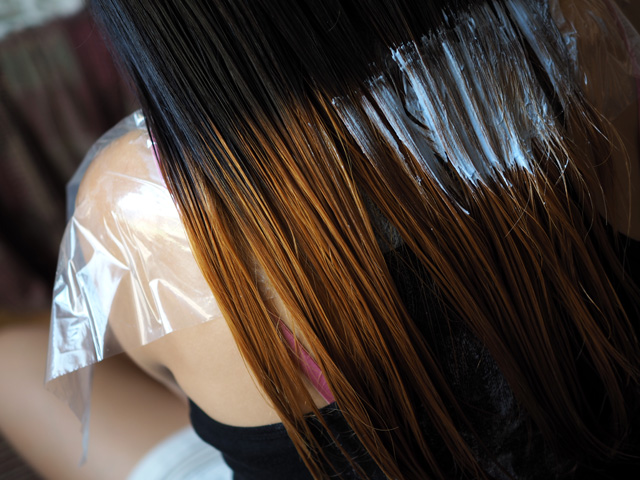
This is what happens when you don’t take your own advice: as you can see, the tips are darkest because we didn’t start from the bottom. (Also, that tank top is no longer black.)
Use toner (if necessary). Toners are essentially very dilute hair dyes that help to remove the yellow/orange tones that remain after bleaching. Lilac (also called white) toners neutralise yellow tones, while blue toners neutralise orange tones. If you’re not dyeing your bleached hair, purple shampoo works as a long-term solution to remove brassy tones. A cheap alternative to all of this is to mix a bit of violet (bluish purple, not reddish purple) hair dye into regular conditioner and work it into your hair, and if you have green-toned hair (usually from swimming in chlorinated pools), some people swear by tomato juice. Keep an eye on your hair — if you overprocess it, it’ll take on the colour of your toner. To be honest, though, we’ve had very poor results with toners and find it to be an unnecessary use of time and money.
Step Two: Dyeing
Preparation
Wash your hair with clarifying shampoo. Unlike bleach, dye (probably) won’t do horrible things to your hair but you do need to remove build-up and oils so it gets absorbed better. Hot water helps to open up your cuticles.
Choose the right colour. Hair dyes are translucent, so choosing what’s appropriate for your hair is a bit more complicated than you’d expect. (I learnt this the hard way.) Here’s a simple colour wheel:
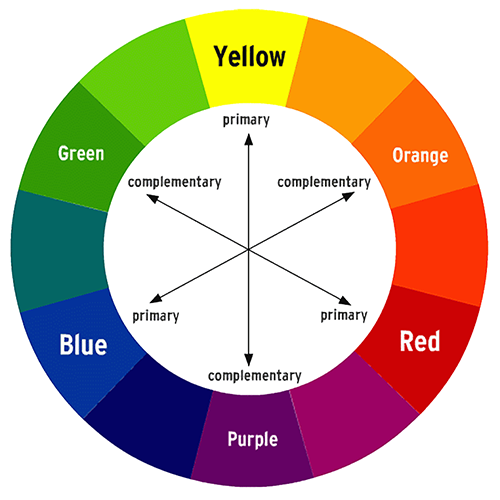
These are the main colour types/relationships to be aware of:
- Primary colours (red, yellow, blue) are colours that cannot be made of other colours. This is pretty 101, but if you’re planning to mix dyes together, it’s worthwhile to invest in primaries.
- Complementary colours (on opposite sides of the wheel) neutralise each other. When used in small amounts (as in toner), this can help to remove the faded remnants of your last dye job and give you a paler base to work with. BUT if you use say, green dye on red hair, you’ll just get a muddy, unappealing brown. Streaks of complementary colours in your hair give you strong contrast.
- Analogous colours (next to each other on the wheel) boost each other’s depth and vibrancy. Streaks of analogous colours give you smooth harmony, as well as what is described as “cool” (green, blue, purple) or “warm” (red, orange, yellow) blends. My current hair colour is a mix of Directions turquoise, cerise and plum (or as Natalie calls it, “merbutch”) and it’s definitely my favourite to date.
- Monochromatic colours are tints, tones and shades of the same hue. To get a lighter, pastel shade, you can mix your hair dye with an appropriate toner or conditioner. These slow down how quickly the dye gets absorbed into your hair.
To minimise the amount of processing you put your hair through, work around the wheel (e.g. from blue to purple to red hair). Mix dye as you please, but it’s best if you mix the same brands together and don’t mix different types (e.g. permanent and temporary) because they’re made of different stuff.
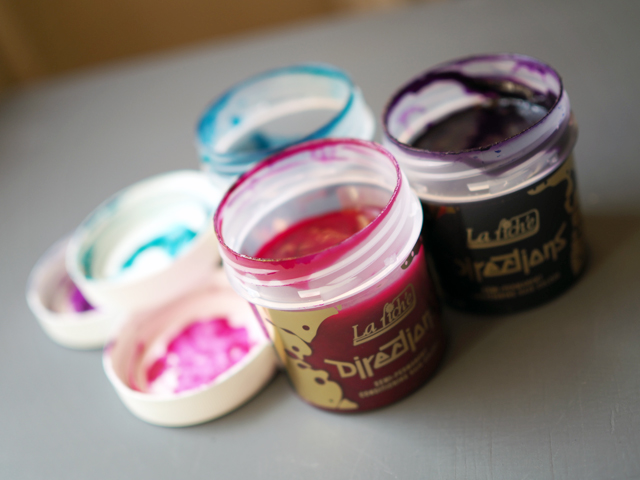
Get hair dye! I really love Special Effects and Directions, and have had less luck with Manic Panic though it seems to be a lot of people’s go-to semi-permanent brand. It’s unlikely you’ll find the more unnatural (and better) colours at standard hair salons, so if you want to buy them in person try to find the kind of shops where they sell 394209 kinds of piercing jewelry and studded belts and everyone dresses in (faux) leather. Are they called punk shops? Goth shops? I am clearly too uncool to know this.
Do a strand test. This not only helps preempt any skin reactions or other hair health issues (as with the bleach), it also serves a preview of what the dye’s actually going to look like on your hair. Fair warning: while turquoise is lovely and everyone wants it in their hair, it also often shows up as green unless you start from a very pale base and tends to fade very quickly.
Process
Section your hair and paint the dye on with a brush. Use a toothbrush (or even just gloved fingers) if you don’t have a dedicated plastic hair dye brush. It’s really fun, like an art project!
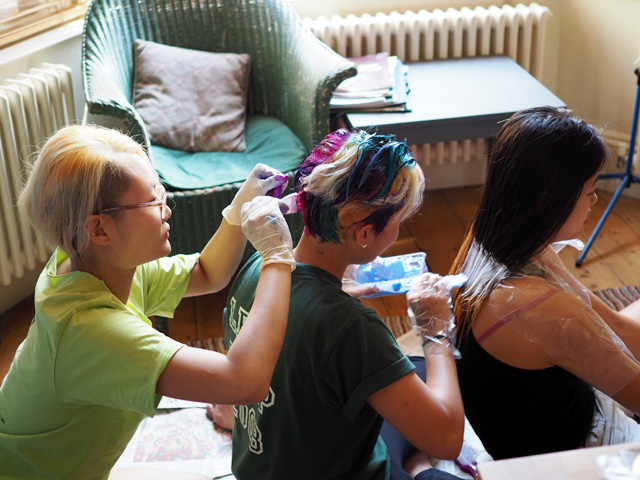
My kind of three-way.
If you’re using more than one colour or high/lowlighting your hair, there are plenty of ways you can do it:
- Get a highlighting cap or poke holes through a shower cap, pulling each section of hair that you want to dye out through the plastic. This is the best way to make sure nothing you don’t want dyed gets dyed, but figuring out which strands to pull through can get confusing.
- Wrap each dyed section in foil. This gives you a better sense of where to apply dye, but is messier than the cap. Cut the foil before you start dyeing to make the process less exasperating.
- Coat sections that you don’t want dyed in conditioner or petroleum jelly. Semi-permanent dyes don’t stick to these bits. This is useful if you want Rogue (of X-Men)-style hair.
- Just paint it on. This is how my partner and I do our hair because we want the colours to blend together, not show up as distinct streaks. (Also because we’re lazy. Mainly because we’re lazy.) If you’re doing it this way, be prepared to get messy — clip/tie up the sections that are done to get them out of the way, or just get in there with your fingers.

Combing through the hair as you go along helps to make sure you get to every strand but if your hair is feeling fragile (especially after bleaching), don’t push it.
Leave the dye in for as long as you want IF it doesn’t have any developer in it. (If it does, don’t exceed the processing time stated on the box.) Put a shower cap on and use a hairdryer to help the colour set better. Some people choose to leave the dye on overnight, but I think that’s a colourful accident waiting to happen. With most semi-permanent dyes, leaving them in for longer doesn’t damage your hair but you might get a much darker colour than you’d bargained for — it’ll fade with a few washes though.
Rinse the dye from your hair with cold water and shampoo. It’s gonna be messy: back when I used Special Effects’ Blue Velvet (one of the longest-lasting dyes I’ve ever tried) regularly, my bathtub would look like a Smurf murder scene. At this point I usually get quite distressed that none of the dye is sticking because my hair’s short enough (and my eyes myopic enough) that I can’t see any of it while a seemingly endless stream of dye bleeds out into the water, but don’t worry, it’s still on there. Probably.
Condition! Conditioner is just so good for your hair, you guys.
Clean any hair dye stains on bathroom tiles, etc. before the dye dries. When the dye’s still quite dilute often just soap, scrubbing and running water does the job, but I also use nail polish remover for more stubborn dried stains. The stuff on your hands will wash off eventually.
Step Three: Aftercare
Don’t wash your hair too much, but condition plenty. Semi-permanent dyes fade with each wash. Shampooing your hair excessively makes it drier and more brittle, which is particularly a concern for bleached hair. On the other hand, you can’t condition too much! Conditioner helps to seal the colour in. Try to get colour-safe, sulfate-free shampoo and conditioner.
Add a bit of dye to your conditioner to maintain your colour. Or, if you need to neutralise certain tones in your hair (dye can act in strange and unpredictable ways, including changing colour upon exposure to sunlight or chlorinated water), remember the stuff about toners and the colour wheel.
Cover your pillowcases! Temporary and/or cheap dyes will bleed really quickly out of your hair, including when you’re sweating, but even the best semi-permanent dyes will probably stain your clothes/anything you rest your head on while your hair is wet.
Here’s a recap of the most important tips we’ve covered here:
- Do a strand test before trying any new chemicals.
- DON’T shampoo your hair right before bleaching.
- DO shampoo your hair right before dyeing.
- Work from the bottom up.
- Condition, condition, condition (but only after processing).
Now we’ve got the basics down but everyone has their special feelings about how to get their hair done exactly right (I know I do) — you’ll figure it out as you go along. Share your own tips and photos in the comments!
20 Singaporean Breakfast Foods You Can Savor At Home
Hold onto your eggs, we’re getting ready for Autostraddle’s International Brunch Weekend 8/23-24! Find a brunch meetup in your city or create your own by heading over to our events page. You can also load up on all things brunch by watching this space. From playlists to recommendations to personal essays, we’re writing all about the brunch experience. Get excited! BRUNCH.
In Singapore we play fast and loose with morning-time foods: if it’s served at a hawker centre before 11 (and especially if it’s sold out by that time) then you can have it for breakfast. So your first meal of the day could be toast or soupy noodles or fried dough… or all of them. In a pinch you can have any of these foods for “brunch,” though you should be aware that in this part of the world we call that “waking up at a time that disqualifies you as a productive member of society.” (My mother says this a lot less politely.)
Most of these foods are bought and consumed at inexpensive hawker centres or coffee shops — you don’t expect to spend more than $2-5 on breakfast, unless you’re at a hipster joint that commodifies nostalgia and puts it on your plate for five times the original price — but chances are you’re not anything closer than a long-haul flight to one so I’ve dug up recipes from the internet. The ingredients you’ll need (or frozen versions of some of the dishes, like prata) should be available at Asian grocery stores.
1. Kaya Toast and Half-Boiled Eggs
The rest of this list will be alphabetically ordered but kaya toast and eggs gets top spot because it is by far the Queen of Breakfasts — and really easy to put together at home! You can get kaya in stores (Gabriella has mentioned her favourite and Yeo’s is a household brand name in Singapore) or make your own, but I’m gonna be real with you and say no one makes their own because it’s a tonne of work.
2. Appam
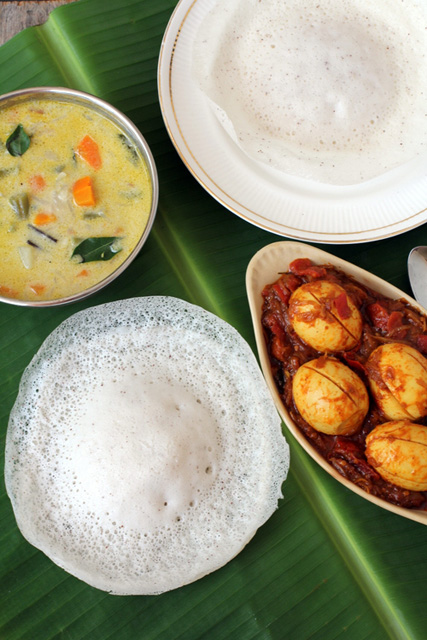
via Sailu’s Kitchen
3. Chai Tow Kway (Fried Carrot Cake)

via ieatishootipost
Spoiler alert: there’s no carrot in our carrot cake.
4. Chee Cheong Fun
Girlfriend: “If you make chee cheong fun from scratch for me, I’ll have to marry you.”
Me: “If you make tau huay from scratch for me, I’ll have to marry you. Thank god we’ll never do any of these things.”
5. Chwee Kueh
6. Congee (Rice Porridge)
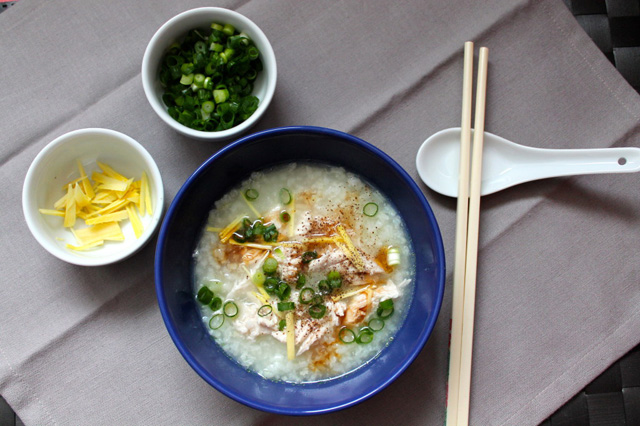
via Rice and Bread
7. Economic Fried Bee Hoon/Noodles
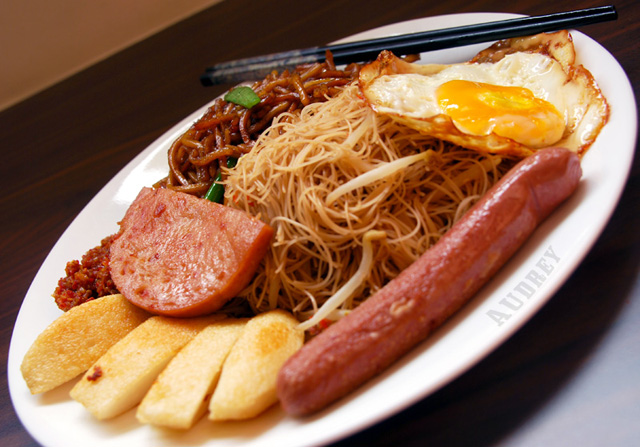
via Hungry Peepor
8. Fishball Mee Pok
9. Mee Goreng
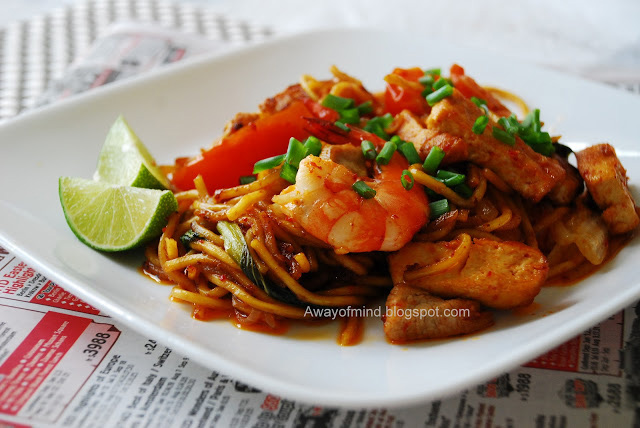
via awayofmind
10. Mee Rebus
11. Mee Siam
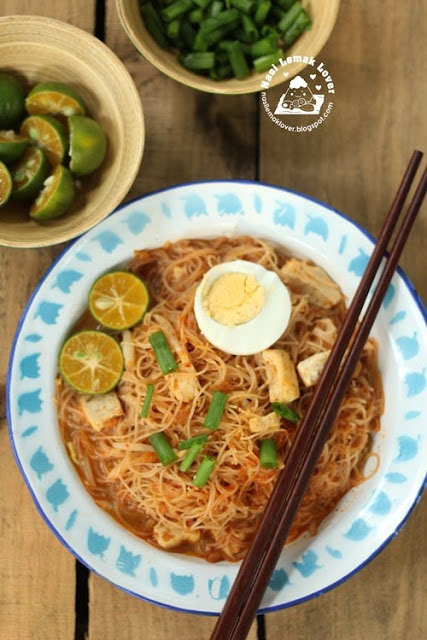
via Nasi Lemak Lover
12. Mee Soto

via myhiddenkitchen
13. Min Jiang Kueh (Peanut Pancake)
14. Nasi Lemak
15. Putu Mayam
16. Roti John
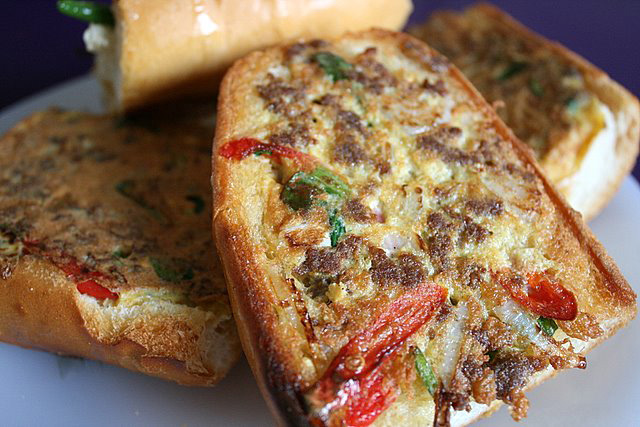
via Camemberu
“John” as in the name, yes — local legend has it that a long time ago a white guy asked a Malay hawker to make him a hamburger, and this was what the hawker came up with as a substitute. I can’t say I believe this particular story is true, but I can believe that a white guy would do that.
17. Roti Prata
Prata is called “roti canai” in Malaysia, referring to Chennai, where this dish is said to originate from. (Sidenote: Malaysians will inevitably claim that plenty of food on this list is Malaysian and not Singaporean, and they wouldn’t be 100% wrong — but I am also less concerned about the 3872982 petty conflicts that emerge between Singaporeans and Malaysians (food is a particularly touchy subject, but just one of many) and more into stuffing my face.)
18. Sayur Lodeh
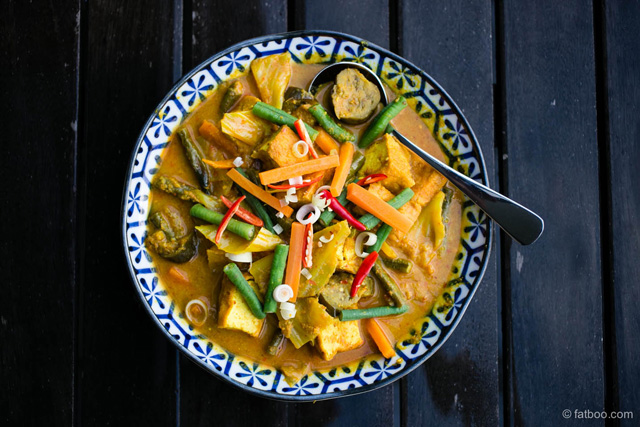
via Fatboo
This curry is usually eaten with lontong, a rice cake cooked in banana leaves. (If you can’t find it, any rice will do.) As a vegetarian, lodeh also makes up 90% of my Hari Raya diet while other people get food like ayam rendang.
19. Thosai
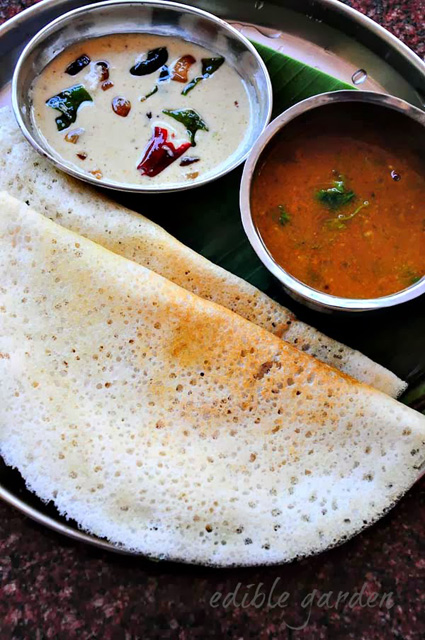
via Edible Garden
20. Vegetarian Fried Bee Hoon
Finally, a note on beverages: while I hear some of you (maybe just a couple) are into alcohol with your brunch, if you’re ever in Singapore, try your hand at ordering kopi (coffee) or teh (tea) from a coffee shop. It’s something I’ll admit I haven’t mastered, for reasons ranging from “as an ethnic minority I resist having to adopt a dominant language to order tea” to “I’m f-cking lazy.” But mainly it’s because I’m a Milo dinosaur person myself.
Women’s Refuges Shut Down Because of Men? Yes, But Not The Ones You Think
On Sunday, The Guardian‘s Sandra Laville published an in-depth report on the crisis of women’s refuges being shut across England and Wales. Between austerity-driven funding cuts and changes to government tendering processes that favour “more efficient” or “streamlined” (read: cheaper) generic services, refuges that provide specialist, therapeutic services to women fleeing domestic violence are struggling to stay open.
In a meeting with Home Secretary and former Minister for Women and Equalities Theresa May, women’s groups raised a number of concerns:
- The breakdown of the national network of refuges through local authorities imposing limits on the numbers of non-local women able to stay in them
- Time limits on length of stay
- Funding cuts because refuges do not take men
- Refuges being shut without alternative accommodation being provided
May claims that “there was a great deal of ignorance about the way domestic violence services were commissioned by local authorities,” but has repeatedly refused to “ringfence” or earmark funding nationally for refuges. The government has ended central funding of most DV support services and devolved responsibility to local authorities across England and Wales. Facing increasing demand without secure funding, the 2013 UK CEDAW Shadow Report (produced by a coalition of 42 women’s and human rights organisations) warns that access to specialist DV services, refuges especially, are becoming a “postcode lottery.”
Why Refuges?
The first women’s refuge opened in 1971 in Chiswick, west London, born out of a feminist movement that refused to be content with DV being hidden quite literally behind closed doors and recognising the unique concerns of women and children affected by violence in the home. In the words of Sandra Horley, Chief Executive of the charity Refuge:
Refuges are so much more than a roof over a head. Lives are transformed — specialist refuge workers support women to stay safe, access health services, legal advocacy and provide immigration advice.
Refuges also provide peer support — women are able to share their experiences and understand what they have been through. They realise, often for the first time, they are not alone, and they are not to blame for the abuse, Empowering women and children to overcome trauma and rebuild their lives is highly specialist, intensive work — it takes longer than a few weeks.
Women’s refuges in Exeter, Gloucestershire, Cheshire, Dorset, Somerset, Sheffield, Nottingham, Leeds and Leicestershire — just to name a few — are now being shut down in favour of non-specialist accommodation provided by housing associations and others, or nothing at all. Those that remain open have caps placed on funding or the number of beds that can be given to non-local women, or are asked to reserve beds for male victims (even if they’ve never had any men referred to their services). Local authorities are also increasingly focusing on early intervention and prevention strategies.
Restricting services to local women doesn’t address the needs of those who need to be as far away from perpetrators as possible to be safe, which is why charities are fighting for funding for a national network of women’s refuges. Furthermore, generic emergency accommodation is in no way comparable to the specialist support provided by refuges. According to Polly Neate, Chief Executive of Women’s Aid:
Without refuges, abused women who cannot stay at home are removed to hostel or B&B accommodation with no emotional support, no practical help to rebuild their life and no feeling of safety. Many would rather return to a violent perpetrator and know the risks they and their children face than live in such accommodation. Many will think “better the devil you know.”
It’s true that there is no “one size fits all” solution to ensuring the safety and rehabilitation of DV victims, and education and prevention strategies, as well as alternative means of protection such as the new DV protection orders (DVPOs), are important. But opinions vary significantly on how effective these strategies are and none of them can be a substitute for refuges. Funding decisions cannot be purely guided by cost-effectiveness and an idea of what “should” be the best course of action for DV victims. Yes, ideally, victims of DV should be able to stay at home. Yes, refuges are often the very last resort for victims, and most would prefer not to use them. But the fact that they’re DV victims should tell us in no uncertain terms that these are far from ideal circumstances, and refuges serve the most vulnerable women and children for whom the home is the most dangerous place to be. If we remove this last solace, the alternatives are often homelessness, further violence or death.
Why Women’s Refuges?
The Guardian report chose to give special attention to refuges that are being shut down because they don’t cater to men, such as Haven in Coventry and The Wolverhampton Haven. The shift in focus to male victims has been condemned by women’s charities as misguided and deeply flawed.
It’s commonly quoted that 1 in 4 women and 1 in 6 men will experience DV in their lifetimes.
This statistic is taken from the British Crime Survey (BCS), and in particular, DV charities and authorities tend to rely on data from the 2004 review of the 2001 BCS by Sylvia Walby and Jonathan Allen. (The BCS is done yearly, but this report is thus far the most in-depth study into DV statistics in England & Wales.) The report found that “26% of women and 17% of men had experienced domestic violence since the age of 16” — the numbers are higher if you take into account incidents before age 16, i.e. lifetime rates — with “domestic violence” in this specific instance defined as at least one incident of non-sexual domestic threat of force, including financial and emotional abuse.
However, the reality is far more nuanced — and gender asymmetrical — than this statistic would suggest. Here are some of the key differences between male and female victims:
- Sexual violence is excluded from this measure of DV. 17% (1 in 6) of women and 2% (1 in 50) of men had been subject to some form of sexual victimisation since age 16. Women fear rape more than any other crime, according to their responses to the BCS. In 2002/3, 23% (1 in 4) of women were “very worried” about being raped, as opposed to 5% (1 in 20) of men.
- Women are more likely to suffer from repeat victimisation. Among people subject to 4 or more incidents of DV from the perpetrator of the worst incident, 89% were women. In fact, 32% of women had experienced DV from this person four or more times, compared to 11% of men.
- Women are also far more likely to experience multiple forms of violence. 3.3% of women and 0.3% of men were subject to all three forms of interpersonal violence covered in the study (DV, sexual victimisation and stalking).
- Women are more likely to suffer greater injury. Walby & Allen argue that characterising gendered rates of DV based on the severity of the act of violence (e.g. slapping < kicking < choking) gives an incomplete picture, noting that “when the impact of DV is the focus of analysis, there is greater gender asymmetry than when the focus is the nature of the act.” Again excluding sexual violence, they found that in the worst reported incident of interpersonal violence, women were more likely than men to sustain physical and mental injuries (75% women; 50% men), more likely to suffer mental or emotional problems (37% women; 10% men), and much more likely to sustain more severe physical injuries such as broken bones/teeth or severe bruising.
The report concludes that gender is a significant risk factor for interpersonal violence and that the risk is especially high if a woman is also young and poor. DV is not exclusively a women’s issue but it is undeniably a gendered one, affecting women disproportionately both in incident rates and severity of harm. Feminists have been arguing for decades that the link between gender and DV isn’t only correlative but causational: DV is a manifestation of systemic gendered subjugation at home and in society at large.
“Factors such as poverty and unemployment may exacerbate the violence, but they do not cause it. Domestic violence is an abuse of power. Men abuse women because they get away with it — as a society we tolerate it and therefore indirectly condone it.”
This is where women’s refuges come in. As mentioned earlier, refuges serve the most vulnerable of DV victims: those whose safety (and often that of their children too) can only be guaranteed by a complete relocation and who need dedicated therapeutic services to rebuild their lives. “By women, for women” services are often in the best position to provide this specialist care, providing women and children with safe(r) havens and both professional and peer support. Beyond this, women’s refuges are often strongly guided by feminist philosophies, which is important in recognising that DV isn’t only a personal issue (as police and policymakers would make it out to be) but a political one. It is the work of women’s organisations like these that have not only been responsible for directly improving the lives of countless women but also in fighting for DV to be taken seriously as a matter of public concern.
But What About The Men?
The divide between women’s and men’s groups in the DV sector is perhaps most clearly (albeit tamely) illustrated in a Guardian debate calling for answers to the question, “Should domestic violence services be gender-neutral?” In it, both Polly Neate (Chief Executive, Women’s Aid) and Glen Poole (Editor, insideMAN Magazine) conclude that gendered approaches are necessary, but with very different reasoning.
Male victims are certainly being underserved by the DV sector.
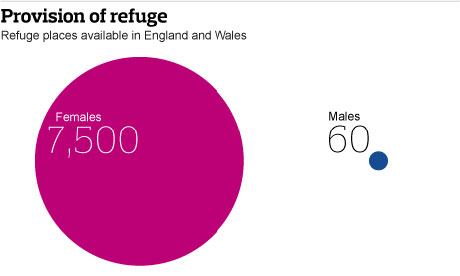
via The Guardian
That being said, the phrase “men’s rights” comes with its baggage and for very, very good reason. For one, there’s the spurious use of the “1 in 6 men” statistic to suggest gender parity in DV rates, as debunked earlier. Men’s rights advocates, including groups like the ManKind Initiative and Parity, don’t only want greater support for male victims but to “remove gender politics” from DV discourse and legislation altogether. They argue that male DV victims are afraid to speak up because they will be disbelieved or expected to simply “man up” — all of which are absolutely true. Why? Because of the patriarchy.
Non-feminist or gender-blind approaches don’t work to solve DV, because DV is not simply an issue of a handful of bad apples abusing their partners. It is a problem that is deeply rooted in the gendered ways in which power is structured in society, particularly in the construction of the home as a “private,” feminised sphere in which abusers get away with doing incredible amounts of violence because it’s “just a domestic.” It’s exactly this attitude — the patriarchal distinction between what’s worthy of public attention and what isn’t — that second-wave feminists set about deconstructing with the mantra “the personal is political.”
At the same time, women’s organisations are far from perfect too. While women’s groups rightly point to the success of BME-specific services (which are now under even greater threat of having their funding cut) as proof of the value of specialist care and support, the same movement which founded women’s refuges is also responsible for the TERFism that denies trans women access to shelters that they desperately need. Broken Rainbow, the UK’s only DV charity that caters specifically to LGBT people, estimates that up to 80% of trans people experience DV. The violence that trans people, women especially, face both at the hands of their partners and family members as well as the legal and charity systems that fail to acknowledge their existence or even blame them for the very problem they’re fleeing — based on an essentialist view of “maleness” and “male violence” — is gendered violence too, largely policed within “feminist” spaces.
Either way, both sides agree that DV victims need support that is as closely aligned to their specific circumstances as possible. The solution can’t be simply to turn women’s refuges into gender-neutral ones, just as how trans women would be very poorly served by shelters which allow them access in theory (often just to fulfill legal requirements) but fail to accommodate their specific needs in practice. All of this tells us that this goes way, way beyond a simplistic analysis of “men vs women.”
It’s Not Male Victims, It’s The Men In Parliament
By making this a (cis) men vs women issue, we’re overlooking groups that are even more vulnerable to DV: ethnic minorities, trans women, women with no recourse to public funds, teenagers and so on. By making this a men vs women issue, we’re pitting victims against each other for a limited amount of resources instead of asking why they’re fighting for scraps in the first place. We need more women’s services and we need more men’s services, and we need more gender-neutral services. We need more services for queer people. We need more services for non-English-speaking folk and we need more services for refugees and asylum seekers. We need more services, period.
The problem is not, as MRAs argue, that DV is “wrongly” characterised as a “feminist issue.” It is one. The problem is that as a feminist issue, it gets pigeonholed as a minority interest and gets nowhere near the attention it deserves. But it’s even more than that: DV is so pervasive that abusers are literally lawmakers. This isn’t a matter of Labour vs Conservative ideologies — like many feminist issues, DV disrupts what we understand to be “public” and “private” affairs, making lawmakers of all political stripes deeply uncomfortable in legislating on it.
Increasing the visibility of male victims of DV is important, but casting this as an issue in which the interests of male and female victims are diametrically opposed to each other is glossing over the complexity of the problem of and the highly varied circumstances of its victims. Very importantly, it’s absolving the men at the top of the hierarchy from responsibility. We need to stop pointing fingers at each other, and to turn our attention upwards instead.
Feature image via Shutterstock
40 LGBTQ-Friendly Picture Books for Ages 0-5
To care for small humans, all you have to do is keep them fed, watered, rested and equipped with the necessary cognitive and emotional skills to process the constant onslaught of heterosexist and cissexist messaging that assaults our senses every day. No big deal, right?
I was one of those kids who inhaled books growing up — as I suspect many of you were too — but now as an adult in bookstores and libraries I’m often exasperated at the options available to my younger siblings. There’s so much I want to share with them, and it’s rarely easy to figure out how.
Adults can debate endlessly about when it’s appropriate to “expose” children to “sensitive” topics like sex and sexuality, gender expression and diversity, non-conventional methods of conception and so on, but kids don’t live in isolated bubbles — they’re right here in our complex, messy world with us. And for many of us and the kids in our lives — queer kids, kids of queer parents, kids who don’t otherwise belong to heterosexual two-parent families, kids with other queer relations — these “sensitive topics” don’t just exist in the abstract: they’re our lives! We owe it to these kids to help them make as much sense of themselves, their families and our society as possible. That’s where these LGBTQ-friendly books come in.
From personal experience, most of these titles will likely be hard to find in store. Buying them on Amazon through the affiliate links in this post will give Autostraddle a small kickback (thank you!), but if you’d rather shop local, plenty of our Queer Girl City Guides will point you to your closest queer bookstore. Try requesting them at non-specialist bookstores, too, so that other kids might find them. Don’t have small humans of your own to shop for? Queer picture books make great gifts (the shopping process is far less anxiety-inducing than trying to find suitable clothes, I promise) or your community library might have some use for them.
10,000 Dresses
Written by Marcus Ewert / Illustrated by Rex Ray
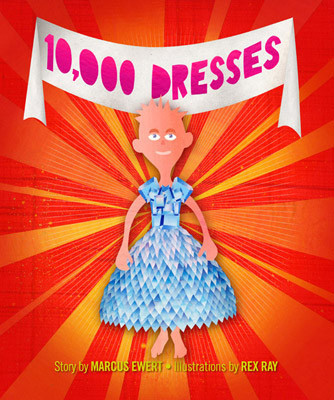
Every night, Bailey dreams about magical dresses: dresses made of crystals and rainbows, dresses made of flowers, dresses made of windows… Unfortunately, when Bailey’s awake, no one wants to hear about these beautiful dreams. Quite the contrary. “You’re a BOY!” Mother and Father tell Bailey. “You shouldn’t be thinking about dresses at all.” Then Bailey meets Laurel, an older girl who is touched and inspired by Bailey’s imagination and courage. In friendship, the two of them begin making dresses together. And Bailey’s dreams come true!
A is for Activist
Written and illustrated by Innosanto Nagara
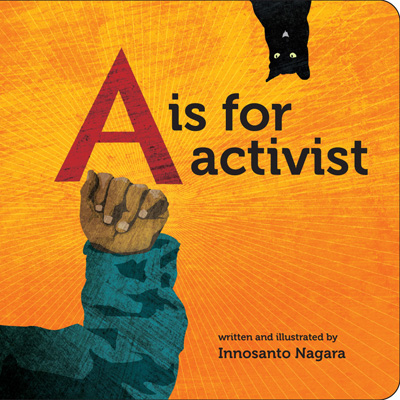
A is for Activist is an ABC board book written and illustrated for the next generation of progressives: families who want their kids to grow up in a space that is unapologetic about activism, environmental justice, civil rights, LGBTQ rights, and everything else that activists believe in and fight for.
ABC: A Family Alphabet Book
Written by Bobbie Combs / Illustrated by Brian and Desiree Rappa
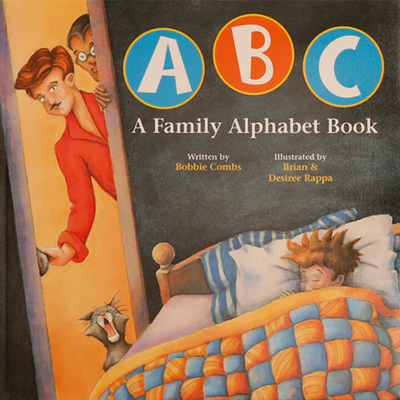
Have fun with the kids, moms, dads and pets in this delightful book that celebrates LGBTQ families as it teaches young children the alphabet.
The Adventures of Tulip, Birthday Wish Fairy
Written by S. Bear Bergman / Illustrated by Suzy Malik
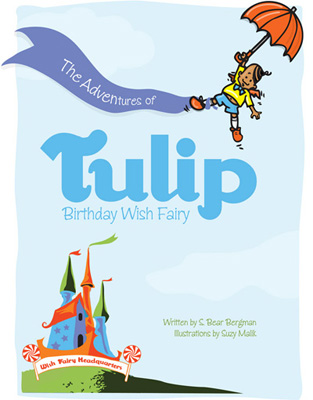
Tulip deals with the birthday wishes of all the nine-year-olds in North America. When a wish Tulip is unfamiliar with crosses his desk, from a child known as David who wishes to live as Daniela, he seeks the wise counsel of the Wish Fairy Captain and learns some new Wish Fairy Skills. Tulip gets in a little hot water, but ultimately his compassion and thoughtfulness win the day.
And Tango Makes Three
Written by Justin Richardson and Peter Parnell / Illustrated by Henry Cole
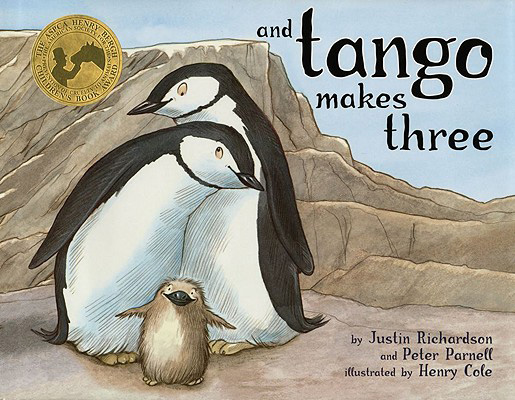
In the zoo there are all kinds of animal families. But Tango’s family is not like any of the others. This illustrated children’s book fictionalizes the true story of two male penguins who become partners and raised a penguin chick in the Central Park Zoo.
And Tango Makes Three is one of the most challenged books in the US. In a recent incident that was pretty much internationally recognised as a gross move, the book was taken off the shelves — and slated to be pulped, lest its dangerous content fall into the wrong hands — by Singapore’s National Library Board together with The White Swan Express: A Story About Adoption and Who’s In My Family: All About Our Families. Following public outrage, two of the books were later returned… to the adults’ section.
Roy and Silo aren’t the only same-sex penguin couples in the Central Park Zoo (just the most popular ones) and Tango later paired with another female penguin herself. However, the male penguins were eventually kicked out of their nest and split up, with Silo taking up with a female penguin named Scrappy and Roy joining a group of unattached males. Anti-gay crusaders would have parents tell their children the “truth” after reading this book and I wholeheartedly agree — not as a cautionary tale, but a wonderfully queer illustration of mutable sexualities and evolving relationships.
Backwards Day
Written by S. Bear Bergman / Illustrated by KD Diamond
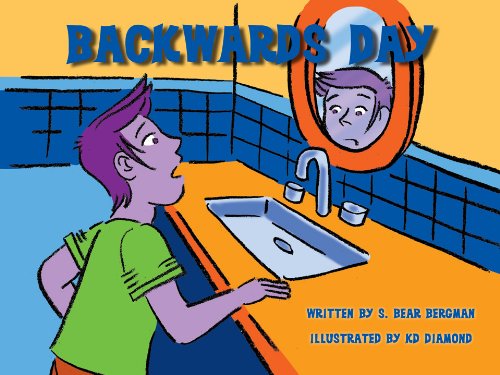
Backwards Day, set on the planet Tenalp, introduces us to a world where there are seventeen seasons, including one where bubblegum falls from the sky for three days and a single day when everything — everything everywhere — is backwards. Andrea looks eagerly forward to Backwards Day every year, so she can turn into a boy for the day. But one year she doesn’t turn along with everyone else. She’s miserable. The very next day, however, she turns into a boy — and stays that way! He’s delighted, but his parents are distressed, and take him to the big city to consult with Backwardsologists.
Be Who You Are
Written by Jennifer Carr / Illustrated by Ben Ruhback
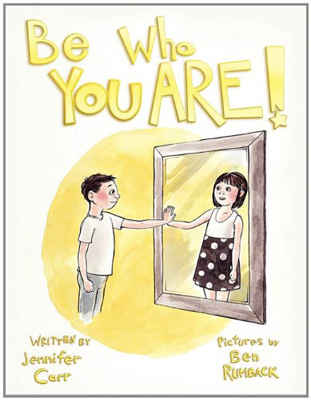
Based on the author’s experiences with her own children, this book traces the story of a young trans girl and her family. Born “Nick,” Hope’s family supports her when she says she no longer wants to be called a boy or dress like a boy. Her parents find a group for families like theirs.
The Boy Who Cried Fabulous
Written by Lesléa Newman / Illustrated by Peter Ferguson
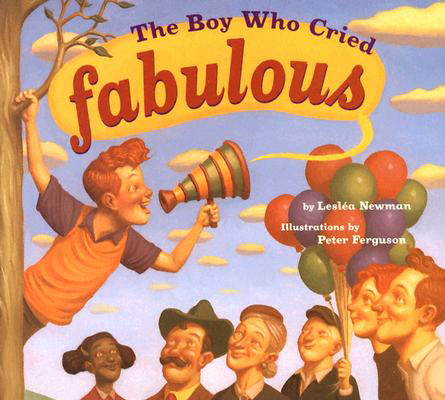
The only thing Roger likes better than exploring the world around him is describing it. And Roger describes most things as fabulous! But his parents have a different view. They want Roger to see things the way they do, so they ban “fabulous” from his vocabulary. Fabulously illustrated by Peter Ferguson, this cheerful tale will have children rejoicing along with Roger at all the fabulous — no, marvelous! no, dazzling! — things that await him when he steps outside.
This book has plenty of repetition, so it’s great read out loud in class. What could be more fabulous than a group of smalls yelling “fabulous”?
Daddy’s Roommate
Written and illustrated by Michael Willhoite
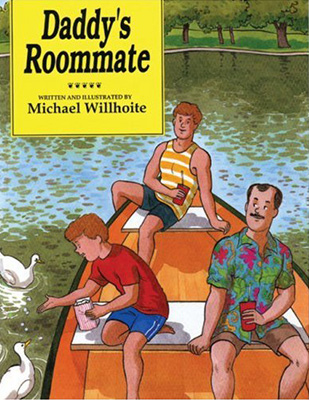
This story’s narrator begins with his parent’s divorce and continues with the arrival of “someone new at Daddy’s house.” The new arrival is male. This new concept is explained to the child as “just one more kind of love.”
Reviews warn that the characterisation of the couple in this book might be a little dated, but it’s still worth looking out for as one of the first few out there (it was published in 1991) to portray a same-sex couple in a positive light.
The Different Dragon
Written by Jennifer Bryan / Illustrated by Danamarle Hosler
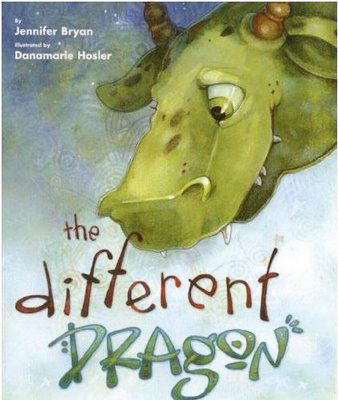
This bedtime story about bedtime stories shows how the wonderful curiosity and care of a little boy, with some help from one of his moms, can lead to magical and unexpected places. Join Noah and his cat, Diva, on this nighttime adventure and you too will leave with an unforgettable new dragon friend!
Everywhere Babies
Written by Susan Meyers / Illustrated by Marla Frazee
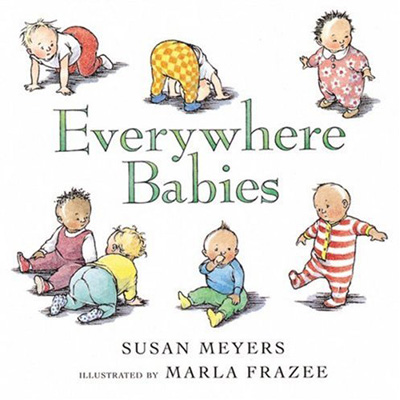
Every day, everywhere, babies are born. They’re kissed and dressed and rocked and fed — and completely adored by the families who love them. With an irresistible rhyming text and delightfully endearing illustrations, here is an exuberant celebration of playing, sleeping, crawling, and of course, very noisy babies doing all the wonderful things babies do best.
This board book has gotten considerable flak for its (very, very subtle) “homosexual depictions” of babies being — unthinkably! — cuddled by same-sex couples, so it’s safe to say you’ll probably love it. With a little luck, it might also be more easily inserted into the libraries of your more conservative relations than some of the other books on this list.
Felicia’s Favorite Story
Written by Lesléa Newman / Illustrated by Adriana Romo

It’s bedtime, but before Felicia goes to sleep she wants to hear her favorite story, the story of how she was adopted by Mama Nessa and Mama Linda. And so Felicia’s parents tell her how they flew off in a big silver airplane to meet the baby girl who was waiting for them, and how they loved her from the very first moment they saw her.
Goblinheart: A Fairy Tale
Written by Brett Axel / Illustrated by Terra Bidlespacher
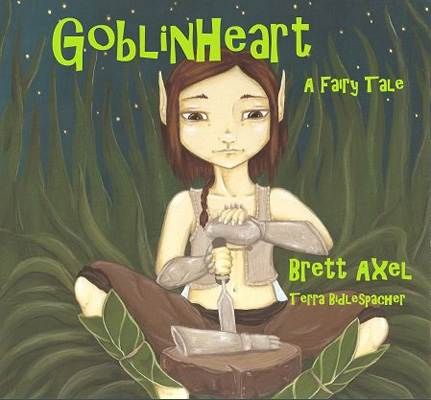
Using “fairy” and “goblin” in lieu of female and male, the author has created a timely allegorical fairy tale. A youngster named Julep, who lives in a forest tribe, insists on growing up to be a goblin rather than a fairy. The tribe learns to accept that Julep is a goblin at heart, eventually coming around to support the physical transition that must be made for Julep to live as a goblin.
The Great Big Book of Families
Written by Mary Hoffman / Illustrated by Ros Asquith

This fun and fascinating treasury features all kinds of families and their lives together. Each spread showcases one aspect of home life-from houses and holidays, to schools and pets, to feelings and family trees. Ros Asquith’s humorous illustrations perfectly complement a charming text from the acclaimed Mary Hoffman; kids will love poring over these pages again and again. A celebration of the diverse fabric of kith and kin the world over, The Great Big Book of Families is a great big treat for every family to share.
When I first stumbled upon the wonder of London’s Gay’s the Word bookstore, this was the first book I bought for my then 6-year-old brother. Not (only) for the queer content, but because it was the only book on the shelves that had a hijabi mother on the cover. Can’t recommend it enough.
Heather Has Two Mommies
Written by Lesléa Newman / Illustrated by Diana Souza
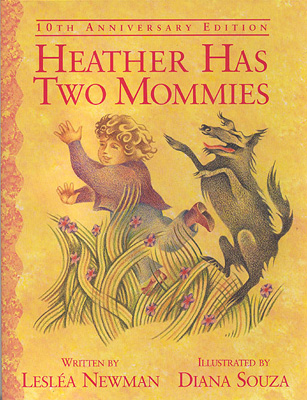
This minor classic presents the story of Heather, a preschooler with two moms who discovers that some of her friends have very different sorts of families. Juan, for example, has a mommy and a daddy and a big brother named Carlos. Miriam has a mommy and a baby sister. And Joshua has a mommy, a daddy, and a stepdaddy. Their teacher Molly encourages the children to draw pictures of their families, and reassures them that “each family is special” and that “the most important thing about a family is that all the people in it love each other.”
In Our Mothers’ House
Written by Patricia Polacco
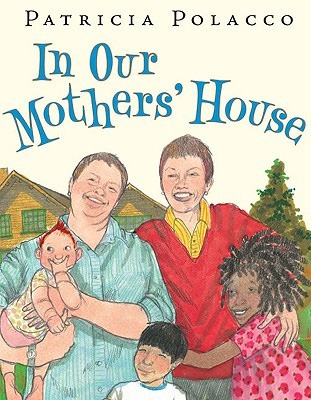
Marmee, Meema, and the kids are just like any other family on the block. In their beautiful house, they cook dinner together, they laugh together, and they dance together. But some of the other families don’t accept them. They say they are different. How can a family have two moms and no dad? But Marmee and Meema’s house is full of love. And they teach their children that different doesn’t mean wrong. And no matter how many moms or dads they have, they are everything a family is meant to be. Here is a true Polacco story of a family, living by their own rules, and the strength they gain by the love they feel.
It’s NOT the Stork!: A Book About Girls, Boys, Babies, Bodies, Families, and Friends
Written by Robie H. Harris / Illustrated by Michael Emberley
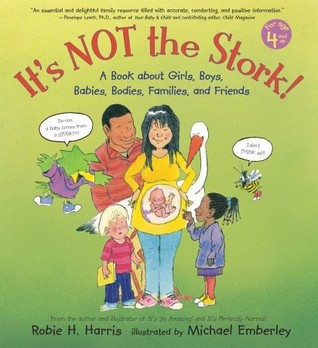
Young children are curious about almost everything, especially their bodies. And young children are not afraid to ask questions. What makes me a girl? What makes me a boy? Why are some parts of girls’ and boys’ bodies the same and why are some parts different? How was I made? Where do babies come from? Is it true that a stork brings babies to mommies and daddies? It’s Not the Stork! helps answer these endless and perfectly normal questions that preschool, kindergarten, and early elementary school children ask about how they began.
It’s Okay to Be Different
Written by Todd Parr
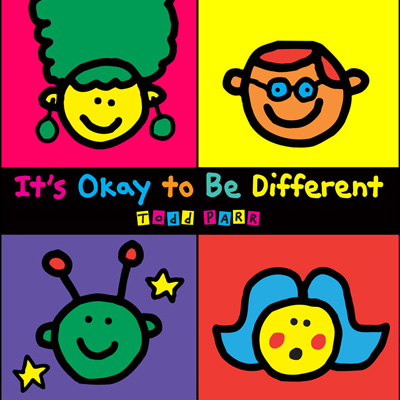
It’s okay to be a different color. It’s okay to dance by yourself. It’s okay to wear glasses. It’s okay to have a pet worm…. It’s okay to be different!
Jacob’s New Dress
Written by Sarah and Ian Hoffman / Illustrated by Chris Case
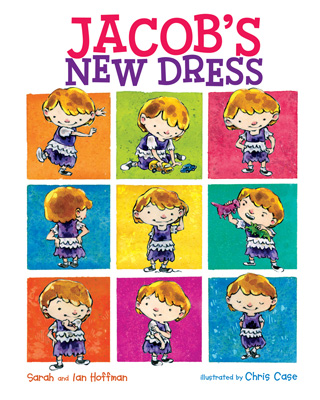
Jacob loves playing dress-up, when he can be anything he wants to be. Some kids at school say he can’t wear “girl” clothes, but Jacob wants to wear a dress to school. Can he convince his parents to let him wear what he wants?
King and King
Written by Linda de Haan and Stern Nijland
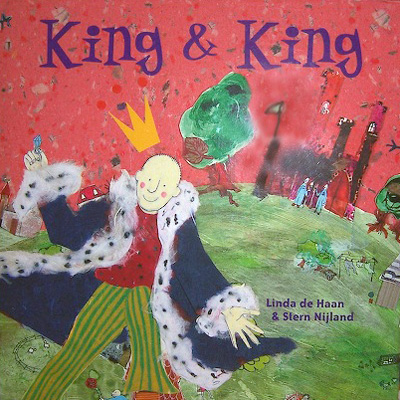
Once there lived a lovelorn prince whose mother decreed that he must marry by the end of the summer. So began the search to find the prince’s perfect match and lo and behold… his name was Lee. You are cordially invited to join the merriest, most unexpected wedding of the year.
King and King and Family
Written by Linda de Haan and Stern Nijland
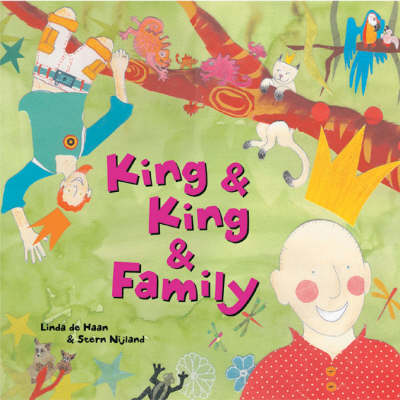
Join newlyweds King Lee and King Bertie on their journey into the noisy jungle. The kings are greeted by wild animal families, but the royal travelers suspect that something more significant awaits them in the trees. King & King soon discover that there’s no adventure more wonderful than starting a family of their own.
Love is a Family
Written by Roma Downey / Illustrated by Justine Gasquet
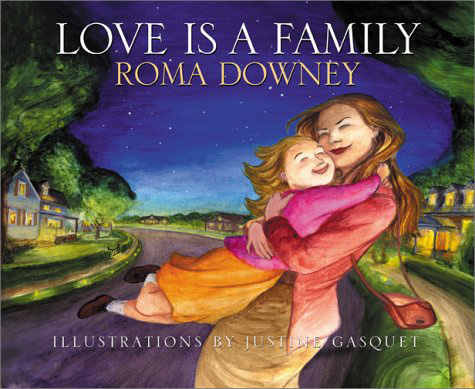
Irrepressible young Lily loves her mother dearly. But when it’s time for Family Fun Night at her school, she worries… and worries. What will the other kids think when she just brings her mother? Will they be the strangest family there? But when they arrive at Family Fun Night, Lily sees all her friends having fun with their families — of every shape, size, and color. She learns that there are as many ways of showing love as there are stars in the sky.
Mister Seahorse
Written and illustrated by Eric Carle
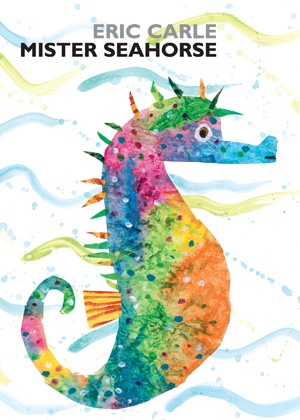
When Mrs. Seahorse lays her eggs, she does it on Mr. Seahorse’s belly! She knows he will take good care of them. While he swims waiting for the eggs to hatch, he meets other underwater fathers caring for their babies.
Molly’s Family
Written by Nancy Garden / Illustrated by Sharon Wooding
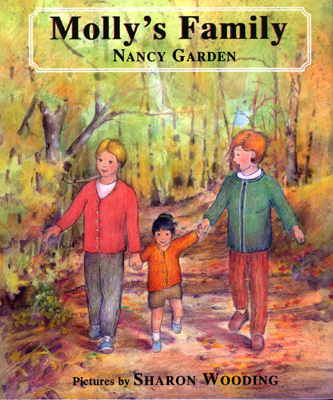
The members of Ms. Marston’s kindergarten class are cleaning and decorating their room for the upcoming Open School Night. Molly and Tommy work on drawing pictures to put on the walls. Molly draws her family: Mommy, Mama Lu, and her puppy, Sam. But when Tommy looks at her picture, he tells her it’s not of a family. “You can’t have a mommy and a mama,” he says. Molly doesn’t know what to think; no one else in her class has two mothers. She isn’t sure she wants her picture to be on the wall for Open School Night.
Mommy, Mama and Me
Written by Lesléa Newman / Illustrated by Carol Thompson
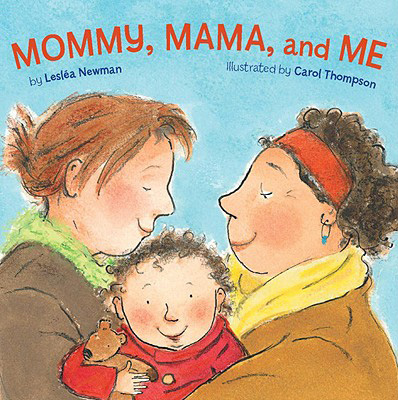
Rhythmic text and illustrations with universal appeal show a toddler spending the day with its mommies. From hide-and-seek to dress-up, then bath time and a kiss goodnight, there’s no limit to what a loving family can do together.
Monday is One Day
Written by Arthur Levine / Illustrated by Julian Hector
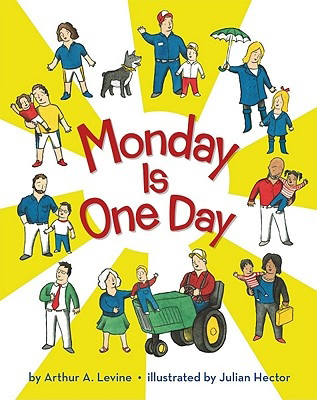
A love note from a working parent to a child, counting the days of the week — each one a special opportunity to spend time together. One by one, the days of the week roll by. Monday is one day, Tuesday is blue shoes day, and Wednesday is halfway day. When Saturday and Sunday finally come, it’s time for little ones and the adults who love them to play, share, and celebrate. Every day of the week offers a special opportunity for families to enjoy being together!
My Princess Boy
Written by Cheryl Kilodavis / Illustrated by Suzanne DeSimone

Dyson loves pink, sparkly things. Sometimes he wears dresses. Sometimes he wears jeans. He likes to wear his princess tiara, even when climbing trees. He’s a Princess Boy.
Oliver Button is a Sissy
Written and illustrated by Tomie dePaola

A little boy must come to terms with being teased and ostracized because he’d rather read books, paint pictures, and tap-dance than participate in sports.
The Princess Knight
Written by Cornelia Funke / Illustrated by Kerstin Meyer
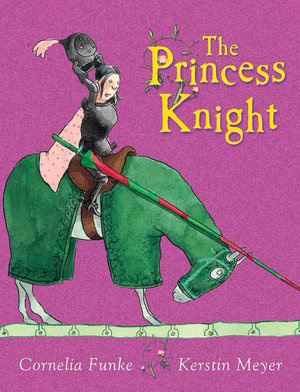
Violet is a young princess who wishes she could show the world that she is just as brave and strong as her brothers. But her strict father insists that she get married, and her brothers only mock her when she wants to be included in their fun. So Violet decides to use her intelligence and bravery to show everyone — once and for all — what she’s made of. Disguising herself as a boy, Violet takes part in a knights’ jousting tournament. When she wins the contest, she reveals her true identity — and wins the prize of freedom!
Rough, Tough Charley
Written by Verla Kay / Illustrated by Adam Gustavson
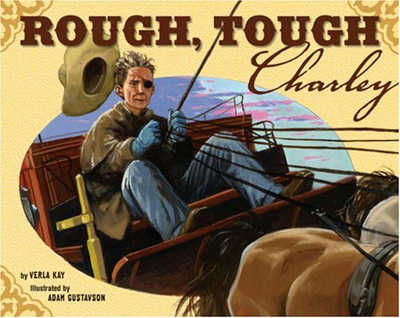
Charley was rough. Charley was tough. Charley wore fancy blue gloves. Charley Parkhurst always was more comfortable around horses than around humans. One of the most respected stagecoach drivers in the old West, Charley also kept one of the biggest secrets anyone could keep.
The Sissy Duckling
Written by Harvey Fierstein / Illustrated by Henry Cole
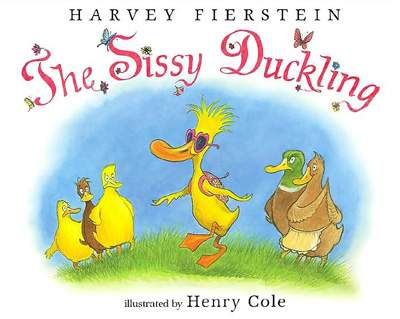
Elmer is not like the other boy ducklings. While they like to build forts, he loves to bake cakes. While they like to play baseball, he wants to put on the halftime show. Elmer is a great big sissy. But when his father is wounded by a hunter’s shot, Elmer proves that the biggest sissy can also be the greatest hero.
Too Far Away to Touch
Written by Lesléa Newman / Illustrated by Catherine Stock

Zoe’s Uncle Leonard makes her feel special, taking her out to lunch and star-filled afternoons at the Planetarium. Though ill and always tired, he surprises her by decorating the ceiling in her room with hundreds of glow-in-the-dark stars. Uncle Leonard can’t promise Zoe when or if he will ever get well, but he reassures her he will always love her and, like the stars, be “close enough to see.”
This book specifically deals with AIDS, but would be appropriate for any child coming to terms with terminal illness or the death of a loved one.
What Makes A Baby
Written by Cory Silverberg / Illustrated by Fiona Smyth
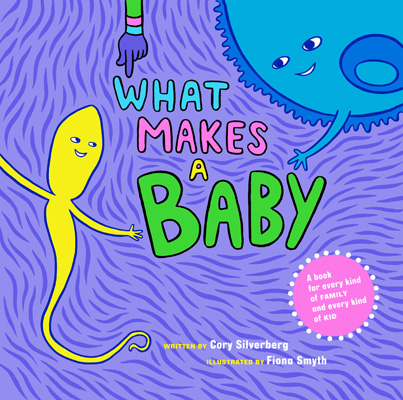
What Makes a Baby is a book for every kind of family and every kind of kid. It is a twenty-first century children’s picture book about conception, gestation, and birth, which reflects the reality of our modern time by being inclusive of all kinds of kids, adults, and families, regardless of how many people were involved, their orientation, gender and other identity, or family composition. Just as important, the story doesn’t gender people or body parts, so most parents and families will find that it leaves room for them to educate their child without having to erase their own experience.
In 2012, the Kickstarter project to publish this book raised almost 7 times its target amount. I own it and can verify that it is by far the most inclusive, approachable and beautifully illustrated book I’ve come across explaining the fundamentals of baby-making. And it made Ali cry.
When Kayla Was Kyle
Written by Amy Fabrikant / Illustrated by Jennifer Levine
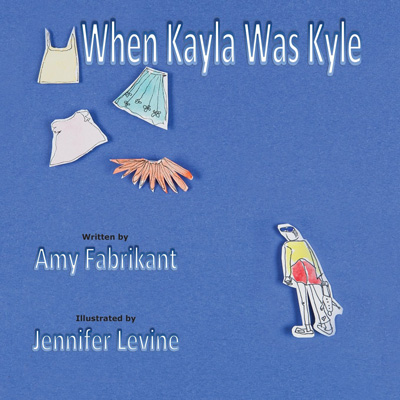
Kyle doesn’t understand why the other kids at school call him names. He looks like other boys, but doesn’t feel like them. Can Kyle find the words to share his feelings about his gender — and can his parents help him to transition into the girl he was born to be?
The White Swan Express: A Story About Adoption
Written by Elaine M. Aoki and Jean Davies Okimoto / Illustrated by Meilo So

In China, the moon shines on four baby girls, fast asleep in an orphanage. Far away in North America, the sun rises over four homes as the people who live there get ready to start a long, exciting journey. This lovely story of people who travel to China to be united with their daughters describes the adoption process step by step and the anxiety, suspense, and delight of becoming a family.
Who’s in a Family?: A Book About All Types of Families
Written by Robert Skutch / Illustrated by Laura Nienhaus
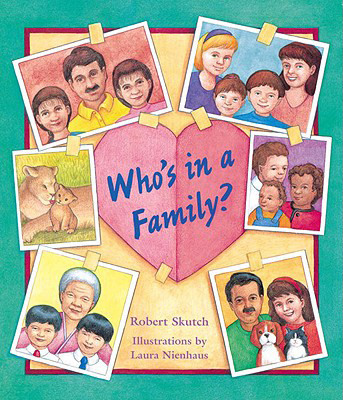
Family is important, but who’s in a family? Why, the people who love you the most!
Why Don’t I Have A Daddy?: A Story of Donor Conception
Written by George Anne Clay / Illustrated by Lisa Krebs

As the little lion cub notices all different types of families, he starts to question his own family. His family consists of his mother and him. The little cub learns that while there is no “daddy” in his family, there is a donor lion who made his life possible. Through his mother’s love and nurturing, the lion cub understands how special he and his family are.
William’s Doll
Written by Charlotte Zolotow / Illustrated by William Pene du Bois
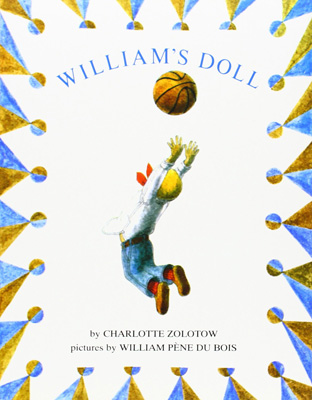
More than anything, William wants a doll. “Don’t be a creep,” says his brother. “Sissy, sissy,” chants the boy next door. Then one day someone really understands William’s wish, and makes it easy for others to understand, too.
The Worst Princess
Written by Anna Kemp / Illustrated by Sara Ogilvie
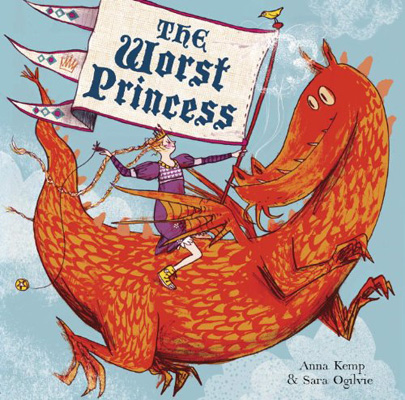
Princess Sue dreams of finding her Prince Charming. But when that Prince proves to be a bit more traditional than what she had hoped for, Princess Sue — along with the help of a fiery dragon — becomes determined to find a way to get the fairy-tale ending that she always envisioned for herself.
At one point Princess Sue looks like she’s about to trample the Prince while on her dragon, having bested him in a joust. MISANDRY IS REAL.
Zinnia and Dot
Written by Lisa Campbell Ernst
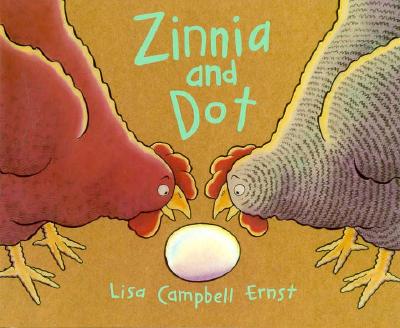
Meet Zinnia and Dot — two plump, self-satisfied hens who bicker constantly about the quality of their eggs. Whose are more lustrous, shapely, smooth? Their rivalry rages until a weasel bursts in and steals the eggs —all but one, a particularly prime specimen. Just in time, they realize they’ve got to stick together to protect their prized egg.
It was, unsurprisingly, pretty hard to find books that featured queer people or families of colour. However, you might be interested in the Flamingo Rampant Book Club!, a soon-to-be-launched children’s book series which aims to celebrate LGBTQ2S kids, families and adults, moving away from the dominant narratives of struggle, oppression and bullying, as well as to centre the stories and writing of people of colour. Creator S. Bear Bergman (author of The Adventures of Tulip, Birthday Wish Fairy and Backwards Day, both of which are listed above, as well as co-author of Gender Outlaws: The Next Generation) is currently seeking funding on Kickstarter, while Miriam Zoila Pérez of Colorlines has written a more in-depth piece about the series exploring related issues of marketability, how racism is portrayed (or sidestepped) in children’s books, and the portrayal of girls of colour.
This list was put together with the help of Pooja Makhijani, a writer, editor, teacher, book artist, mother, and New Yorker living in Singapore. Check out her blog and latest initiative, The Feminist Parent.

